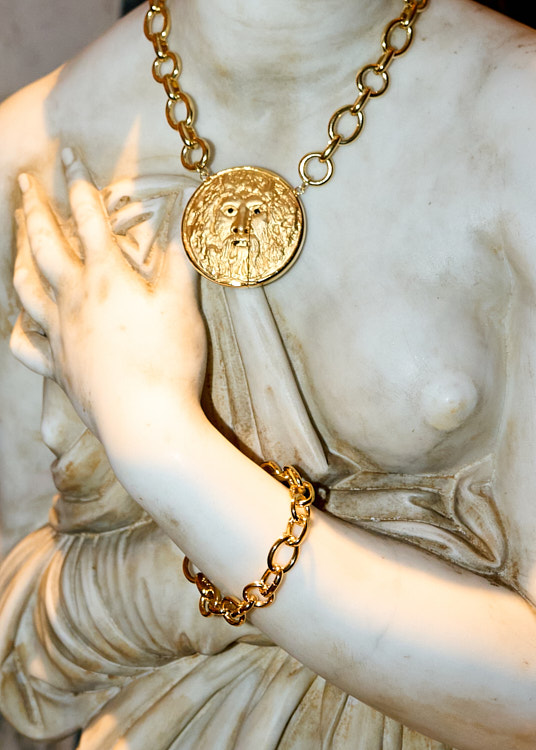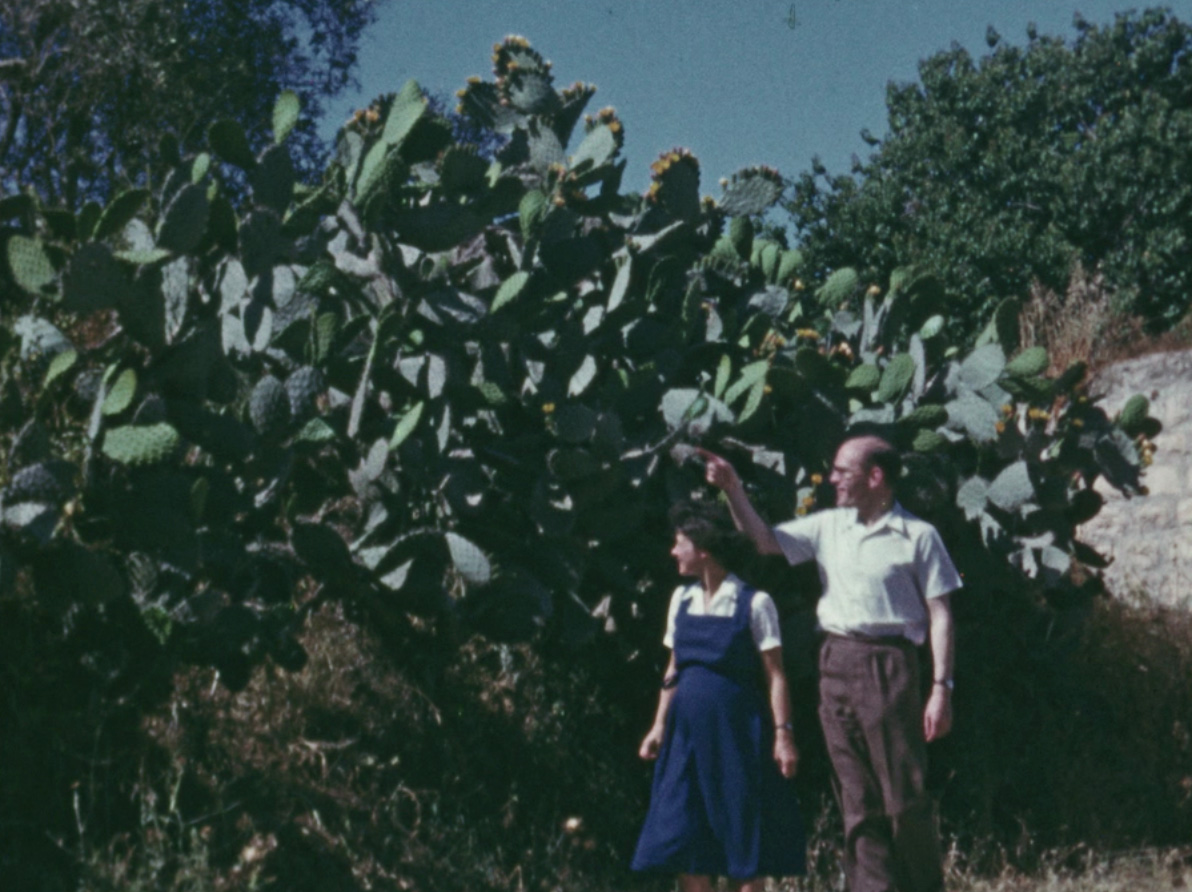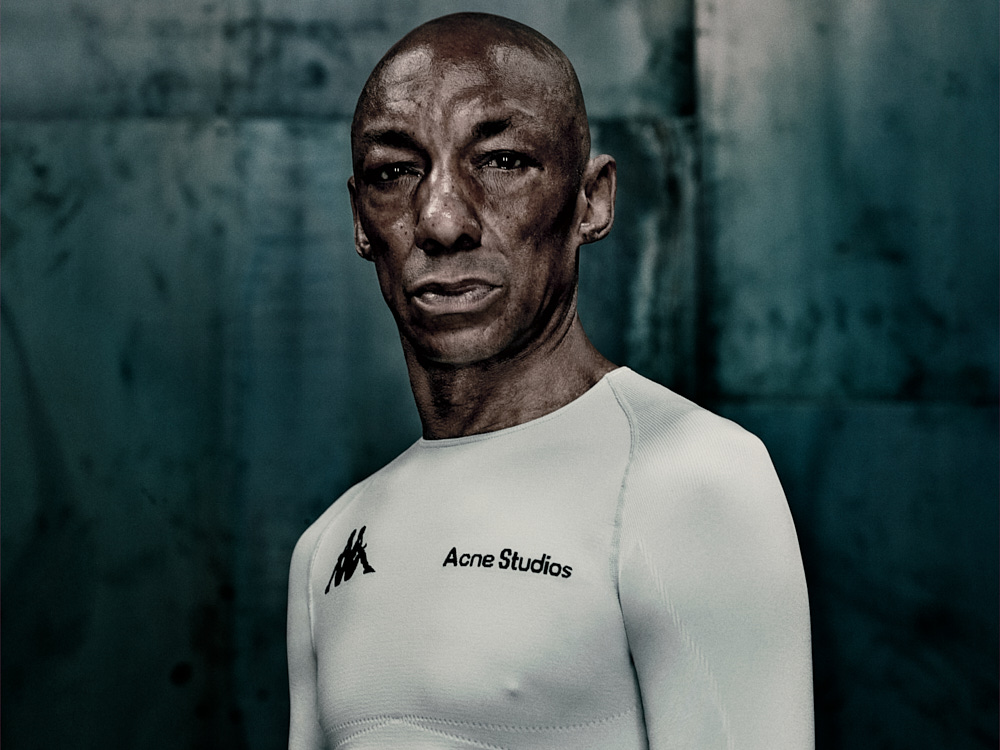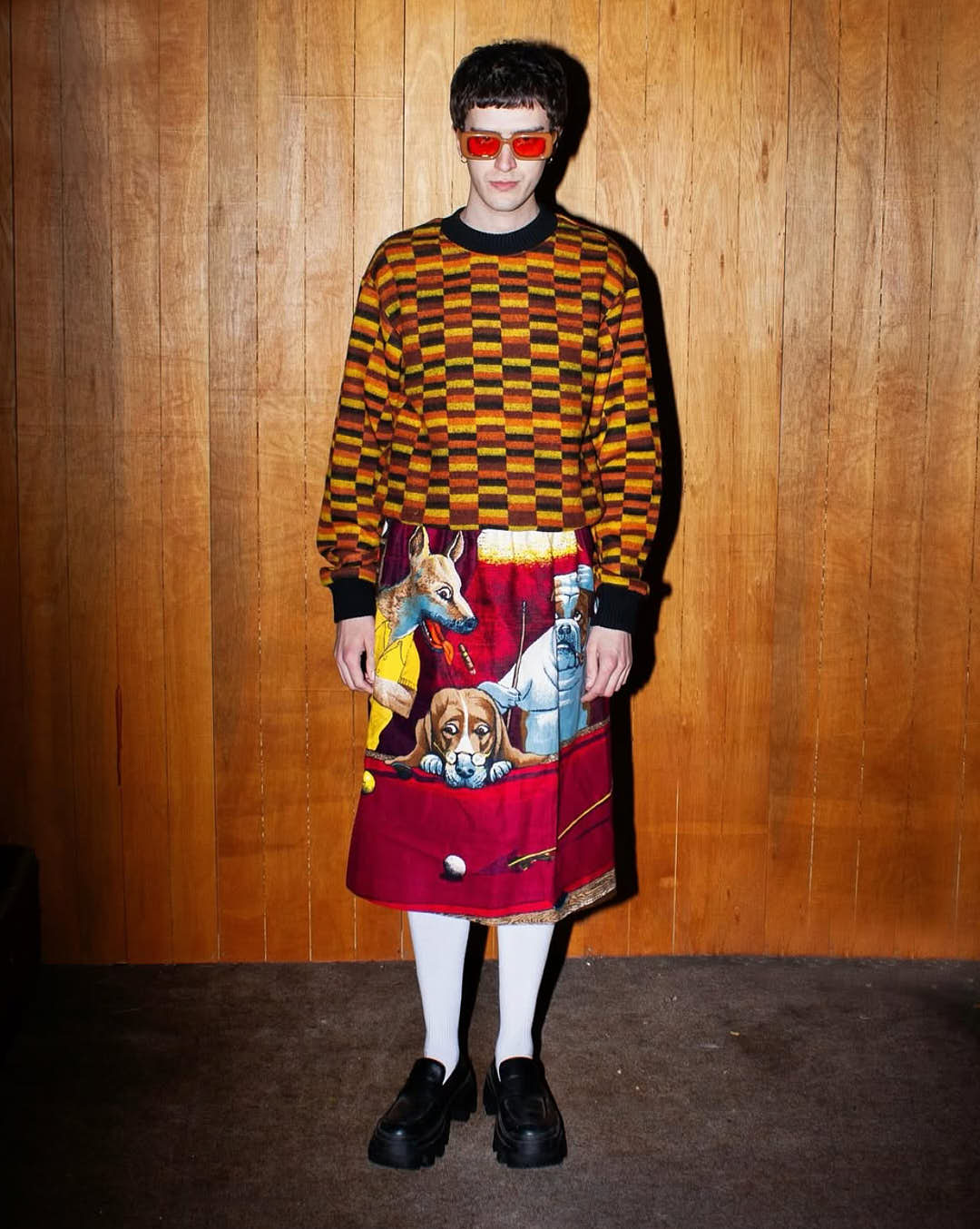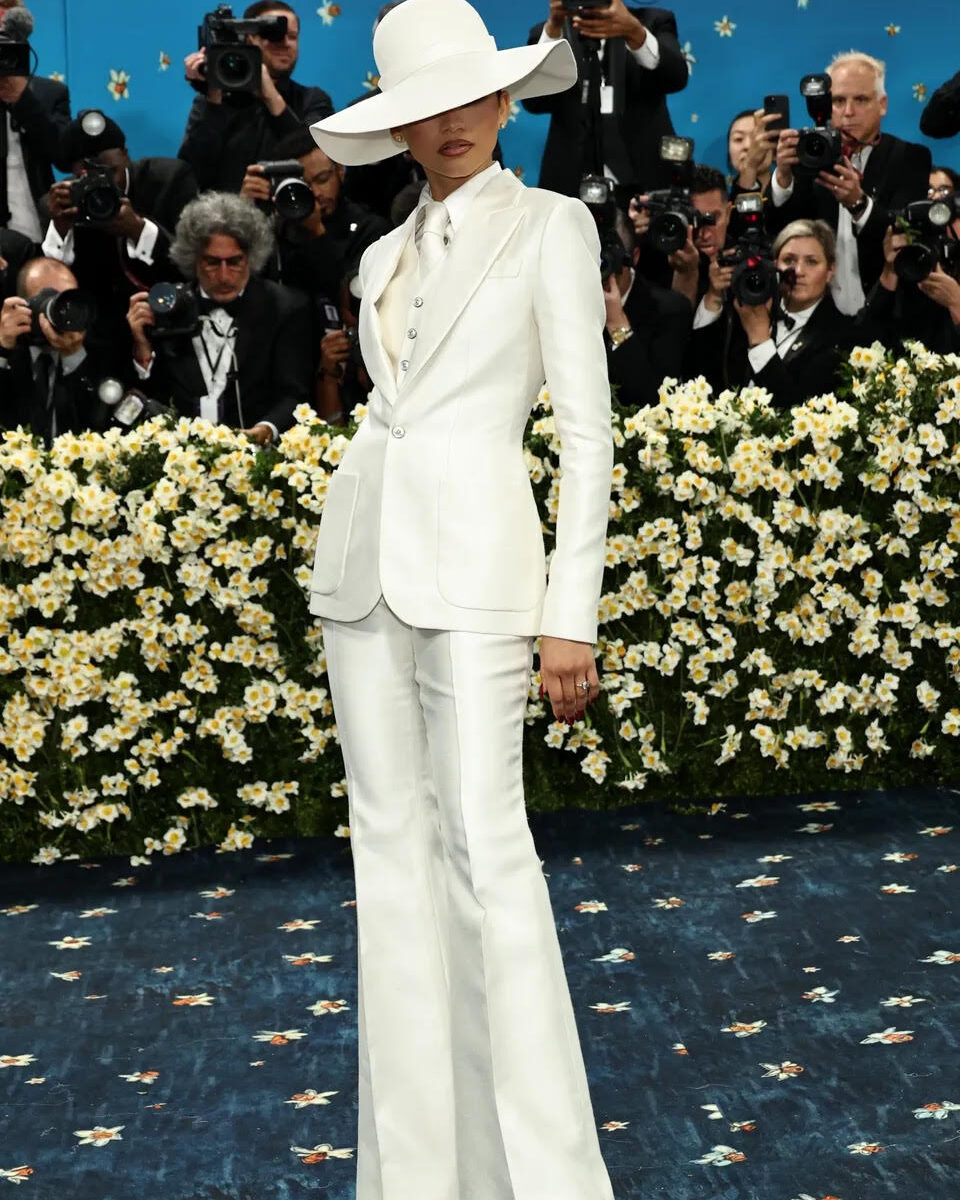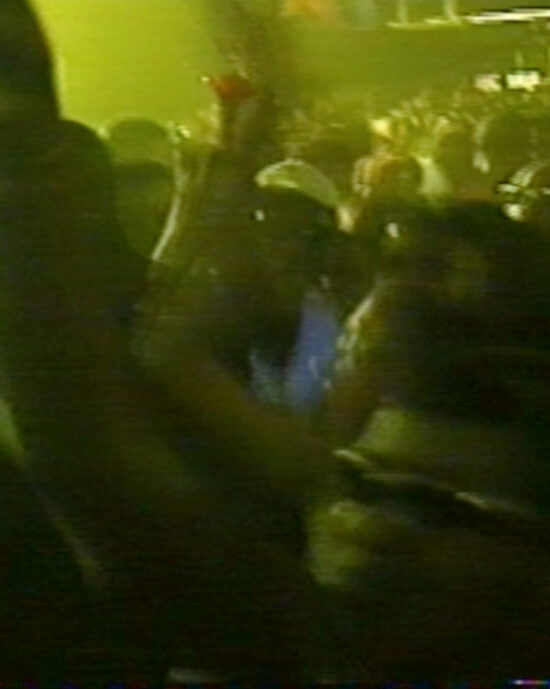
Fashion’s Next Gen: Meet the Student Designers Behind IFM’s AW25 Master of Arts Show
Written by Jude Jones
Paris Fashion Week AW25 began with a premonition. A premonition of fashion’s future, sure, presented by 26 student designers from the Institut Français de la Mode’s (IFM) Master of Arts in Fashion Design and Knitwear course. But also a political premonition, one at recalcitrant odds with today’s churlish and hostile politics, one swaddled and sewn in an ethos of care, radicality, hope, and joy.
Taking for inspiration an eclectic cornucopia of historical, political, and social references – the AIDS activism of the 1980s to the ascendance of artificial intelligence and “Big Tech”; the private histories of Icelandic women to the underground clubs of contemporary Copenhagen – IFM’s Master of Arts show, one of its strongest in recent memory, was a true mezze platter of messages and allusions, stories and desires, all presented from the mouths, hands, and souls of Paris’s cosmopolitan youth, of fashion’s next gen.
Steven Chevallier, “Out Rage”




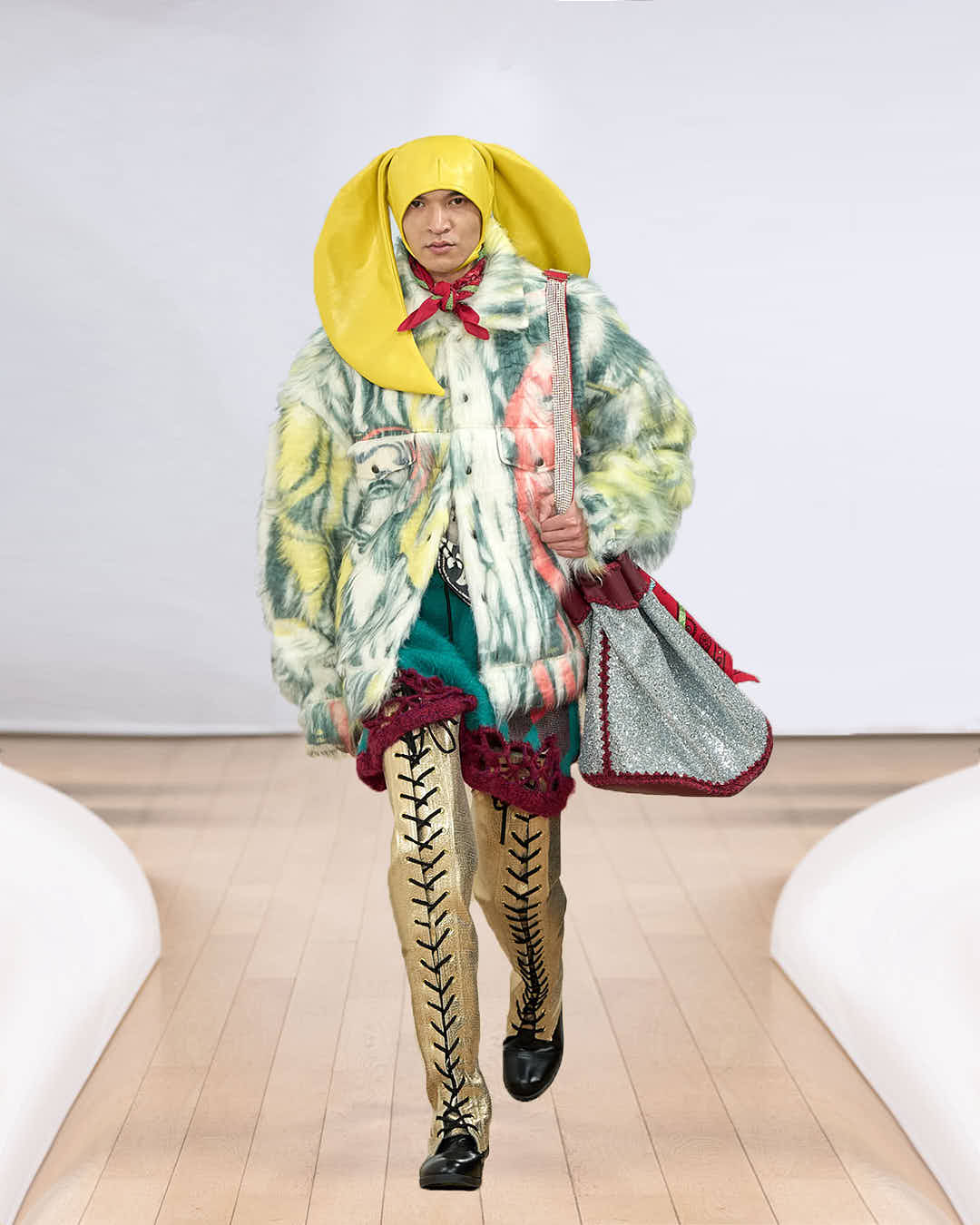

Designs by @stwzd, photographs by Alessandro Lucioni.
Describe your collection in a few (buzz)words.
Steven Chevallier (SC): QUEER / FURRY / STONEWALL / KNIT / TRIBUTE / FUN / COLOURS / HOPE
Tell us more!
SC: Society and the streets have a profound influence on both my work and personal life. We are currently facing an intense social climate marked by war, protests, and the rise of conservative politics. I stay closely connected to what’s happening in my country [France], keeping up to date as much as possible. The political tension, protests, and the anger of young people fighting for their freedom deeply inspire me.
My collection explores the historical persecution of the queer community by conservative movements, focusing on current and historical events like the 1980s HIV crisis, the Stonewall riots, and the work of Derek Jarman. Researching for my collection during a time of rising conservatism in France, I was inspired by protests in Paris and began exploring how these movements target marginalized communities.
The 80’s HIV crisis particularly stood out, with its stigma fuelled by media and medical narratives linking the disease to gay and bisexual men, worsening discrimination. I wanted to honour and celebrate those who have fought and continue to fight for queer rights and pay tribute to the future generation of queer people. I believe this is a fight that will always be relevant, and that nothing is guaranteed, especially right now. I want to tell the younger generation to stay strong, and that we will fight together against the conservatives.
What was it like bringing this collection to life?
SC: My process is obviously focused on knitwear. I paid homage to queer activism through the logos and campaigns inspired by activist movements from the 80s, such as ACT UP and OutRage. I also love to paint, and colour is a very important part of my expression. I translated this into my knitwear work, using the industrial knitting machine (from the IFM studio) that we learned to program.
As an eclectic person, styling and accessories are really important to me and they help me express my ideas. The design of these elements was a key part of my work. For example, all the hats with animal ears reference the Middle Ages, a time when so-called “crazy” people would wear animal hats. For me, this represents how queer people are often labelled as “crazy”. That’s why my hats feature animal elements.
What’s next for you?
SC: I’m start my internship in April at Dior, in the menswear knitwear team. After that, I will explore the job opportunities available, though I know this is a challenging industry. What I’m sure of is that I’ve had an amazing time during this master’s program. I had the chance to fully explore my creativity and to deliver an important political message, which is deeply meaningful to me especially considering what’s happening in the world today. As designers, I believe we have a responsibility to engage with the harm that society can inflict, particularly on our rights as queer creatives. I hope to continue working in this direction, connecting creativity, craftsmanship, and activism together.
If you could go back to the start of your MA and give yourself one bit of advice now, what would it be?
SC: To be honest, I waited two years between my BA and my Master’s and I really recommend people take that time. Working in the industry for a bit helps you learn a different side of design, and you go back to school with a more mature approach. And of course, I recommend being as creative as possible and trying to have fun too, because it’s the moment when you can develop a collection that’s 100% true to who you are.
Hawi Akrawi, “Muttersöhnchen”

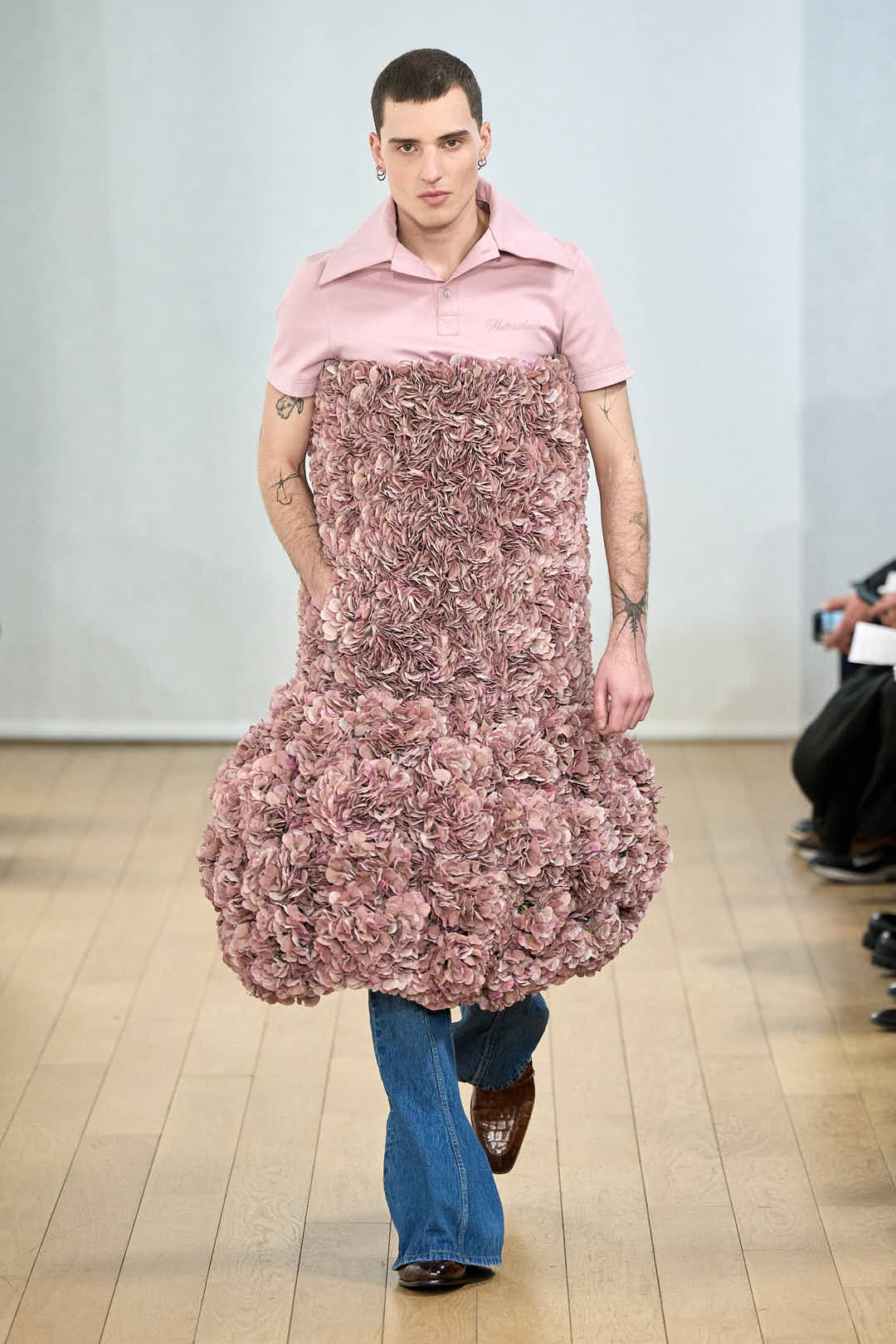




Designs by @hawiakrawi, photographs by Alessandro Lucioni.
Describe your collection in a few (buzz)words.
Hawi Akrawi (HA): My collection “Muttersöhnchen” (“mommy’s boy”) is about reclaiming this pejorative German term into a beautiful context and being able to loudly and proudly saying that I am a mommy’s boy.
Tell us more!
HA: “Muttersöhnchen” celebrates the nurturing bond between mother and son, challenging stereotypes that hinder men from expressing emotion and vulnerability. It is also an homage to my mother, blending her anti-fashion Baltic German wardrobe with shiny, sparkly and floral textiles, inspired by her Kurdish dresses to create a dialogue between her past and our present, honouring her resilience and adaption. The innocent garment shapes and dynamic breaks are inspired by traditional wooden toys, whilst the attitude and hand of the clothes draw from the colourful, collapsing sculptures of Angela de la Cruz. “Muttersöhnchen” creates a warm, intimate space for connection and care, contrasting today’s increasingly cold, hatred world.
I also want to add that this is a Menswear Collection. I’ve already gotten a lot questions by industry professionals asking if it’s gender fluid or an unisex collection. But no. It’s very counterproductive to blur the lines here in terms of definition and language. I designed this collection out of my reality as a cis-male and I am trying to deconstruct and challenge this reality, but this only works if I define my collection clearly and loudly as a serious and believable menswear. It’s the very bare minimum to challenge the stereotypes and gender, especially if we are designing for men or around a male read body. This is the responsibility we hold as a new generation of designers and all of this should be obvious.
What was it like bringing this collection to life?
HA: Working on this collection and bringing it to life was really a matter of heart and it felt so natural and easy somehow. It made me feel even closer to my mother – both by reflecting on her life and what she sacrificed for my siblings and me, I felt like the first time I could give her something back, and by analysing her wardrobe and the way she dresses. It’s really anti-materialistic and anti-fashion, and I found such a beauty and understanding in it.
What’s next for you?
HA: I am currently looking for a six-month internship within the academic schedule of IFM, but I’m definitely going to stay in Paris.
If you could go back to the start of your MA and give yourself one bit of advice now, what would it be?
HA: Don’t make things too complicated. Oh, and good food and eating habits really really influence the outcome of your work in a positive way!
Reece Liang, “Faux Narrative”
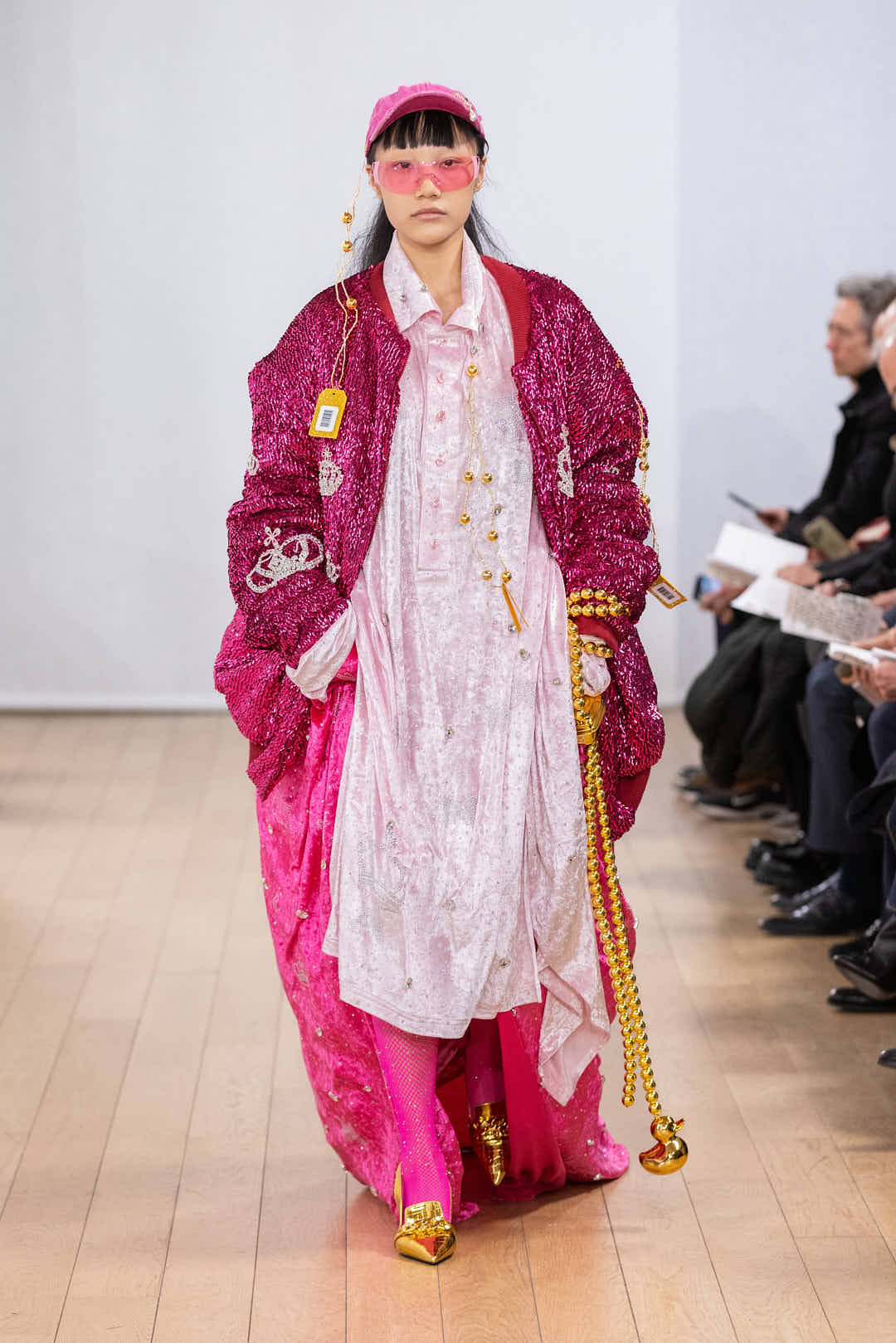
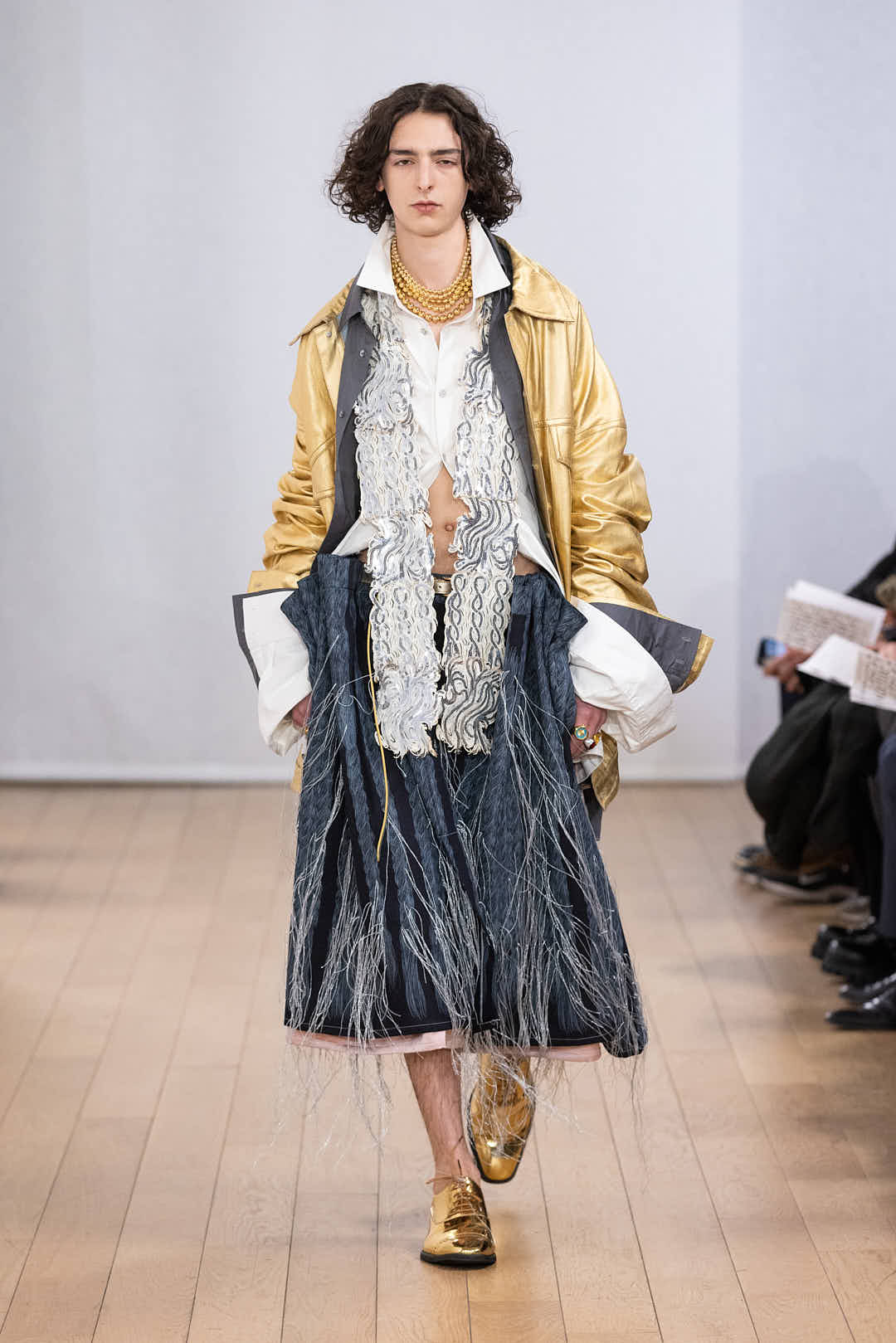
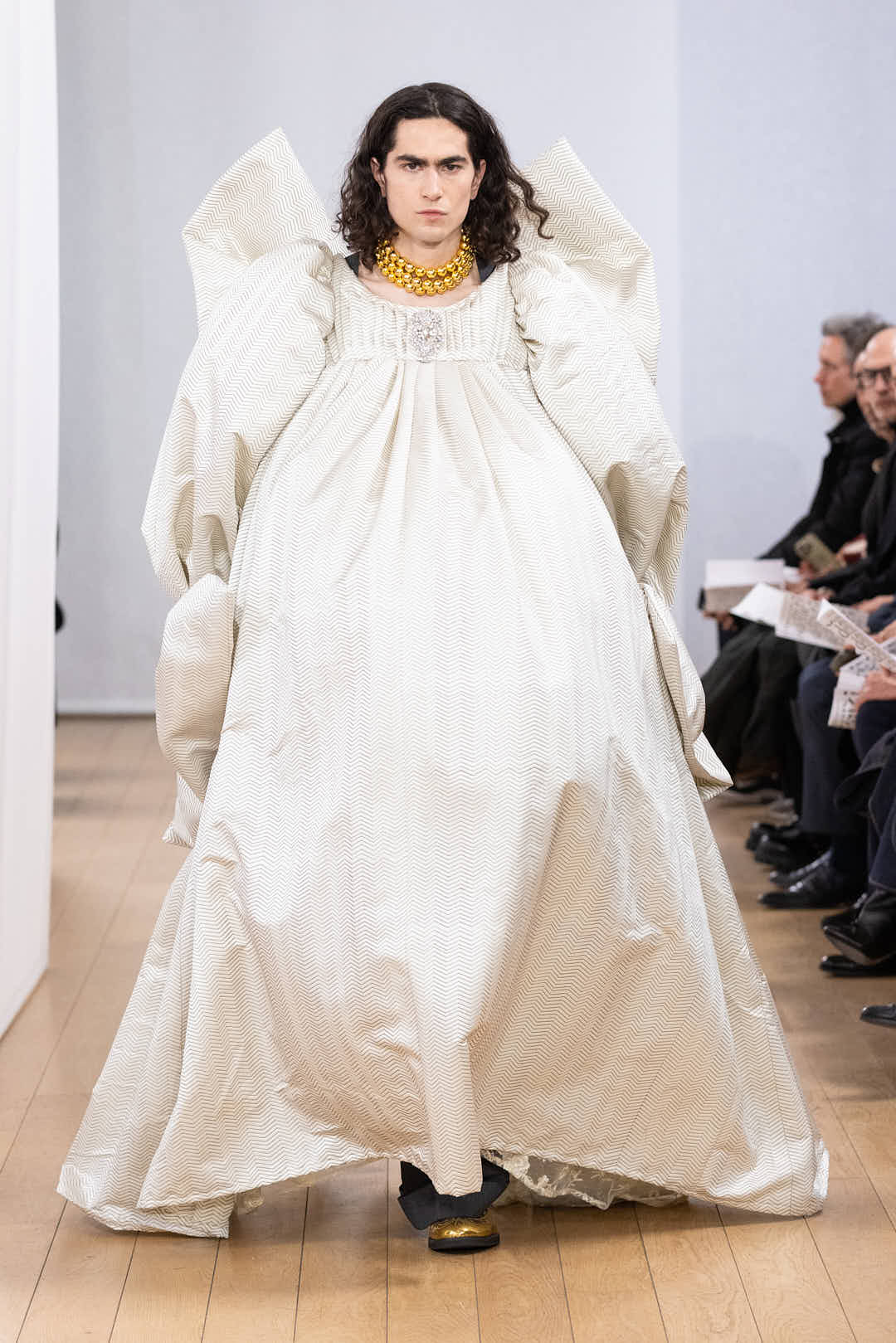
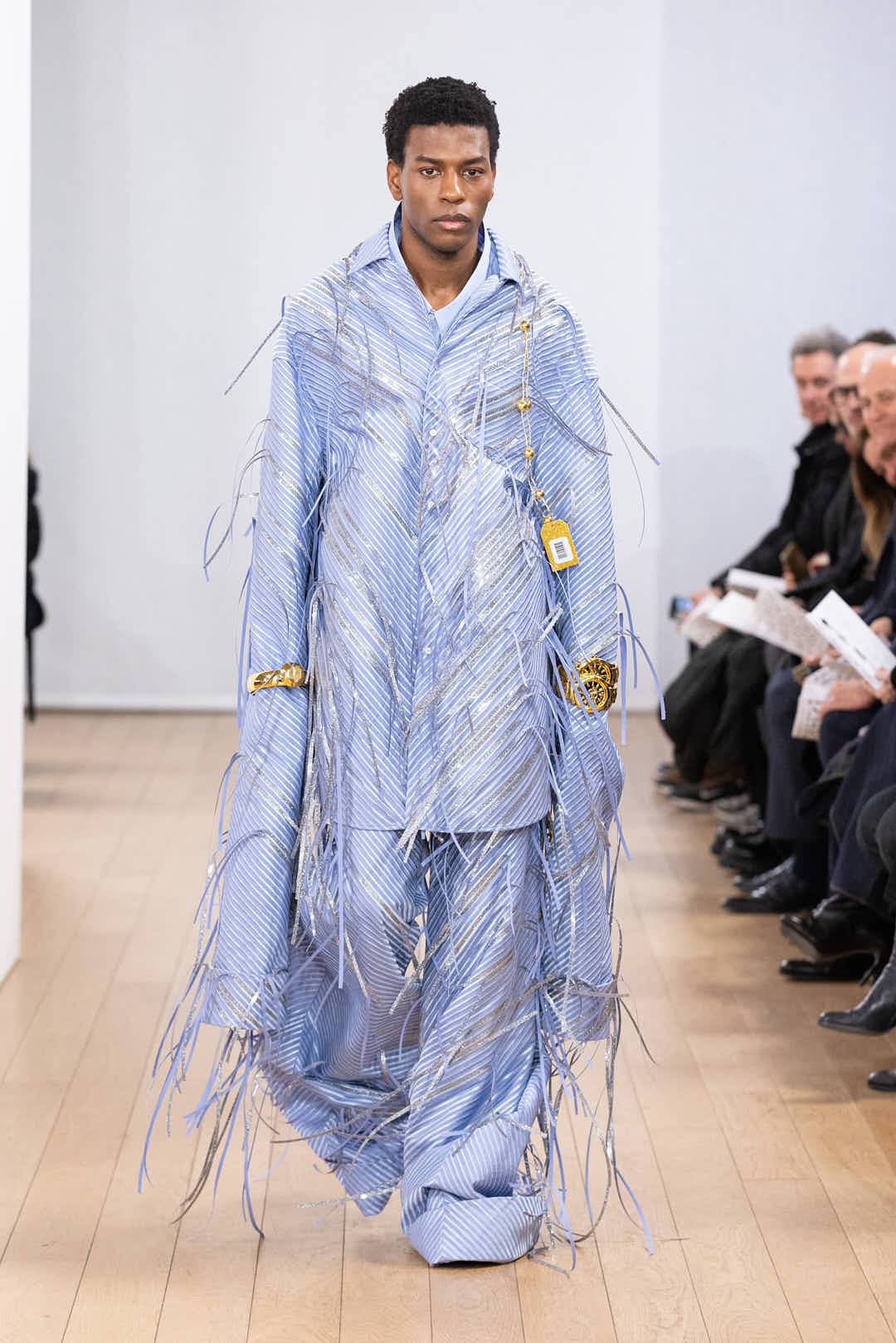
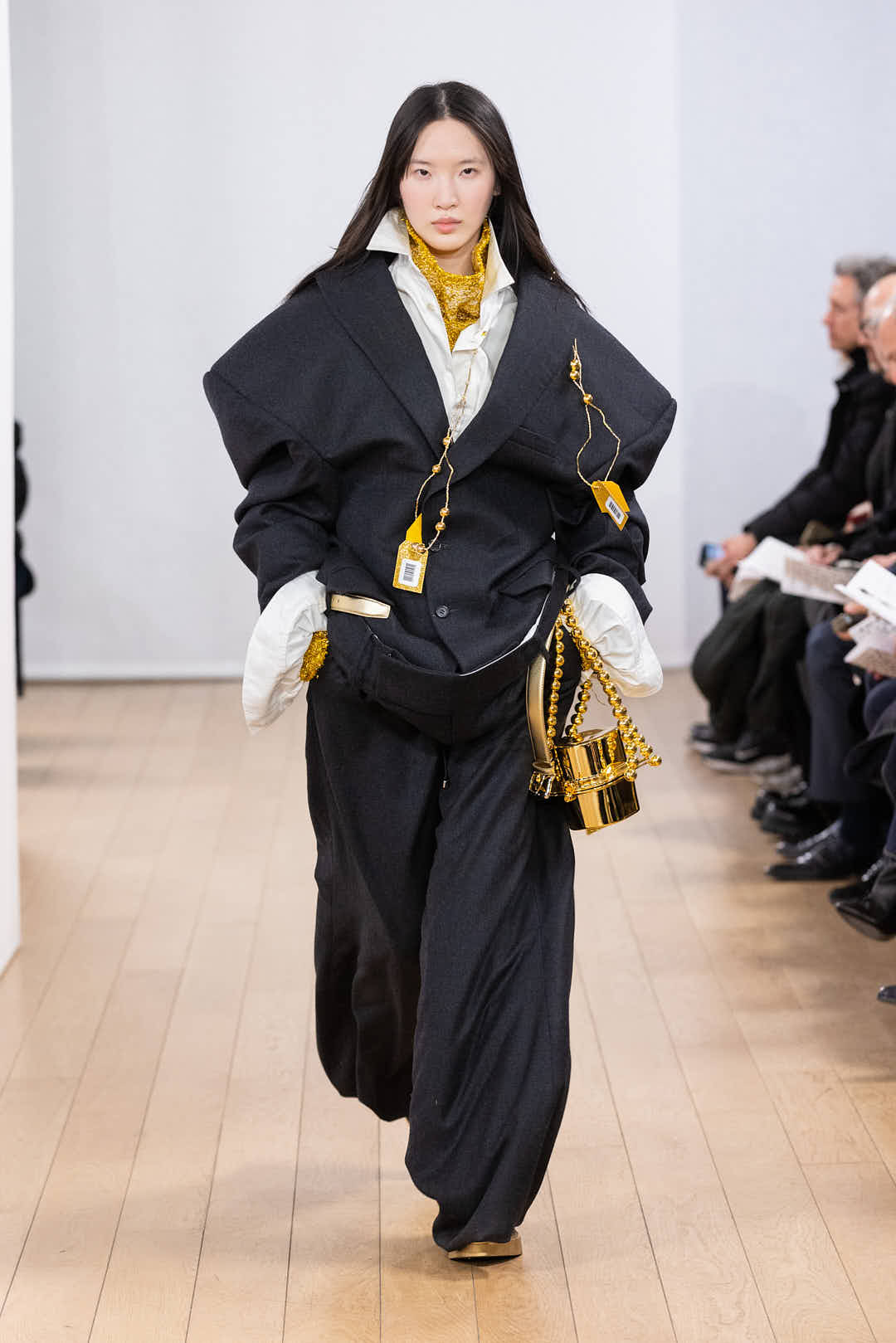
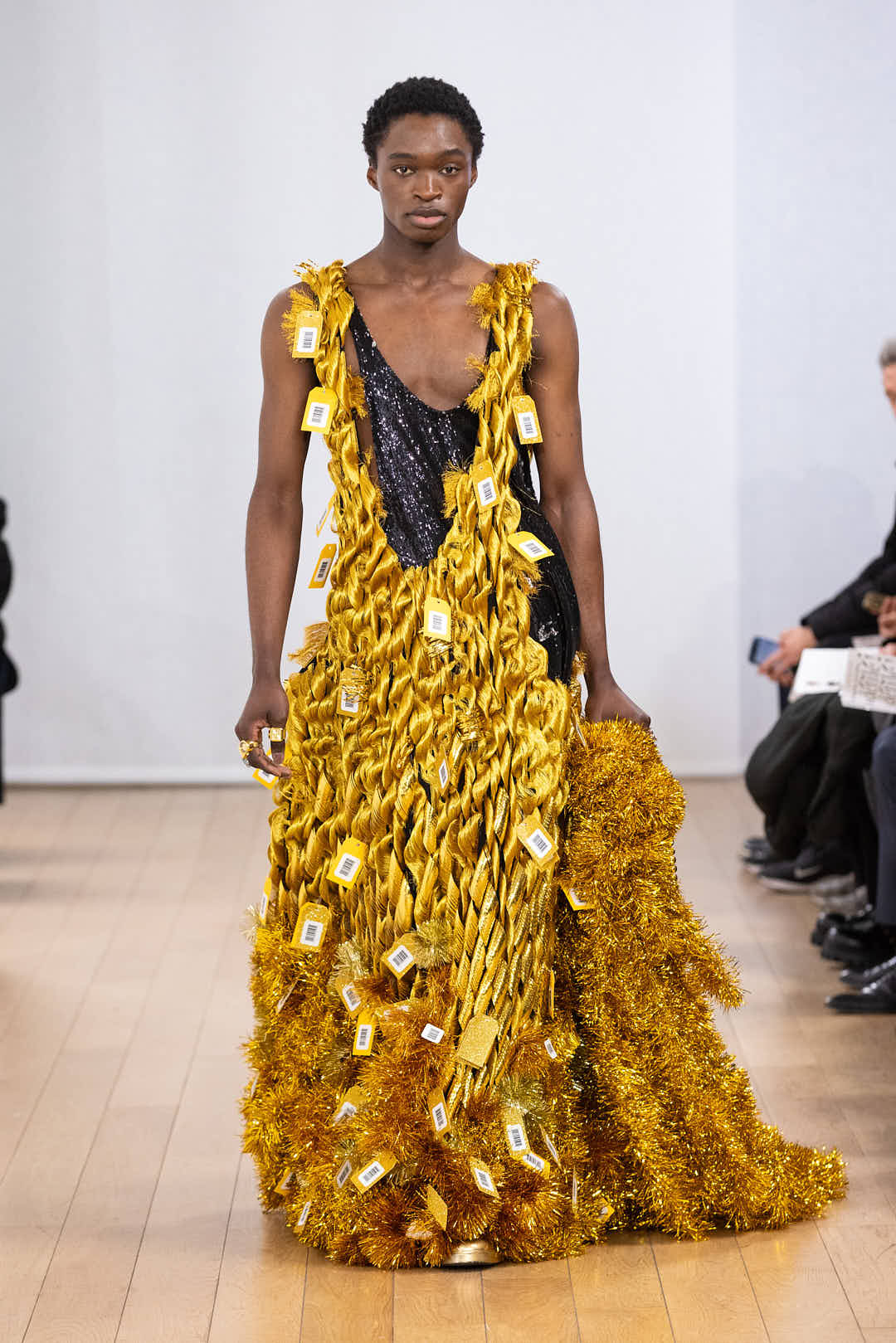
Designs by @reece_liang, photographs by @guillaumeroujas.
Describe your collection in a few (buzz)words.
Reece Liang (RL): The project is about garments as performative tools in social activities and the societal objectification we create in fashion.
Tell us more!
RL: The collection started with how people around me who are not studying or working in fashion view fashion.
Sometimes, I participated in their process of consuming garments, and it was usually more about whether the garments suited their working or social position or the social imagery they wanted to be represented in—a very direct way of viewing a piece of garments with usually a very clear purpose.
Therefore, I thought that we often use garments as performative tools to communicate our social character and to tell others how we want to be treated.
That is also why, in the inspirations and research archives, I have very mundane daily garments combined with festive wear for parties. Even though they look dramatically different, we use them for the same purpose—to perform particular identities and dress up as the ideal people we should be or want to be.
I want to take those mundane garments out of their original social contexts and environments, mix them up, and create a faux visual narrative for our preset social experiences and perspectives on those mundane garment pieces.
What was it like bringing this collection to life?
RL: It was really a challenging mission made possible. I loved the patternmaking and silhouette development because that is what I’m usually very interested in and flexible at, yet the textiles and fabrications are the challenging part.
I enjoyed experimenting with many textile manipulations, and I have produced a large number of samples, However, with this concept, there is always a risk that the collection will look too dainty, and I still want them to be very rough, realistic, and contemporary.
There were many great people and sponsors along the way. We worked together on the finishings and details and produced those textiles professionally to transform the designs into solid, realistic garments, and I feel fortunate to have them.
What’s next for you?
RL: The next step, I think, for most of us is to enter the professional field, and I really look forward to that; even though we all have already experienced more or less during or before our master’s degree, I think it would still be very exciting to see how the industry runs with a lot of great people working together. Of course, there is still a lot to learn and experience.
If you could go back to the start of your MA and give yourself one bit of advice now, what would it be?
RL: Believe in your decisions, be very decisive, start first and learn along the way.
Learn to share and communicate your ideas and difficulties more with the people around you because you never know who might have had the same experiences and they have great solutions or suggestions. In this way, we could work concurrently to create beautiful results.
Be as clear and efficient as possible with what you want to achieve and also in communications regarding productions and work; it will help you a lot and make everything more straightforward for people working with you.
Darius Betschart, “Bakken”
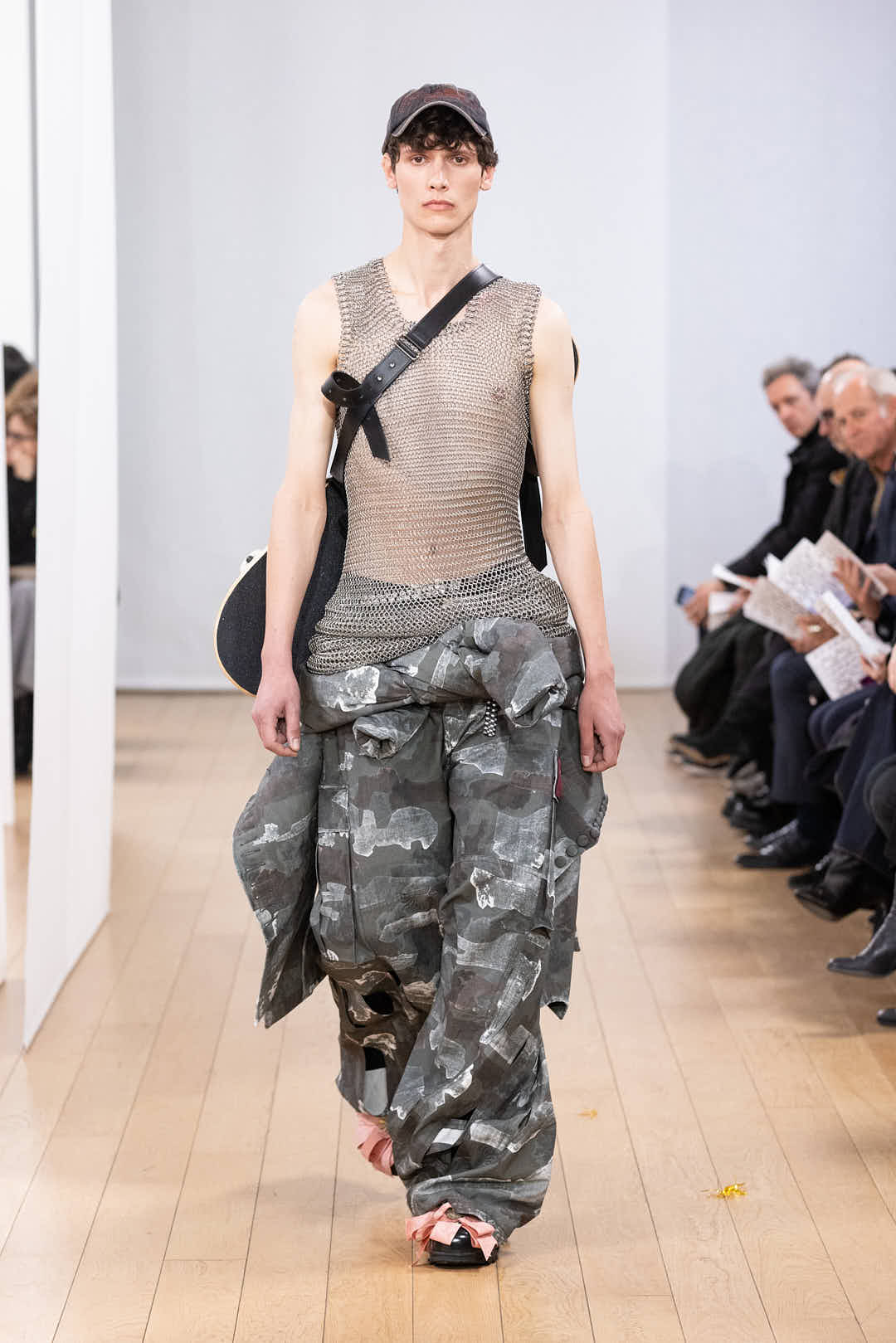

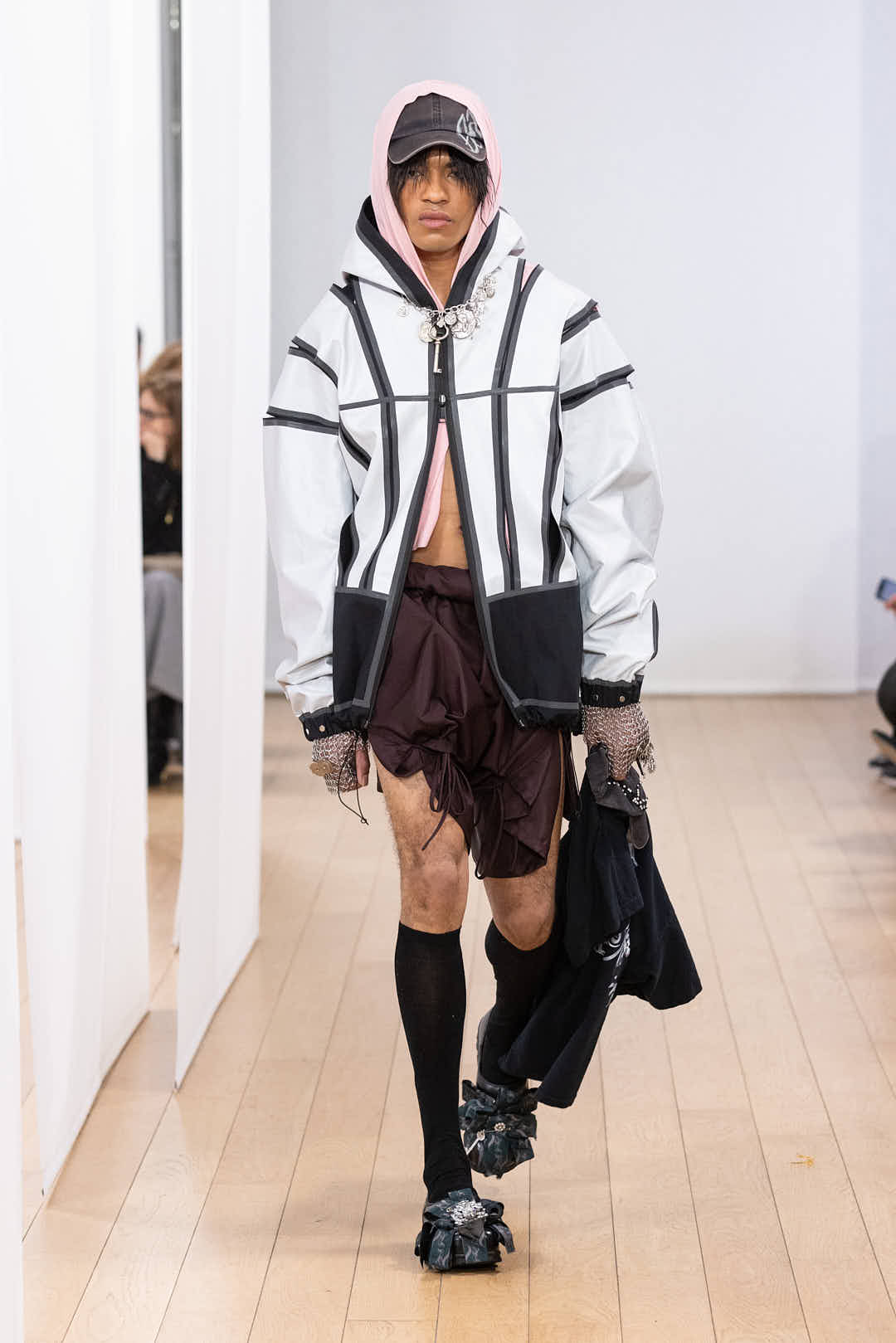

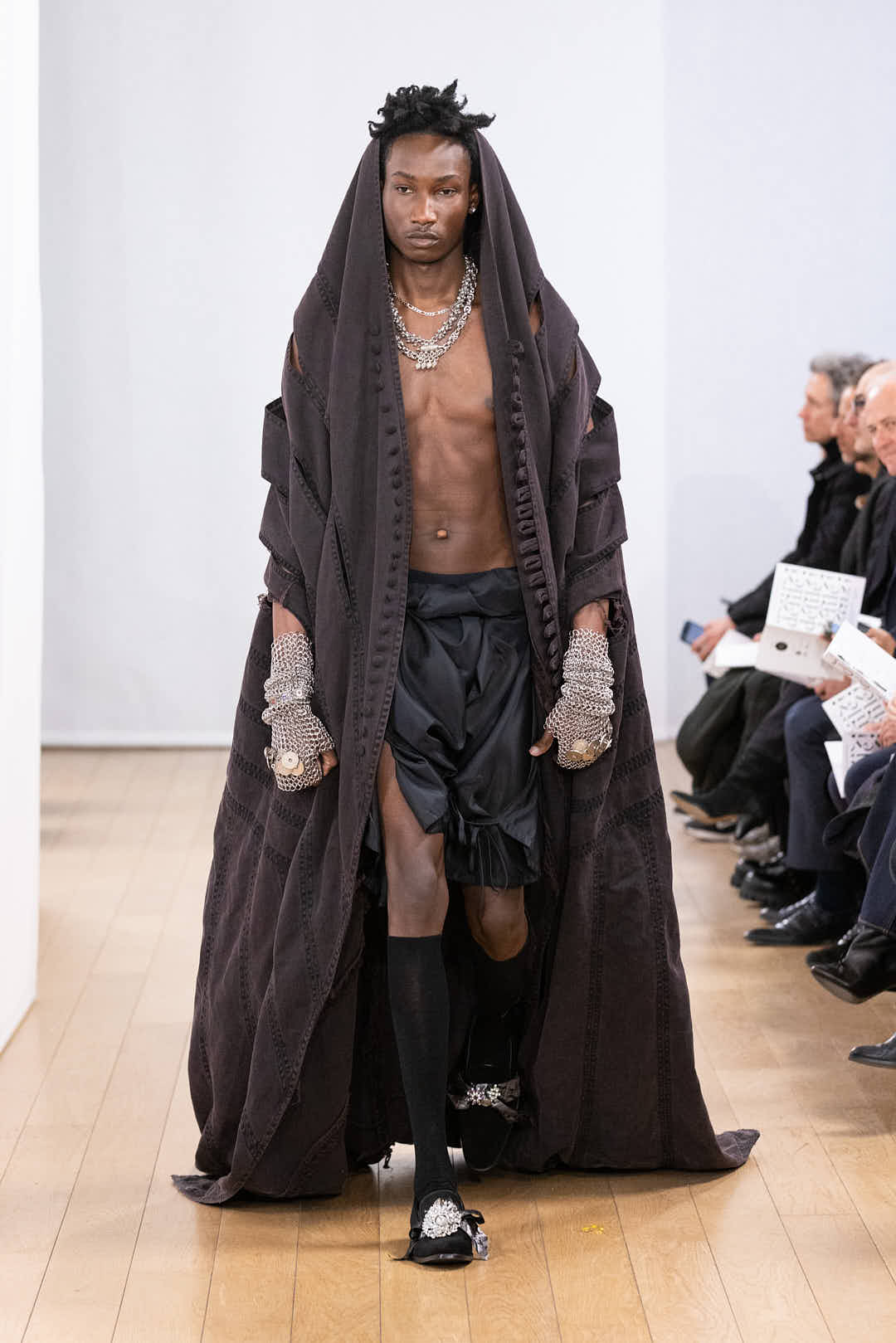
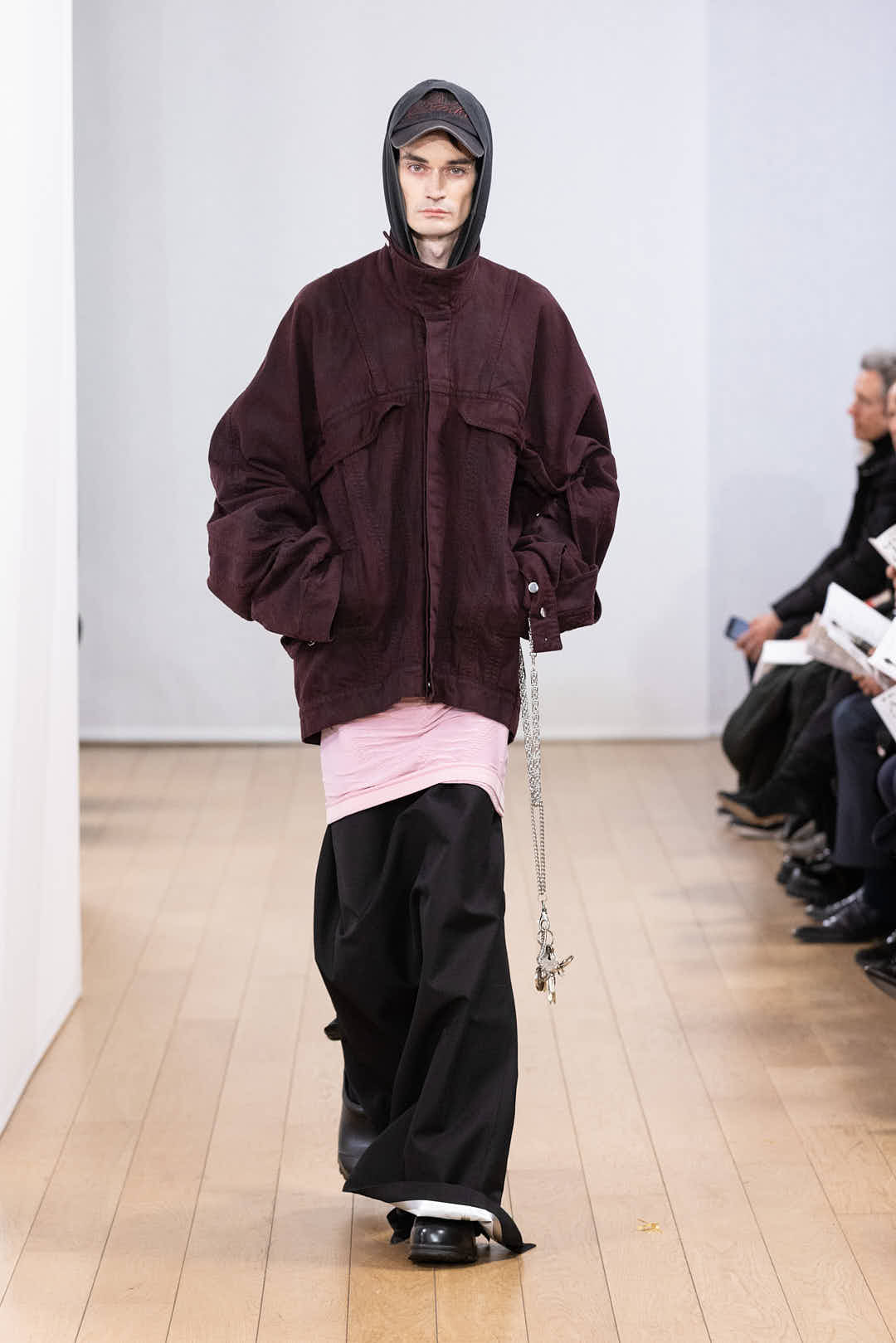
Designs by @dariusbetschart, photographs by @guillaumeroujas.
Describe your collection in a few (buzz)words.
Darius Betschart (DB): Copenhagen subculture with a medieval twist! It’s all about skating and raving, but in a 12th-century core.
Tell us more!
DB: Well, I’m based between Copenhagen and Paris and I really wanted to showcase my love for Copenhagen. I’ve also been working around subcultures and youth for quite some time now, so I thought this was the opportunity. I spent last summer [in Copenhagen] and I knew that what I was looking for would naturally come to me [there]. I forced it a bit by going clubbing 5 days a week, every week, for 2 months, and ended up locking eyes with someone who was exactly what I was looking for. I just got their Instagram and decided that it was now my moodboard.
I made it mine and built the appropriated wardrobe. Mostly subculture classics: the goal wasn’t to create something new, it was more about making nice garments that resonated with the Danish subcultural scene.
What was it like bringing this collection to life?
DB: It was definitely challenging, I put a lot of weight on my shoulders, telling myself that everything should be perfect and questioning every decision.
A lot changed along the way. I started with something very product-design based but it got a lot more extravagant than I thought it would have, and it was a challenge to accept this extravagance as it wasn’t my idea or what I was hoping for at the beginning.
The biggest shift for me is that I stopped aiming at designing only things that I would myself consider desirable and loosen the grip on my products to allow more freedom in shapes and volumes – I had both good and bad surprises with that but learned a lot and will try to perfect my skill on that point.
Even casting wise, the morning on the day before the show I had only 4 models confirmed for the 6 looks but thankfully it worked out in the end
I was also insanely lucky to get four sponsors who all were willing to provide so much to me. I went to visit Beste in Prato who did the two technical jackets, a full dress and knit piece all made with 3L bonded wool, viscose and cotton to give it a gore-tex look. Bleu Océane carried out the three denim pieces, which were all massive and not easy to assemble. Teintures de Frances carried out all the fabric treatments like Ozone wash, digital embroidery, printing, overdye, garment dye and Mion produced ribbons and labels with a specific jacquard and weaving for me.
What’s next for you?
DB: Now I’m taking the time to reply to e-mails, thanking my sponsors and making nice visuals for my instagram, organising the lookbook shoot, getting sunlight and the sleep hours I’ve been missing.
I’m enjoying having most of the weight off of my shoulders, but the final jury is still around the corner.
If you could go back to the start of your MA and give yourself one bit of advice now, what would it be?
DB: I mean what’s done is done and nothing was easy, but I’d just tell myself to do more tailoring because I now wished I did a lot more.
Rachel Luurssen, “The Anarchy of the Coquette”
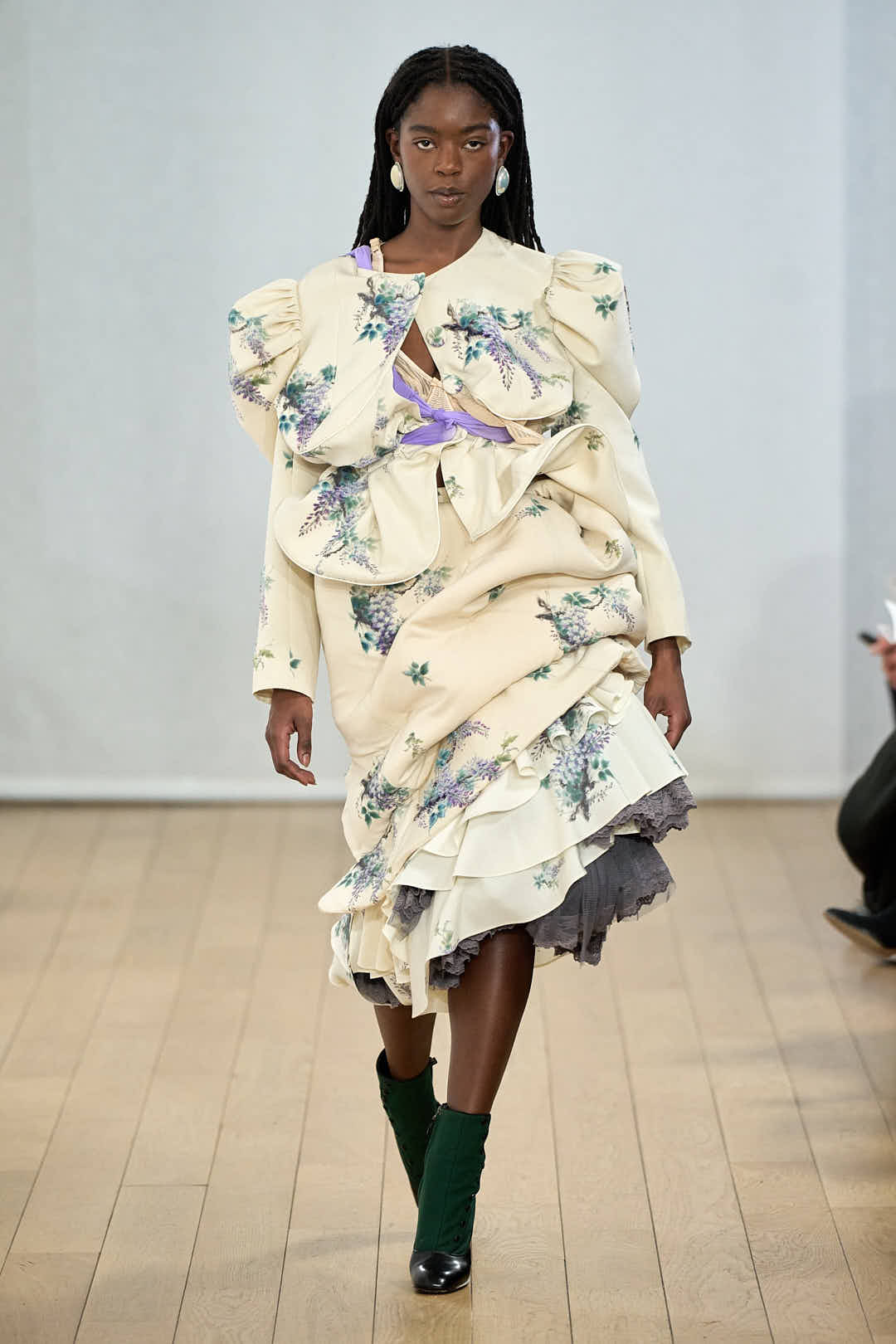
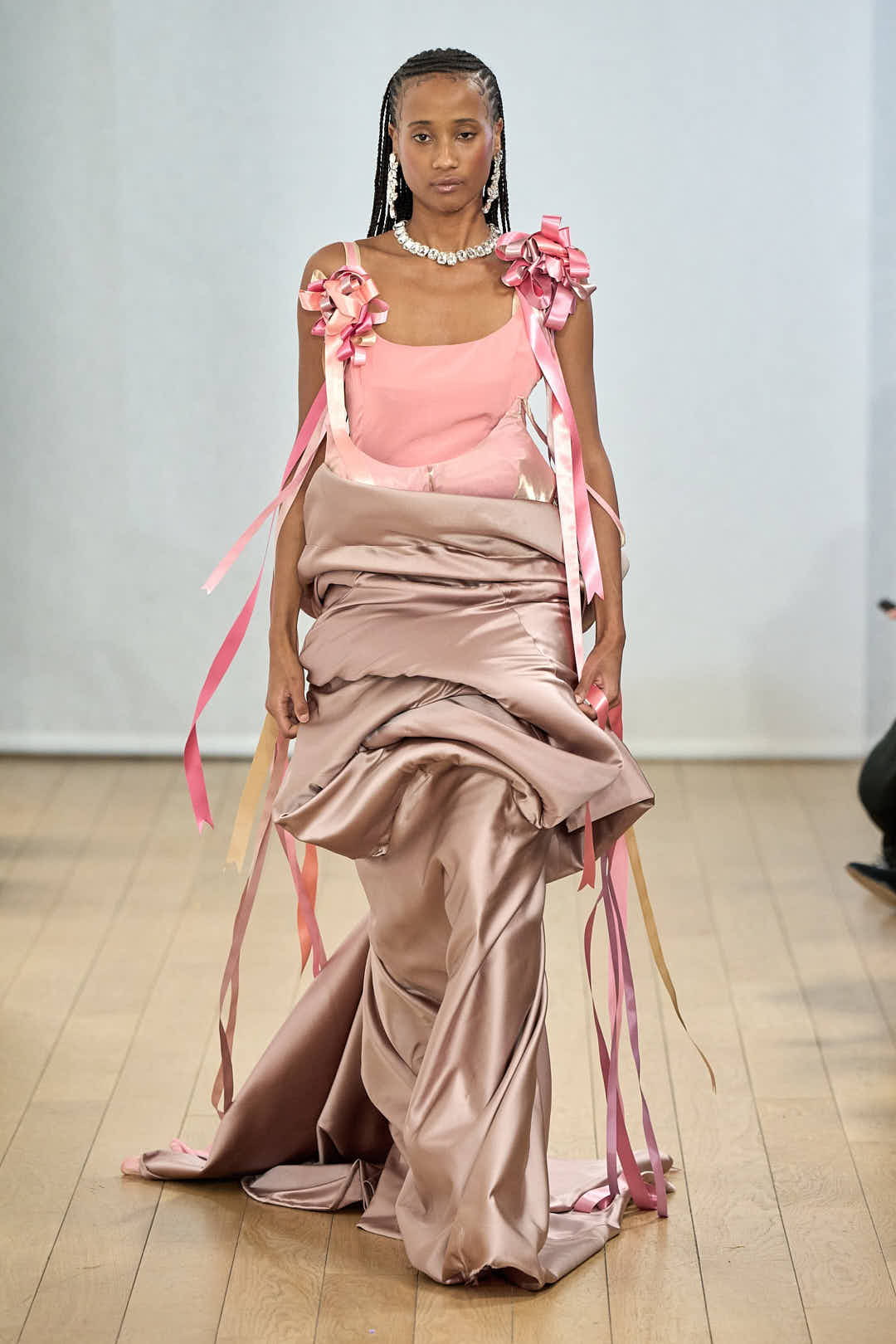
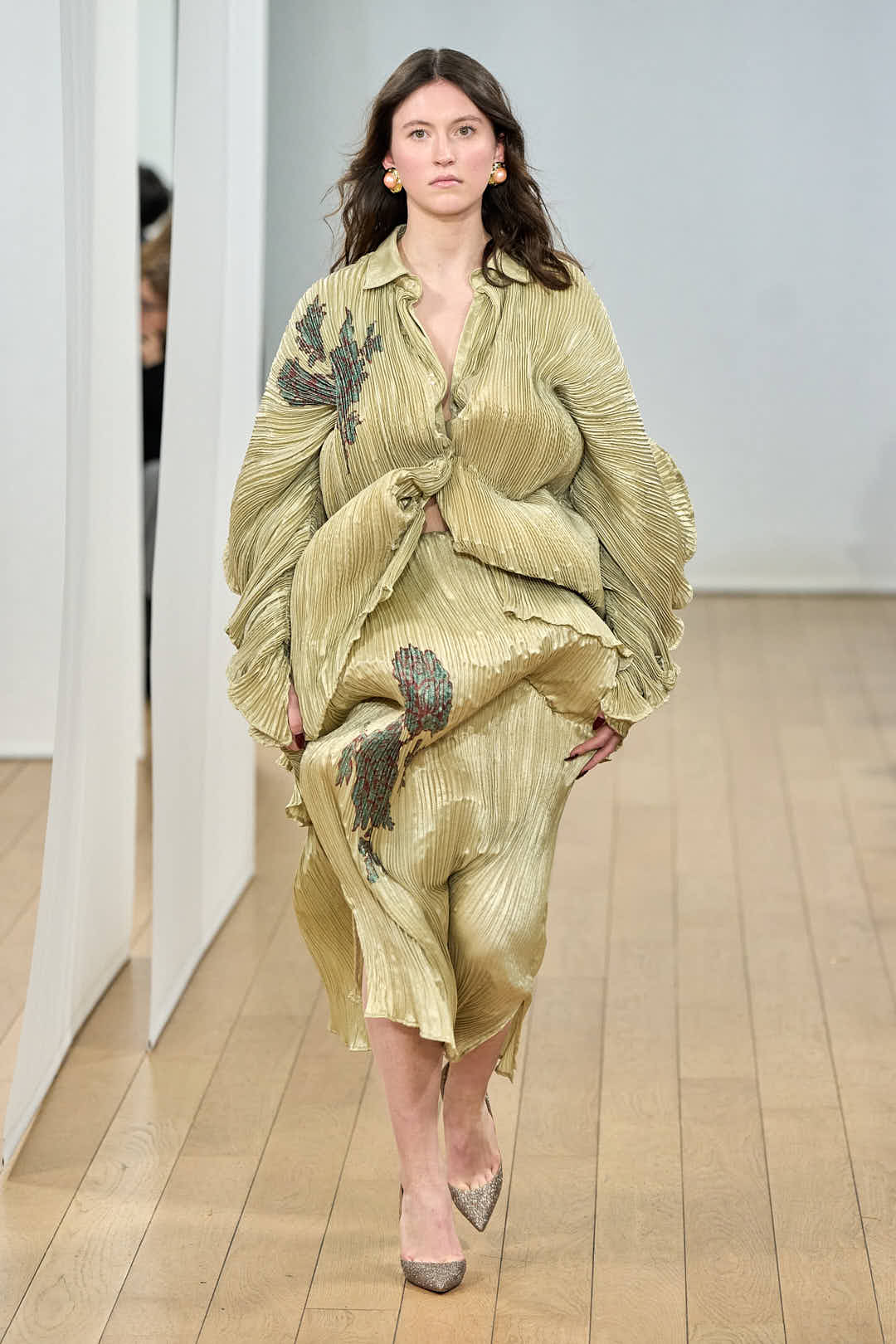
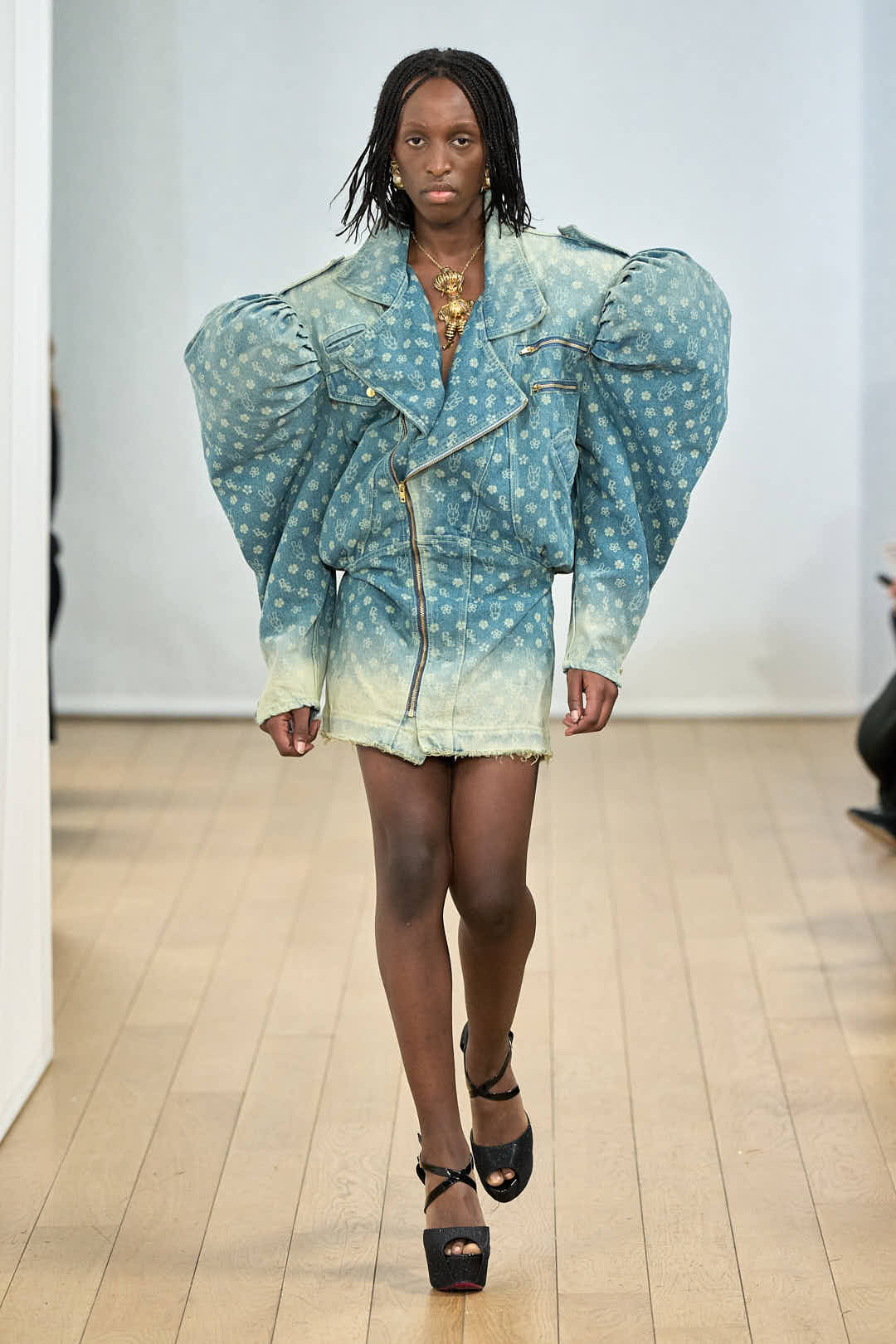
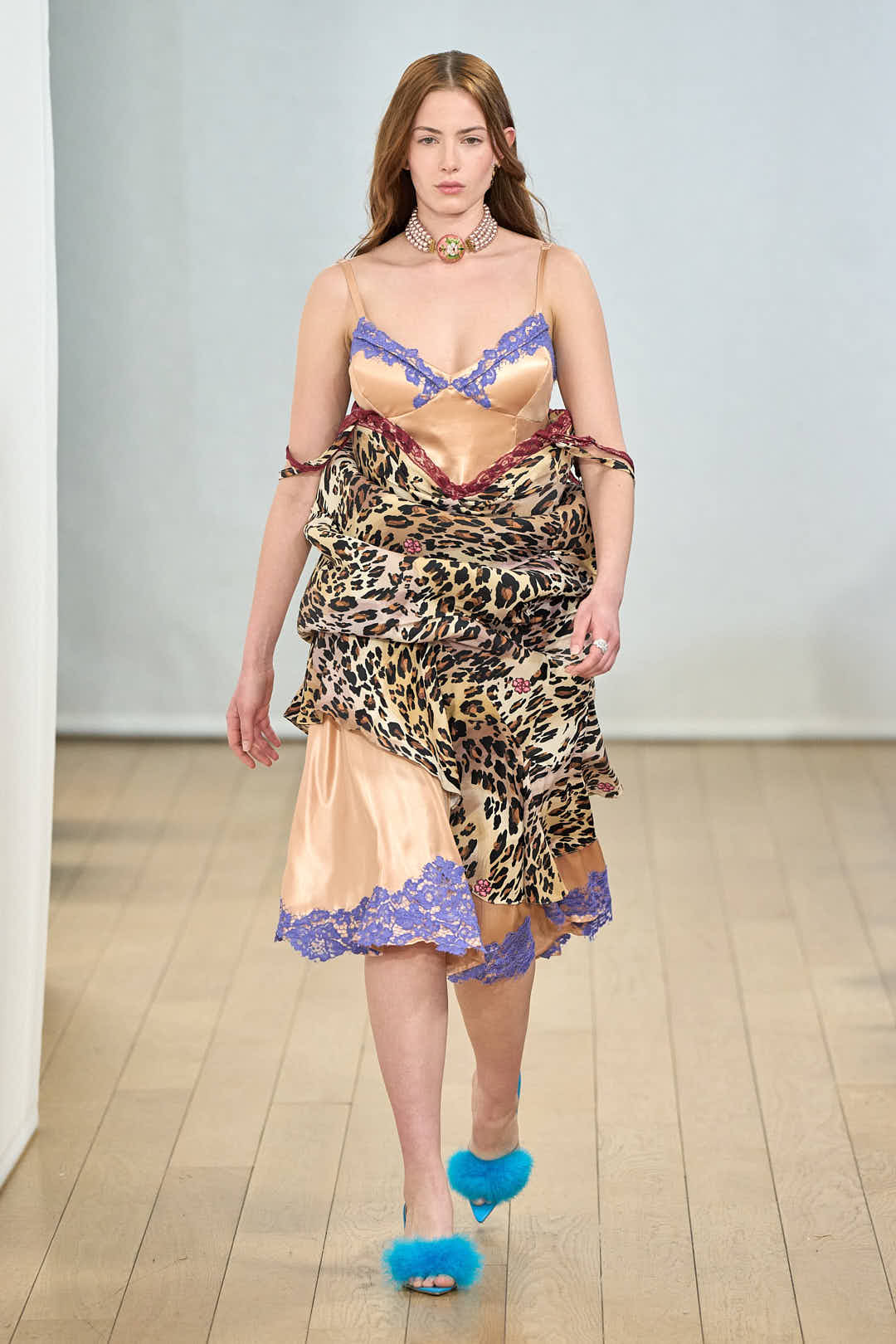
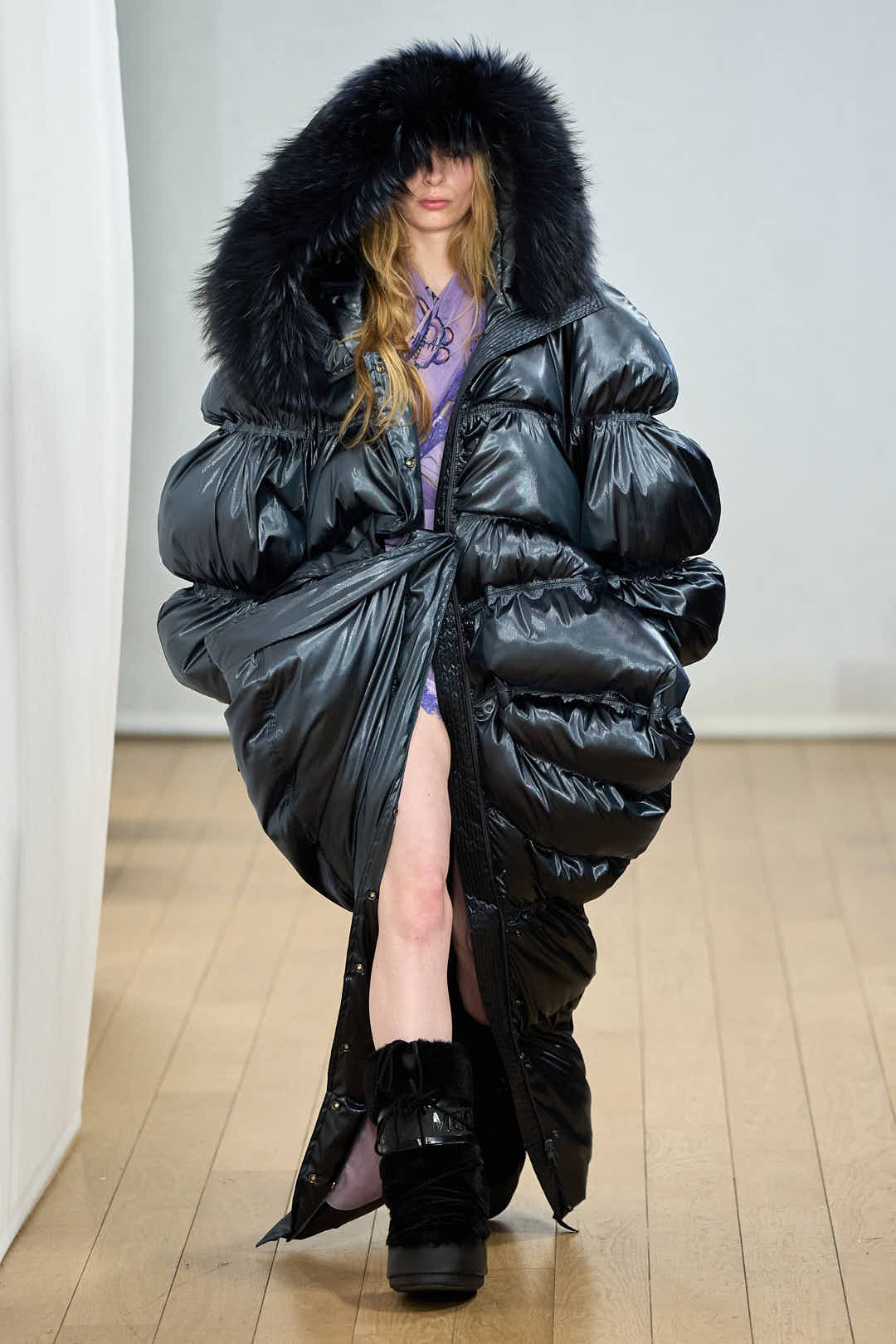
Designs by @rachel.shaniaa, photographs by Alessandro Lucioni.
Describe your collection in a few (buzz)words.
Rachel Luurssen (RL): A sculptural portrayal of ruined beauty and the pain of body dysmorphia, captured in abstract forms that balance between chaos and harmony.
Tell us more!
RL: I was inspired by the intricate layers of the broken coquette, as described in Robert Greene’s book 24 Laws of Attraction. The coquette is a master of contradiction: she captivates admirers through mystery and distance, plays with desire while never fully allowing herself to be grasped; she intrigues with her balance of strength and vulnerability. This seducing type reflects an inner fight where the longing for connection is constantly intertwined with the fear of rejection.
This dynamic forms the foundation of my work, in which the pain of body dysmorphia takes centre stage. Through abstract, sculptural forms, I visualised distortion and fragmentation as visual symbols of a fractured self-image. At the same time, beauty in my collection is deliberately disrupted, not to diminish its value but to reshape it into a chaotic, ruined state that still exudes power.
What was it like bringing this collection to life?
RL: In my collection I challenged myself with the use of mousse as a construction for my abstract shapes. Since I really wanted to bring the feeling of garments in combination with the mousse, I played with flow by draping fabrics on certain places. It was a hard task to figure out this different way of creating a garment, but that is what interested me the most: to find solutions in something almost “impossible”. Something that I have learned is to appreciate my intuition and the spontaneity along the way.
What’s next for you?
RL: Now the show is over, I am going to search for a nice internship, preferably in a good fashion house that can help me improve my volume and 3D-work skills even more.
If you could go back to the start of your MA and give yourself one bit of advice now, what would it be?
RL: Trust in yourself, your intuition knows what to do best. Sometimes I forget how far I have already come, all because I believed in myself. Sometimes I started doubting myself. But to grow, I think you have to.
Paul Billot, “Arrival”

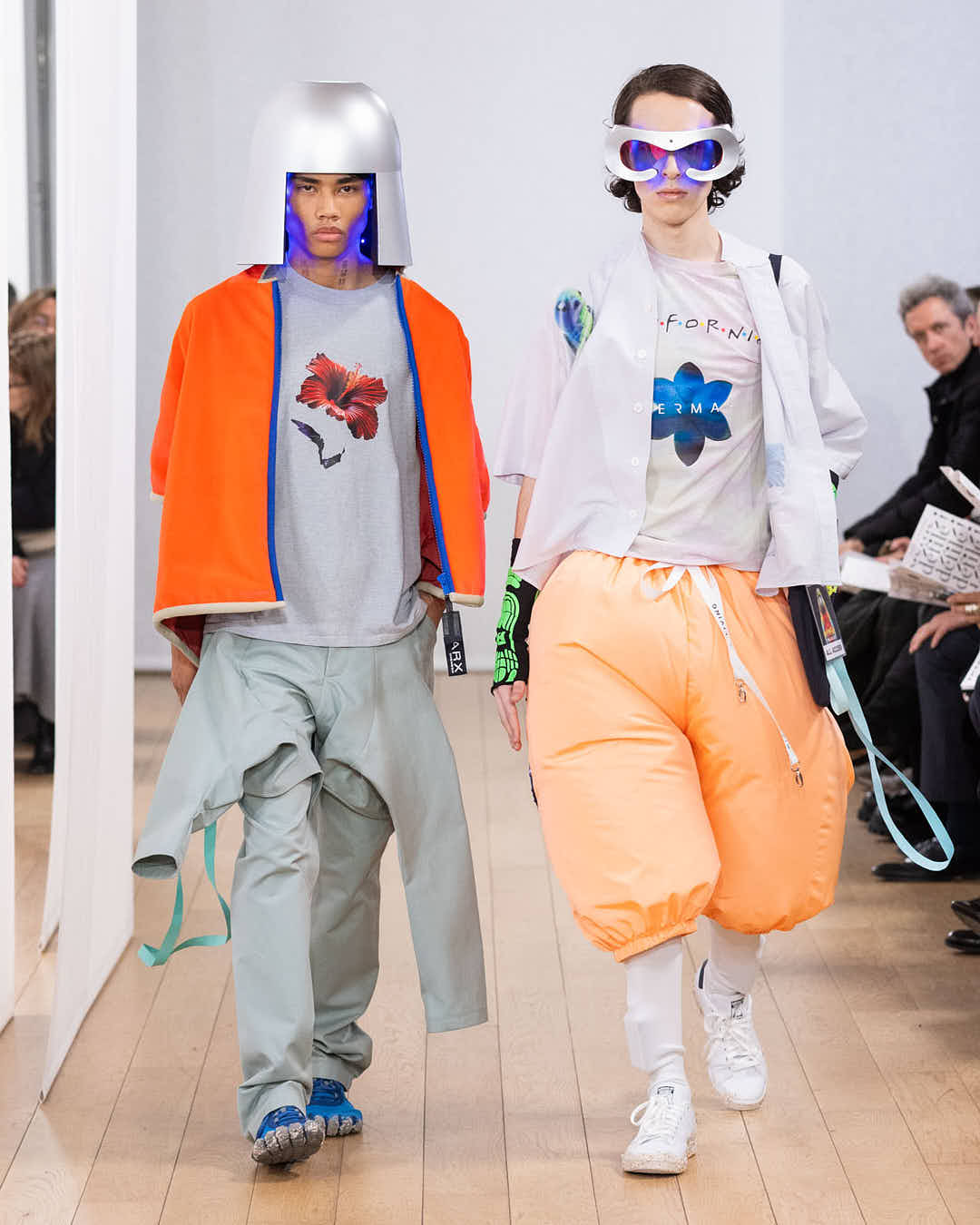
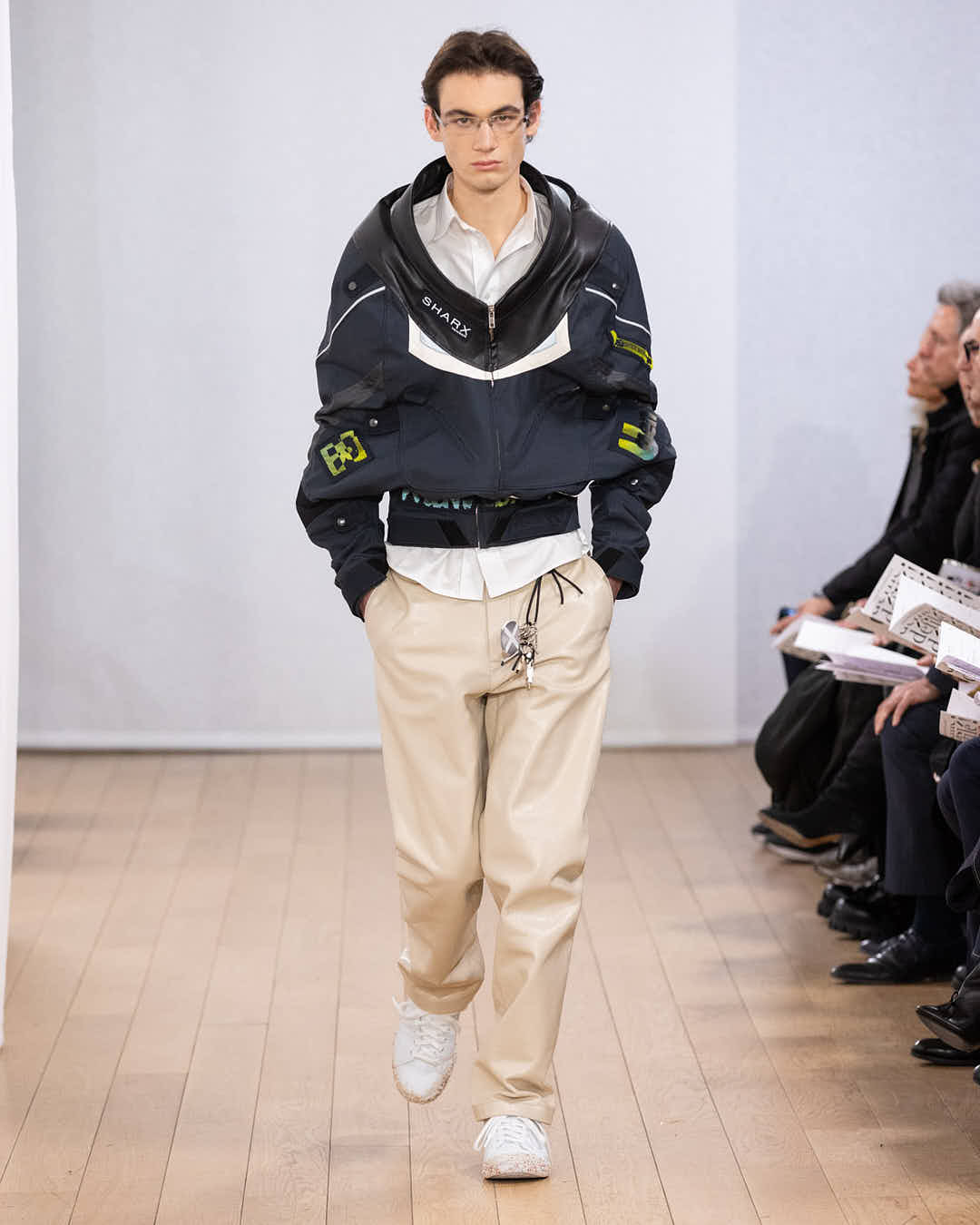
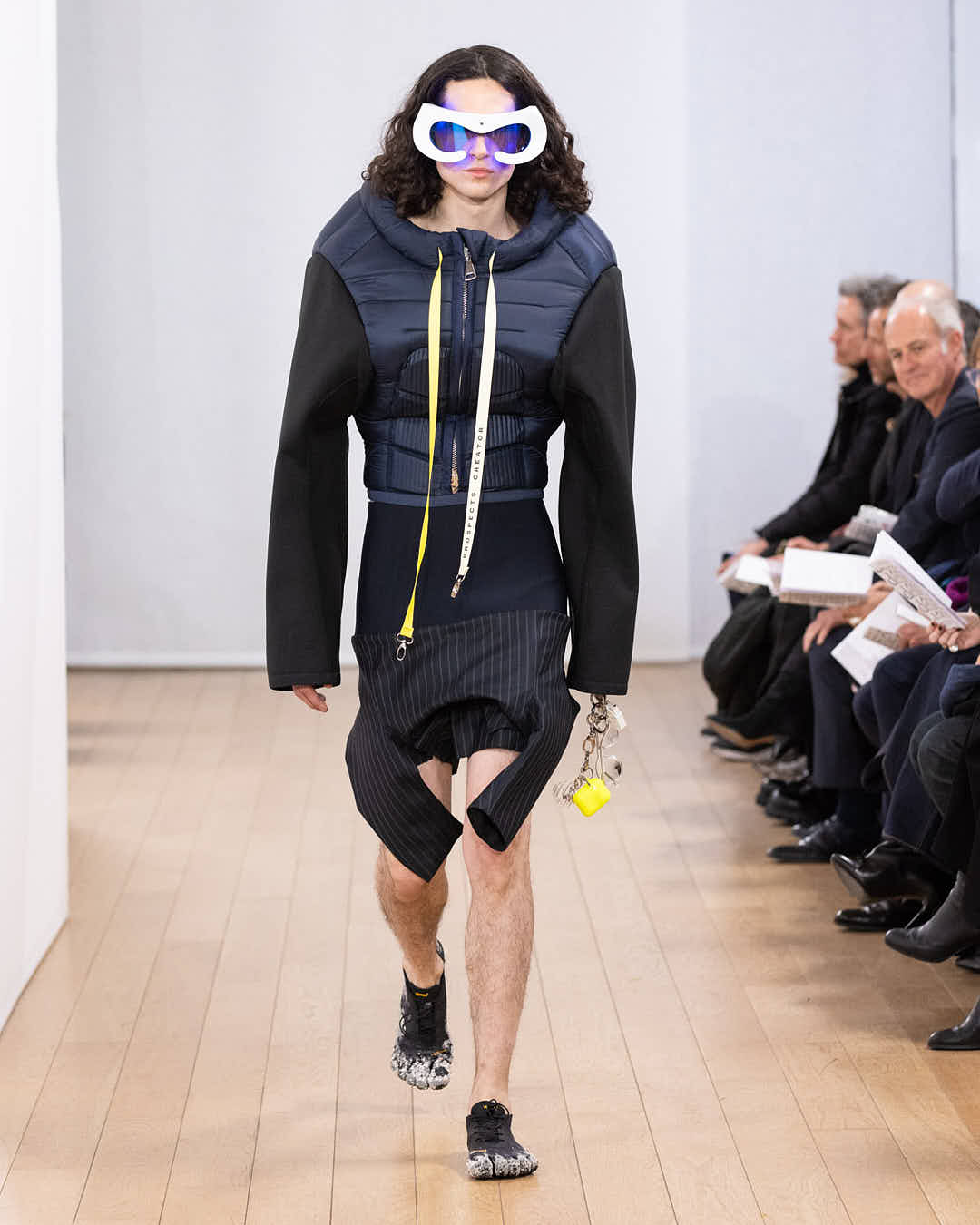
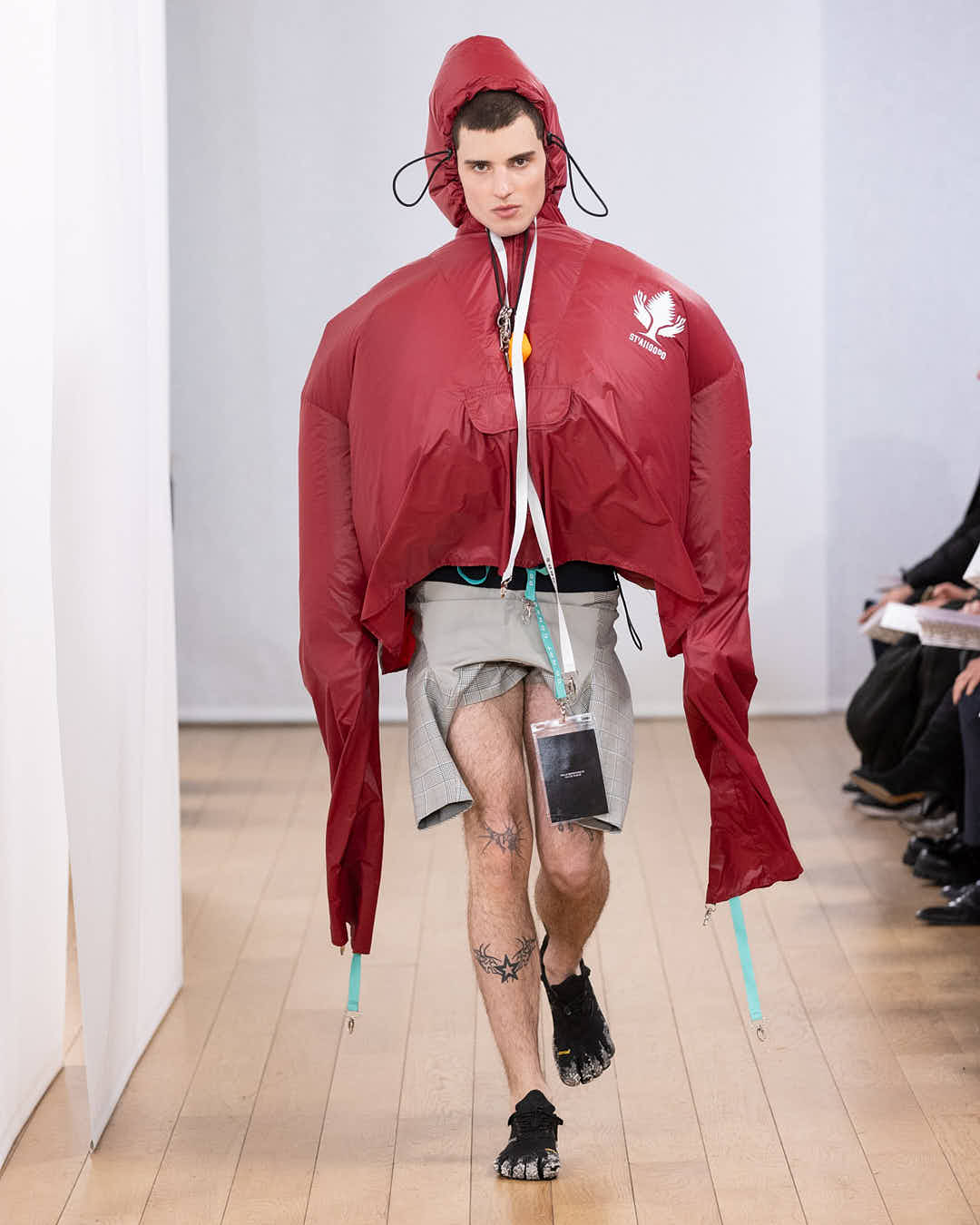
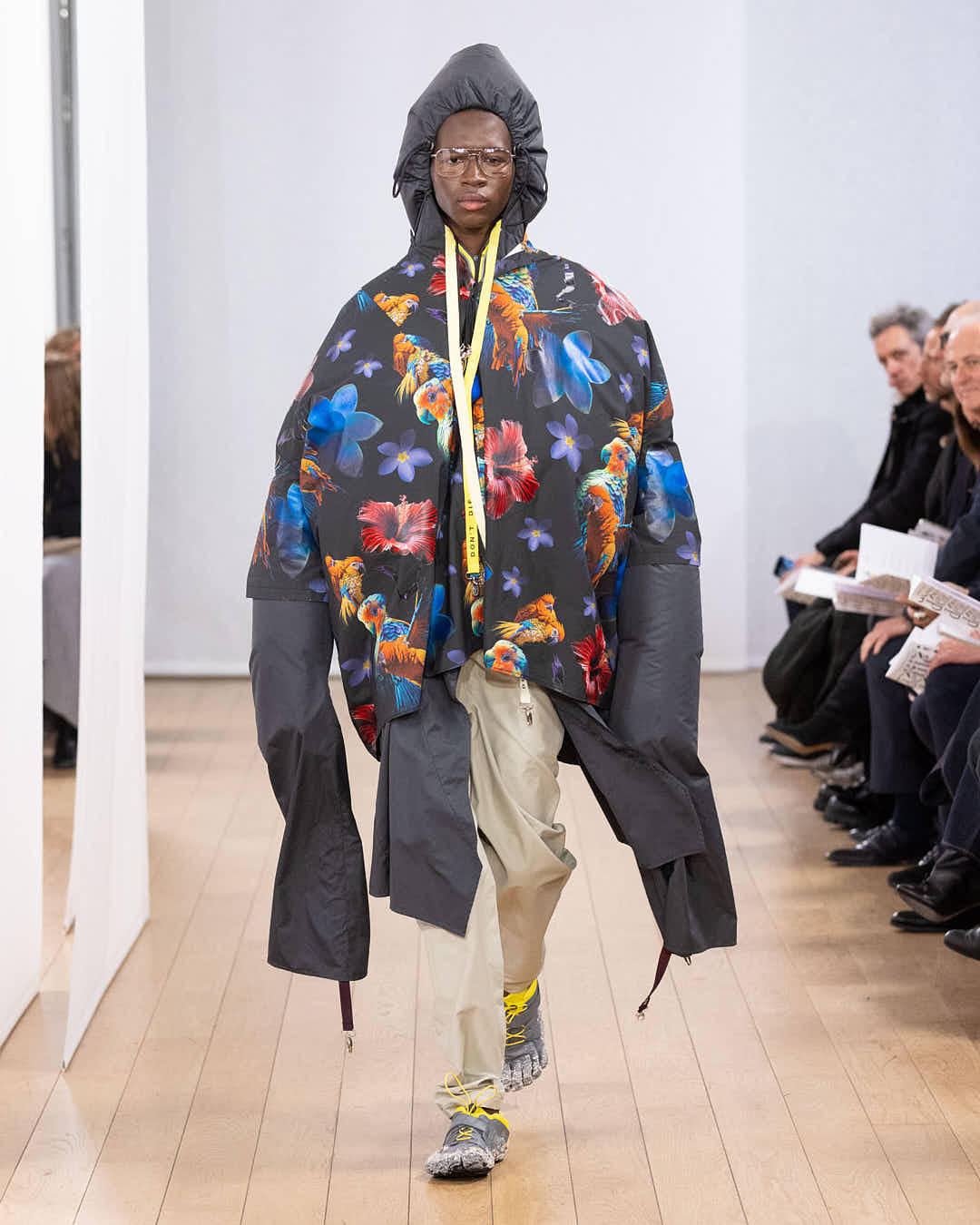
Designs by @paulbillot_, photographs by Alessandro Lucioni.
Describe your collection in a few (buzz)words.
Paul Billot (PB): What if fashion was designed by engineers?
Tell us more!
PB: My collection “Arrival” explores the collision between Silicon Valley’s tech culture and the world of high fashion. It portrays tech entrepreneurs and engineers as cultural colonisers entering the fashion industry with the same disruptive energy they’ve applied to other sectors.
The designs feature two contrasting approaches: the incorporation of technological functionality into traditional clothes, and “Pseudo Chaotic Flou” that represents the beautiful disorder that emerges from rigid systems. Each piece questions who truly dictates cultural relevance today – the fashion houses of Paris or the tech campuses of Palto Alto?
What was it like bringing this collection to life?
PB: Creating this collection was like navigating between two worlds that simultaneously attract and repel each other. I found myself balancing critique with admiration for both tech and fashion industries. The biggest challenge was developing garments that functioned both as commentary and as wearable, innovative pieces – I didn’t want to create mere costumes that illustrated my thesis. I learnt that innovation often happens in that uncomfortable space between established systems, where neither side fully accepts you. There were many technical failures along the way, especially using artificial intelligence in the process, but each setback pushed me to reconsider my approach.
The process mirrored my subject matter – the messy nature of cultural transformation.
What’s next for you?
PB: Inspiring conversations and hopeful visions for the near future.
If you could go back to the start of your MA and give yourself one bit of advice now, what would it be?
PB: Keep trying.
Sofia Castellon, “Las Gulf Girlz”
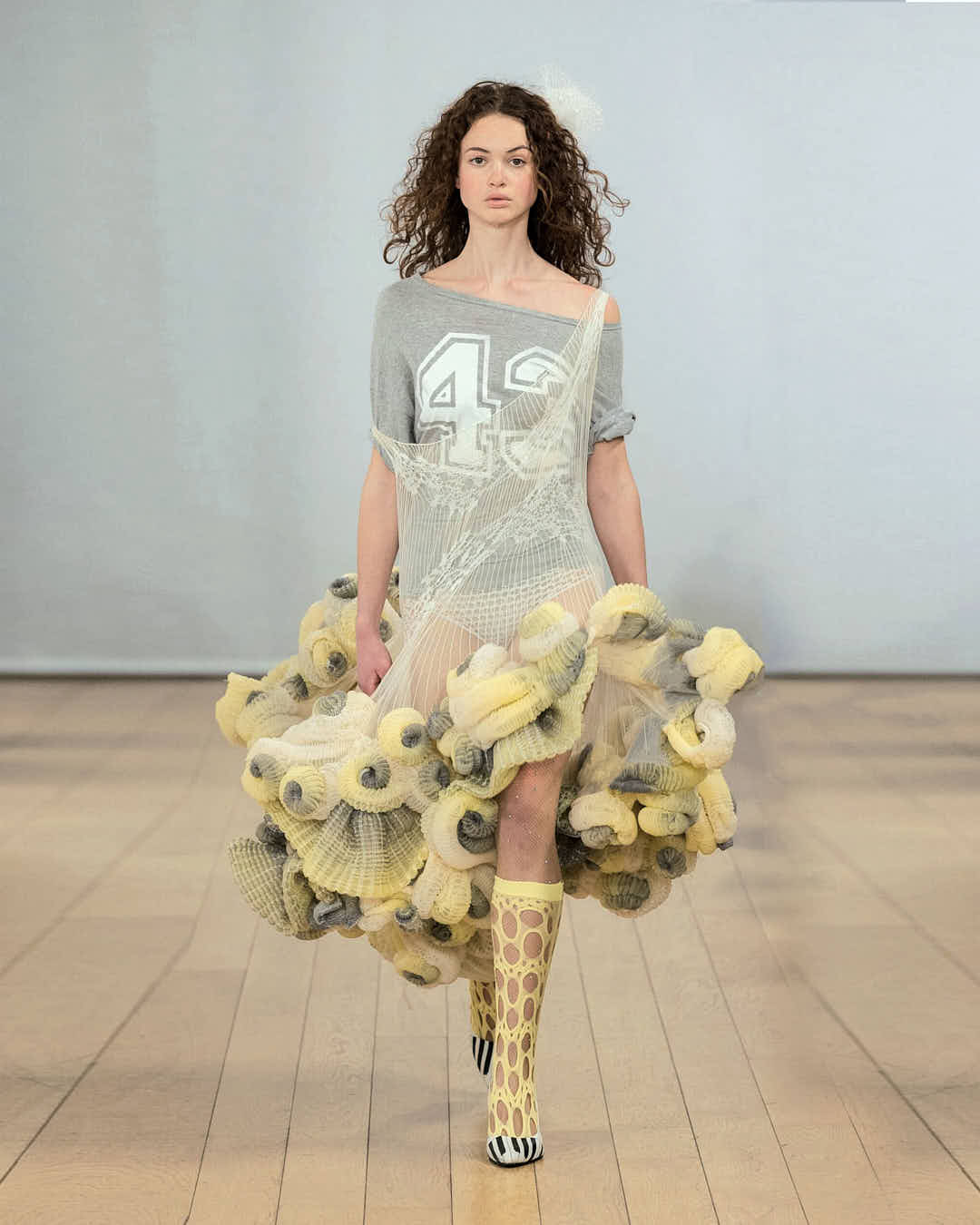
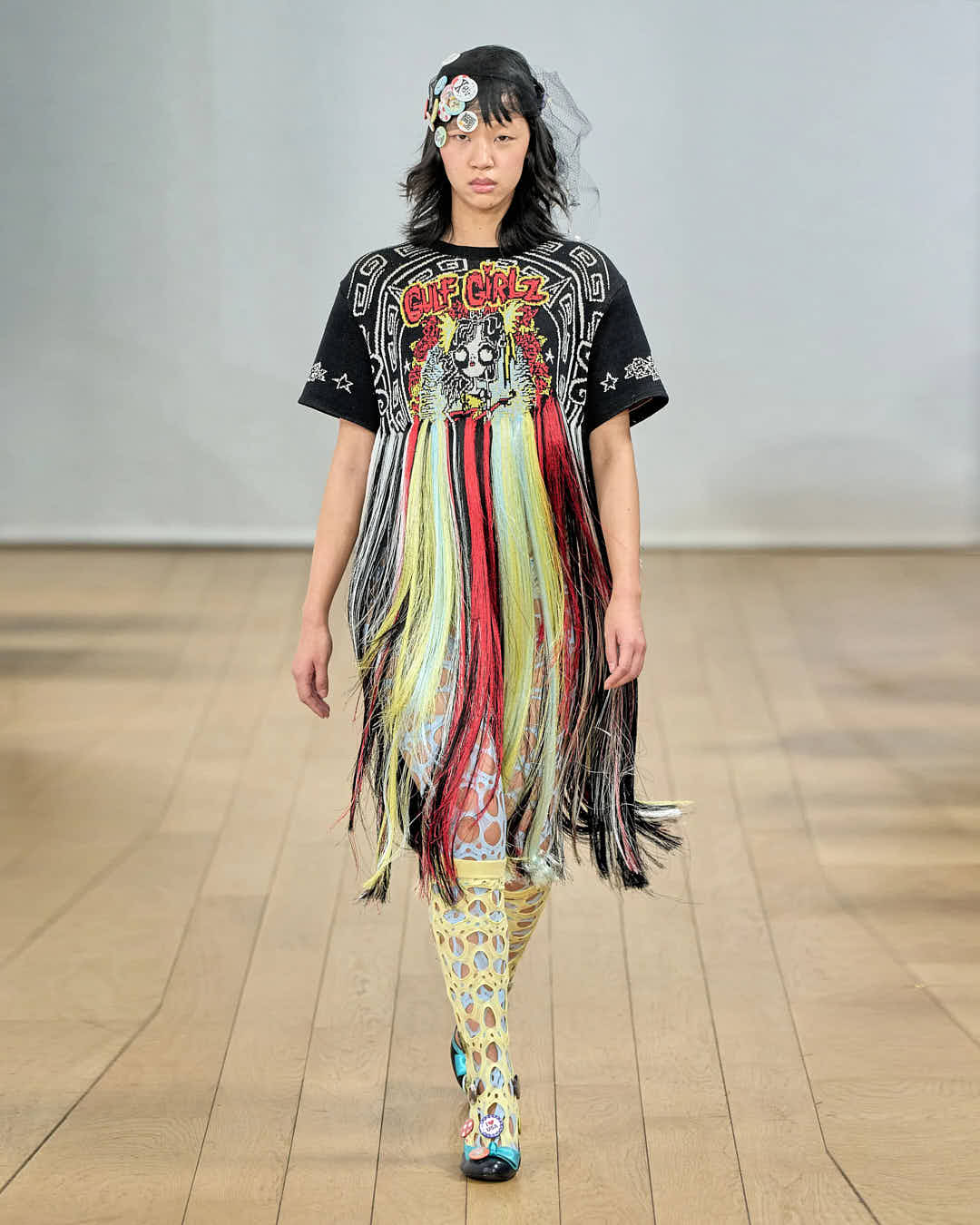


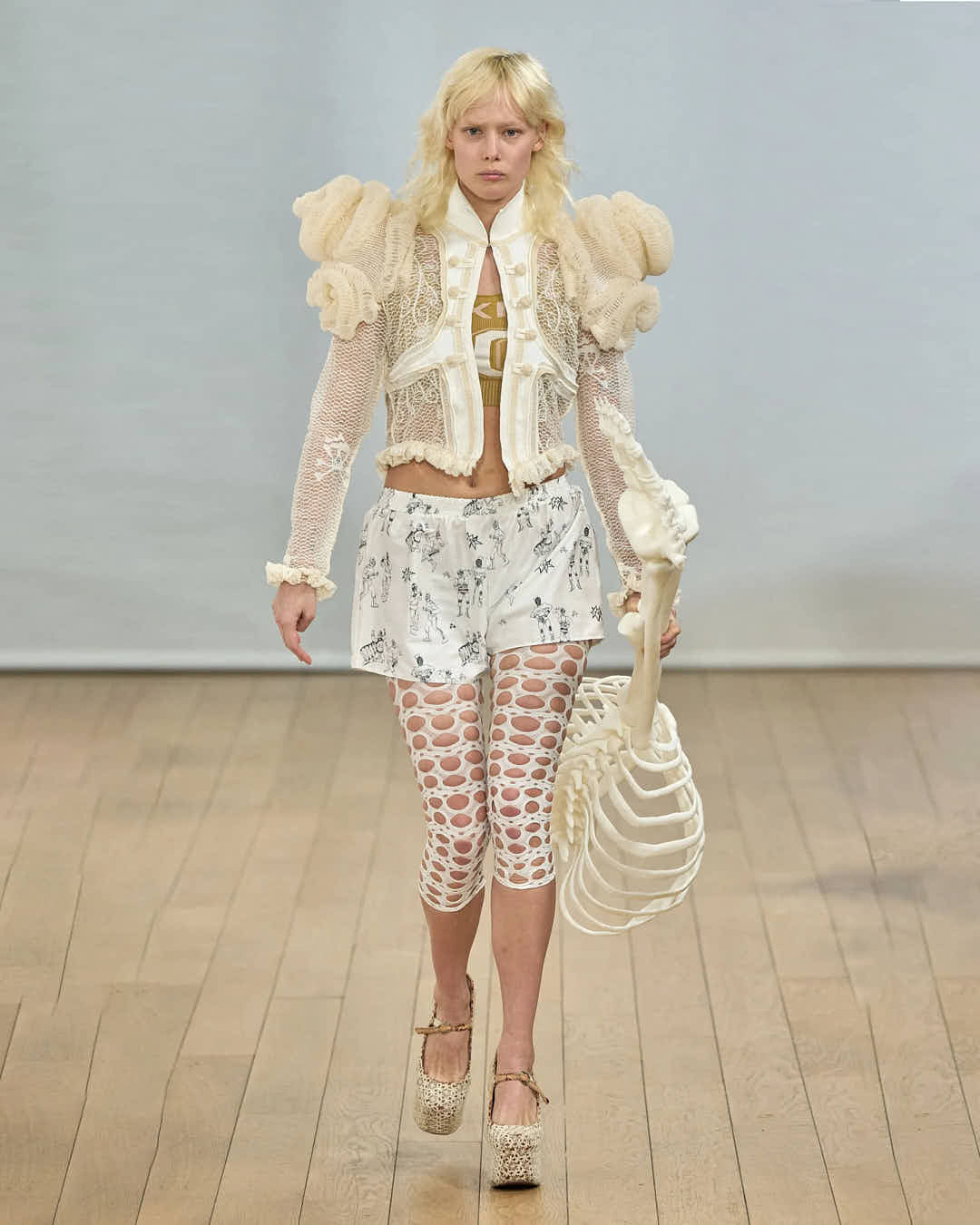
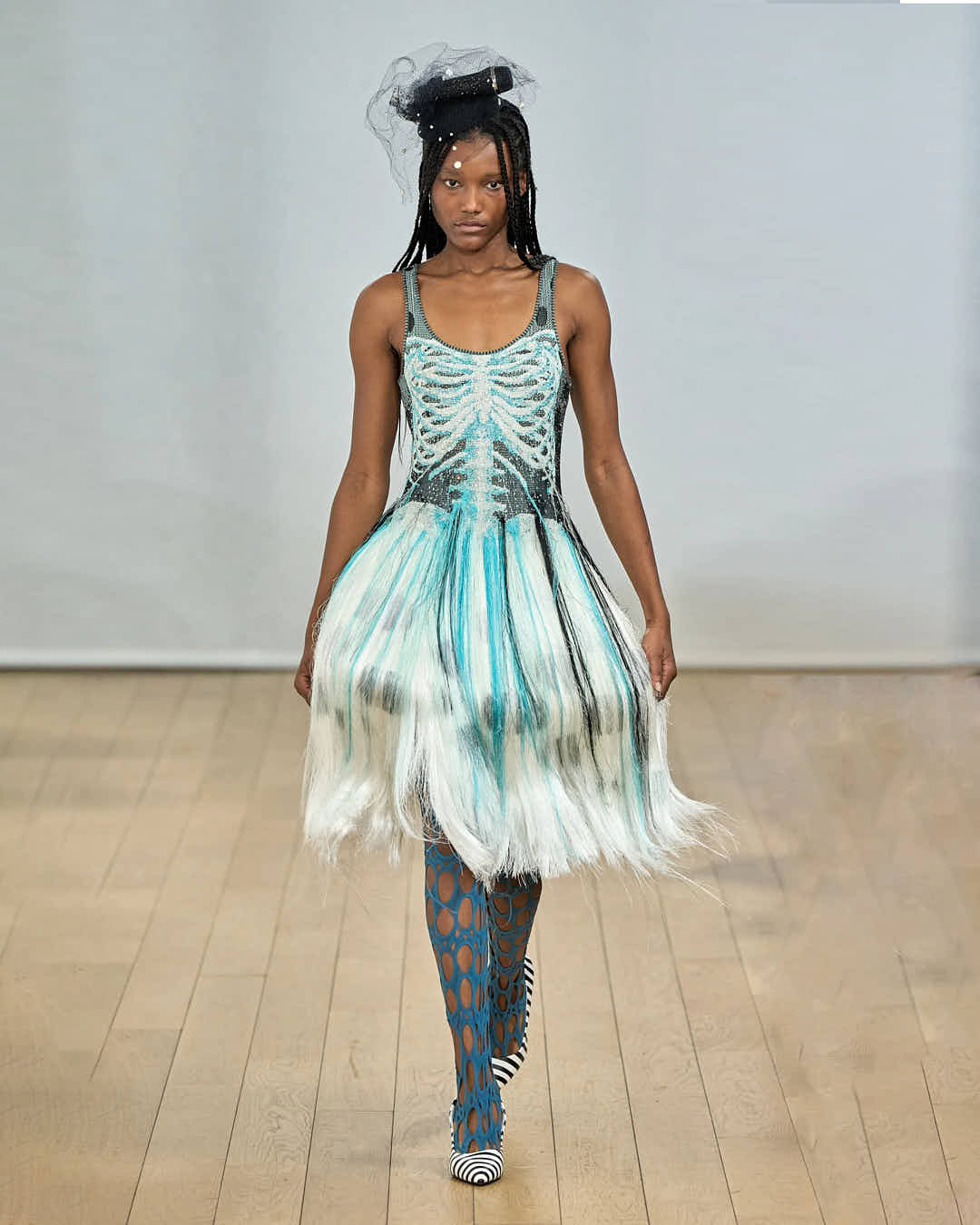
Designs by @chofi4, photographs by Alessandro Lucioni.
Describe your collection in a few (buzz)words.
Sofia Castellon (SC): Mexican American girlbands hit the stage each night in a blaze of fireworks!
Tell us more!
SC: United by rock music, the girls hit the stage each night in a blaze of fireworks, their costumes, defiantly embodying the chaotic, beautifully tangling of these two worlds.
I envision this band performing in a music video: Funeral in the Sky. A plane, struck by an American firework, transforms into a dreamlike stage above the clouds, symbolising a limbo between two. Inspired by the chaotic beauty of Daniel Lezama’s paintings, the collection captures the clash of worlds.
This collection is for those who feel they don’t belong—caught between cultures or worlds, especially in today’s divided political climate. The turbulent relationship between Mexico and the U.S. has become a defining feature of contemporary discourse, marked by walls, immigration bans, and rhetoric that often reduces complex identities to stereotypes. By using satire and vibrant storytelling, the collection directly confronts these reductive narratives, highlighting resilience, cultural fusion, and defiant self-expression.
What was it like bringing this collection to life?
SC: Bringing this collection to life was an intense but incredibly rewarding process. It all started with the development of knitwear techniques—every stitch, every texture, and every material choice played a crucial role in shaping the final pieces. Since I was creating all my own fabrics from scratch, a lot of changes happened along the way, from selecting the right yarns to mending dropped stitches and adjusting colour palettes. Knitwear, by its nature, is a slow fashion process, but working within tight deadlines made it even more challenging. There were so many unpredictable factors, and keeping up with the pace while maintaining the integrity of my designs was tough.
At first, it was daunting to work with so many unknowns, but once I solidified my story and had a clear vision, everything started to flow. I found so much joy in building my own little universe—one that felt personal, meaningful, and reflective of my identity. Working alongside my friends in the studio made the experience even more special; having a strong support system kept me grounded and motivated.
Throughout this process, I learned a lot—most importantly, the value of organisation, the necessity of surrounding yourself with people who believe in you, and, above all, the importance of trusting yourself, no matter how wacky your ideas may seem to others.
What’s next for you?
SC: Next on my journey is taking a well-earned rest and wrapping up my Master’s degree. In April, I’ll be starting my internship, and I’m looking forward to gaining insight into that side of the industry and expanding my skill set. More than anything, I want to keep using fashion as a medium for storytelling—creating work that sparks conversation and spreads messages of unity and hope.
If you could go back to the start of your MA and give yourself one bit of advice now, what would it be?
SC: Chin up, buttercup! It’s all going to be OK! (haha).
If I could go back to the start of my MA, I’d tell myself to trust the process and not stress so much about the unknown. Everything feels impossible at first, but with time, experimentation, and the right support system, things always come together. Also, rest when you need to… burnout doesn’t make better work!
Emilia Seitz, “The Summer that never was”
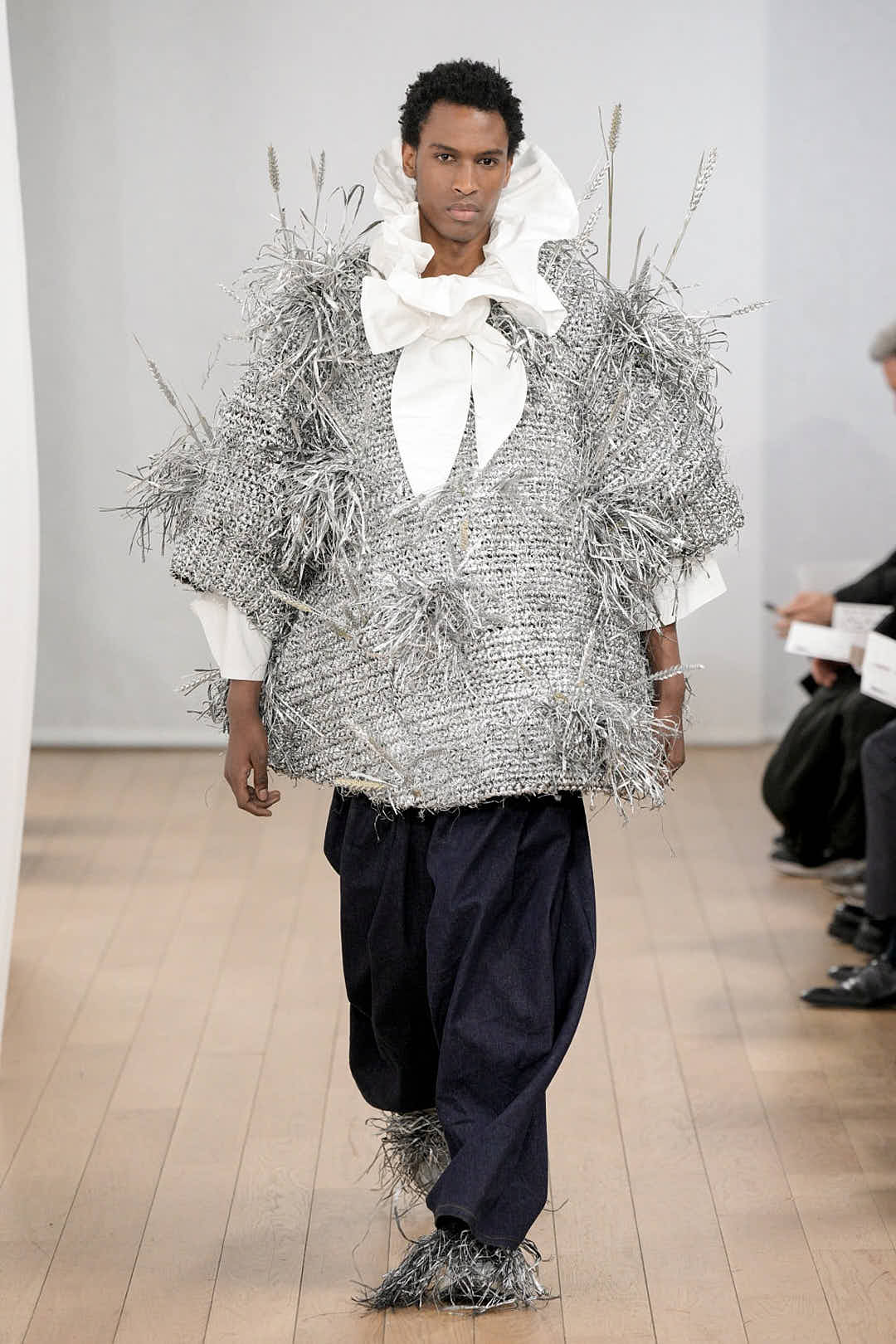
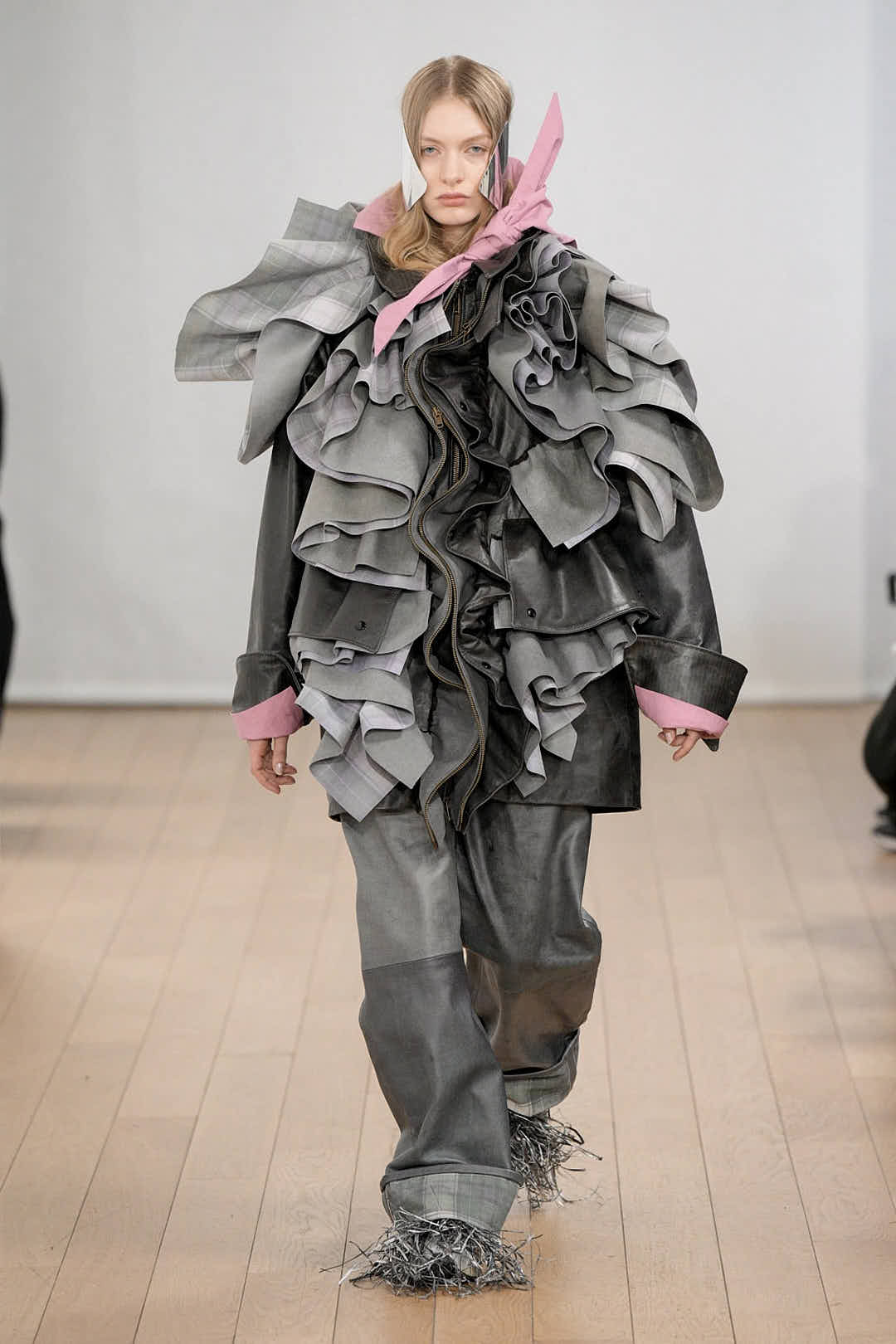
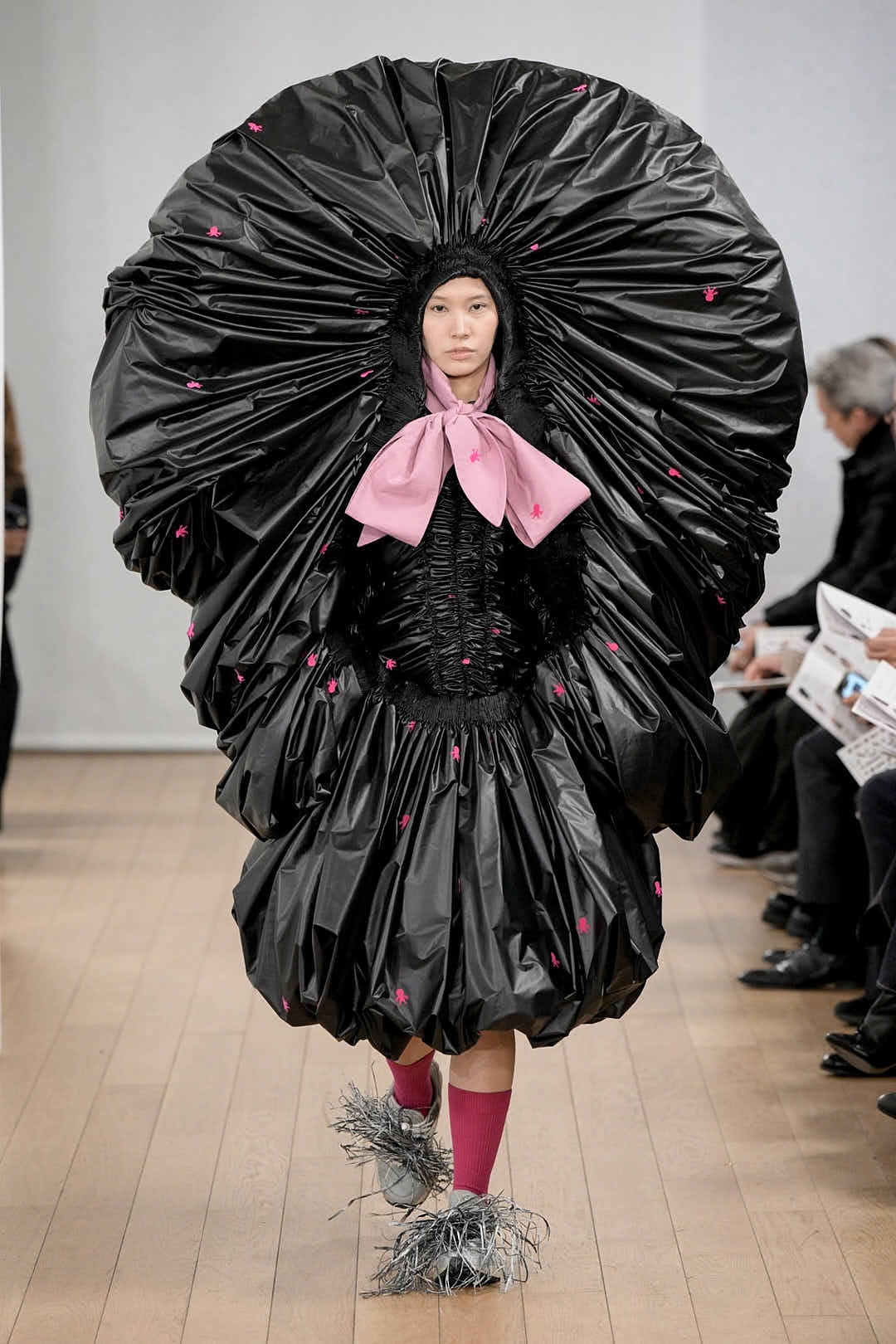
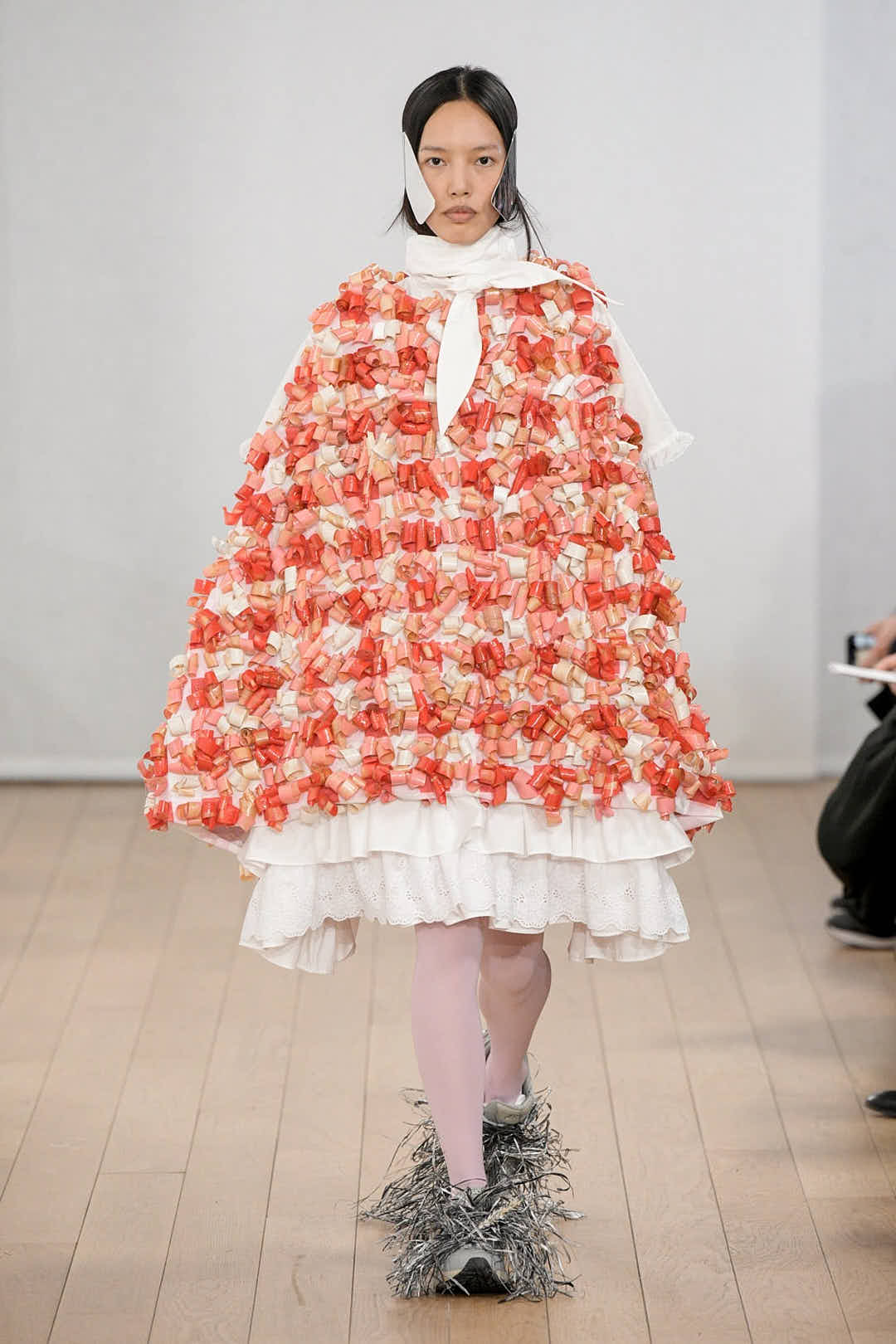
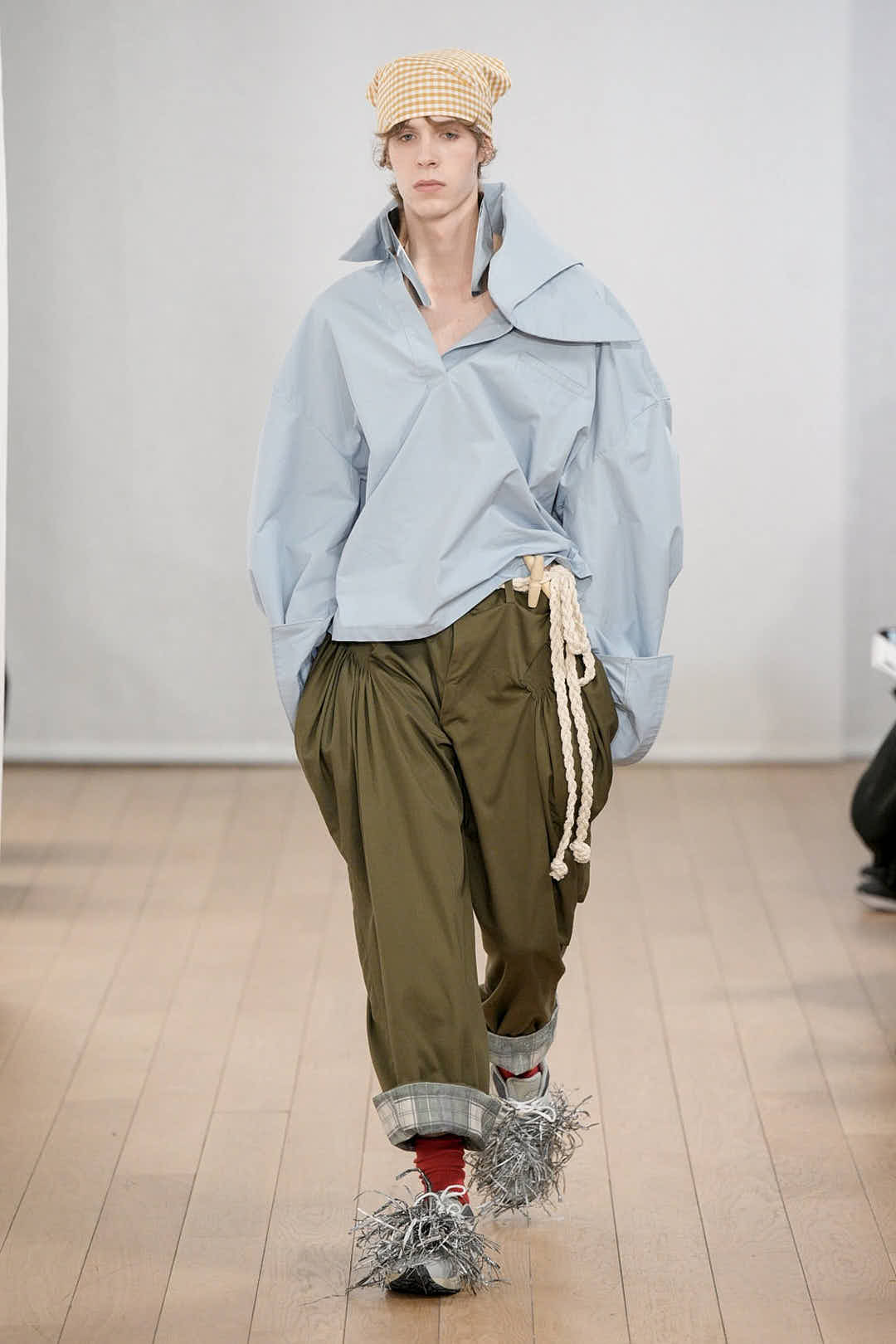
Designs by @emilia.seitz, photographs by @guillaumeroujas.
Describe your collection in a few words.
Emilia Seitz (ES): My collection, “the summer that never was”, distorts childhood archetypes with bold silhouettes and unconventional textures, capturing the blurred, dreamlike nature of childhood memories and the tension between nostalgia and folk traditions.
Tell us more!
ES: My collection is about how childhood memories shift and distort over time. It started with the phantasy of the last summer of being a child and rural romanticism that is in contrast of adult realities.
From there, I reworked archetypal garments that felt nostalgic to me like duffle coats, hunting jackets, and checked dresses, exaggerating their proportions and pushing their textures and materials into something more abstract that feels familiar but at the same time a little off. The same way how memories and emotions change over time. There’s a strong influence from German costume traditions, and dark fairytales that play with the tension between fantasy and reality. My collection puts respect into traditional hand-made craftmanship of smocking, embroidery, crochet or wood-carving techniques that are very time consuming and humbling.
What was it like bringing this collection to life?
ES: To be honest, the process has been incredibly challenging, as the techniques I used were time consuming, and the silhouettes required a high level of expertise in construction. To stay on track, I had to make some sacrifices, but I was fortunate to have amazing help along the way. Throughout this journey, I’ve learned so much, and despite the difficulties, it’s been deeply rewarding. The project was very personal to me, and that connection made all the hard work feel worthwhile.
What’s next for you?
ES: Right now, I am happy to have found an internship and I am looking forward to working in a team and to gaining more work experience. I can imagine building my own brand one day, but for now I am taking a good break!
If you could go back to the start of your MA and give yourself one bit of advice now, what would it be?
ES: Not to take myself too seriously. I have put myself under so much pressure trying to please everyone that I lost myself and the fun in the process. Creativity for me comes from the freedom to let the mind wander and I got stopped a lot by some insecurities. But to be honest this experience was also important for me to learn so maybe everything was right!
Ása Bríet, “Ástandið”
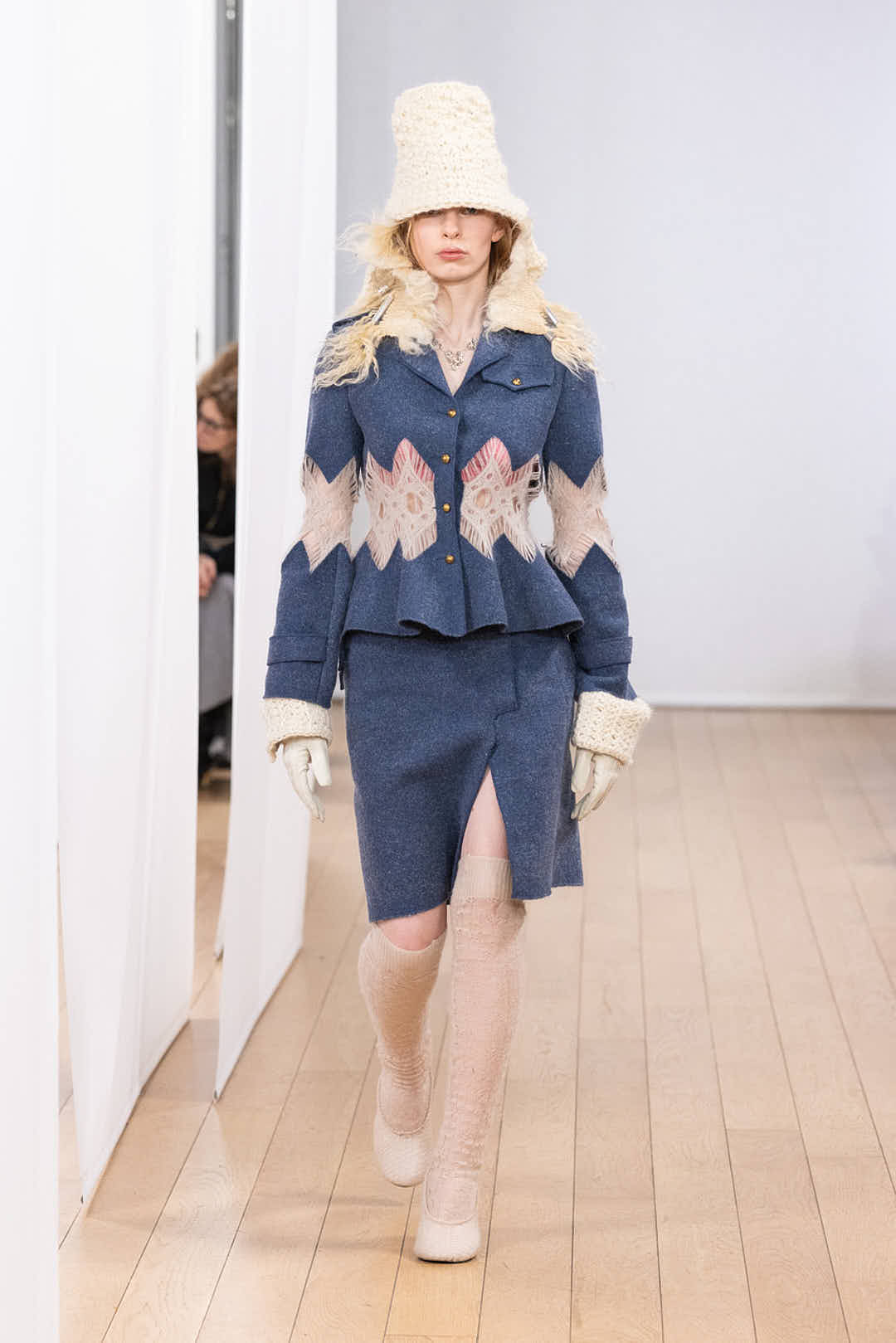
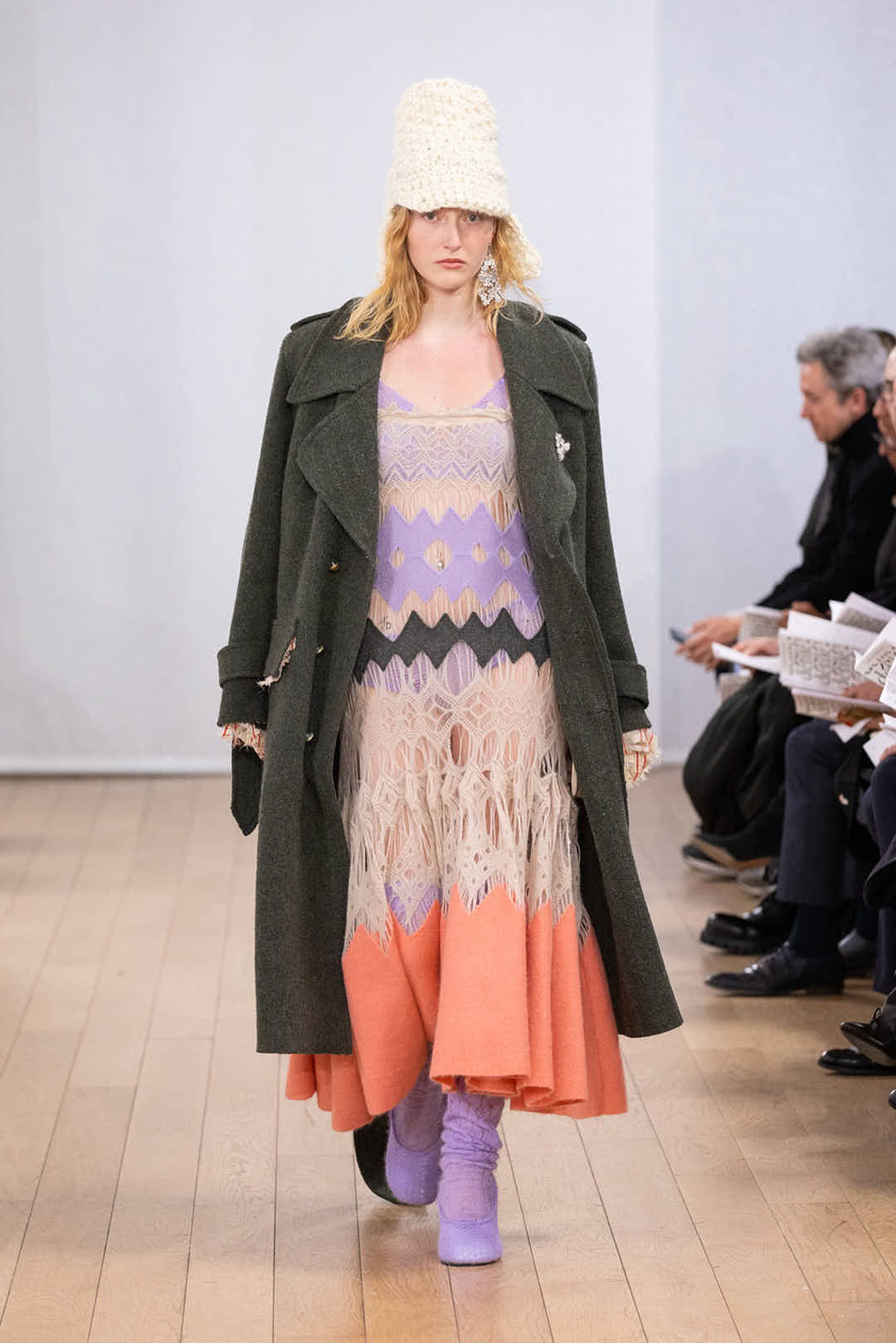
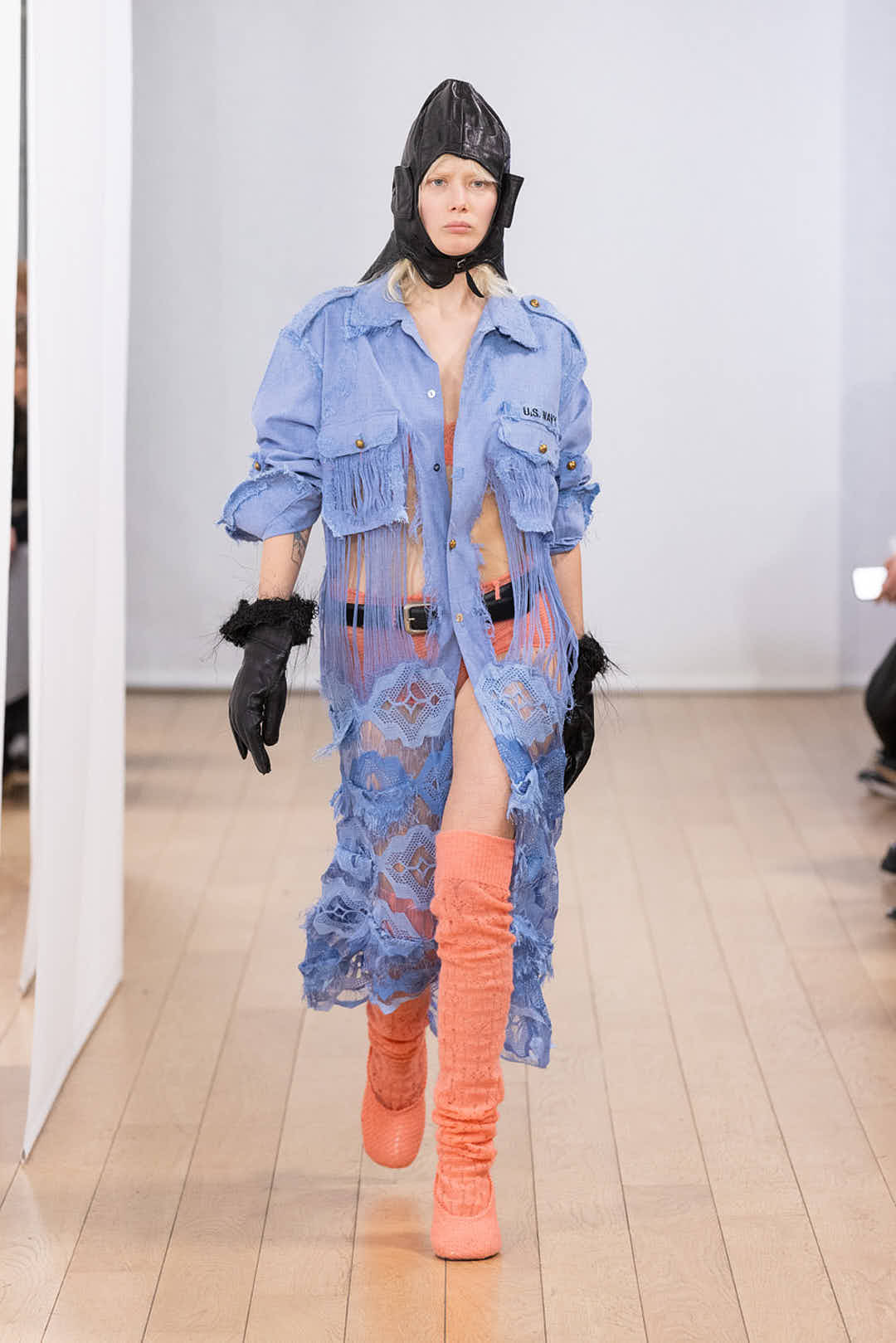
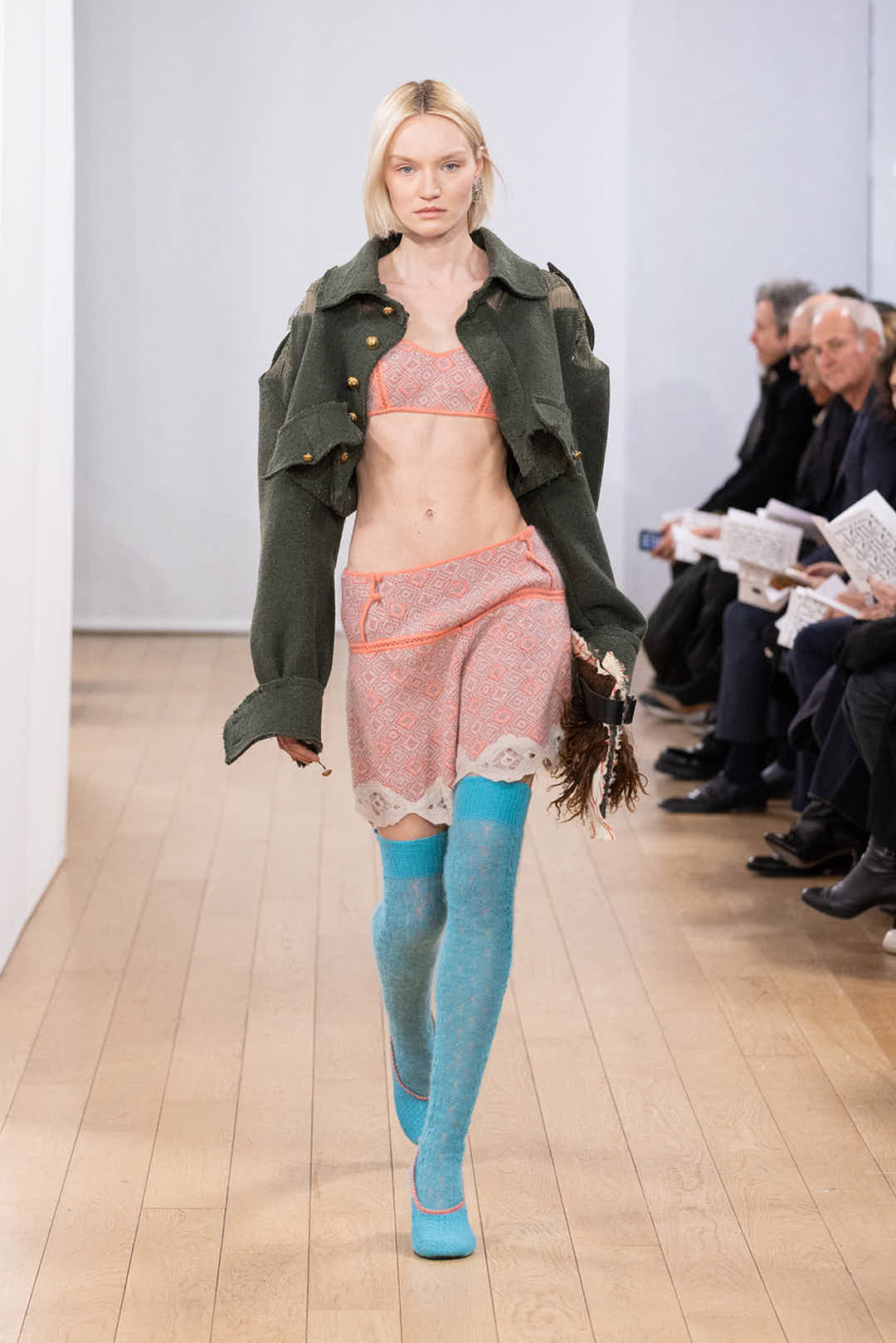
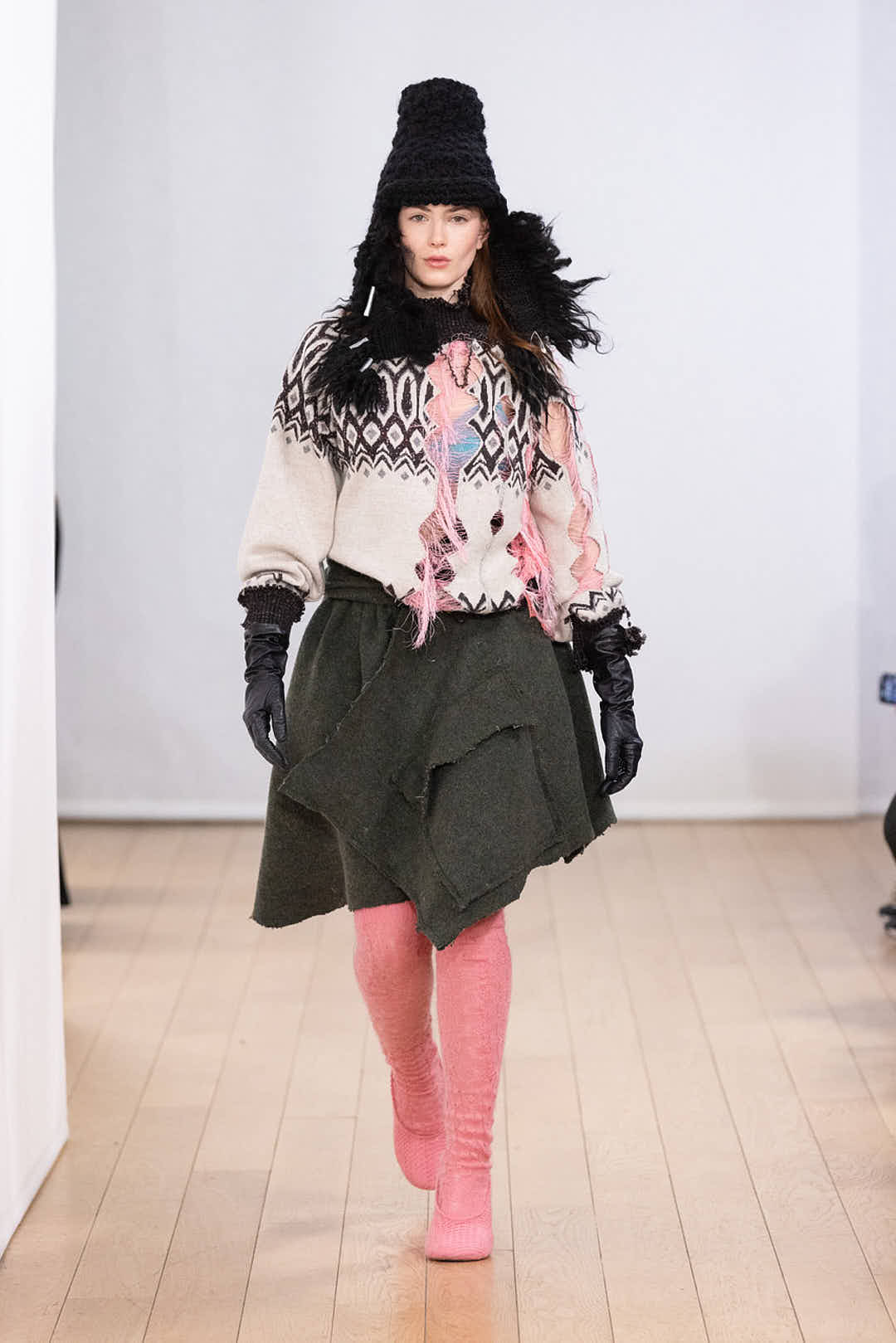
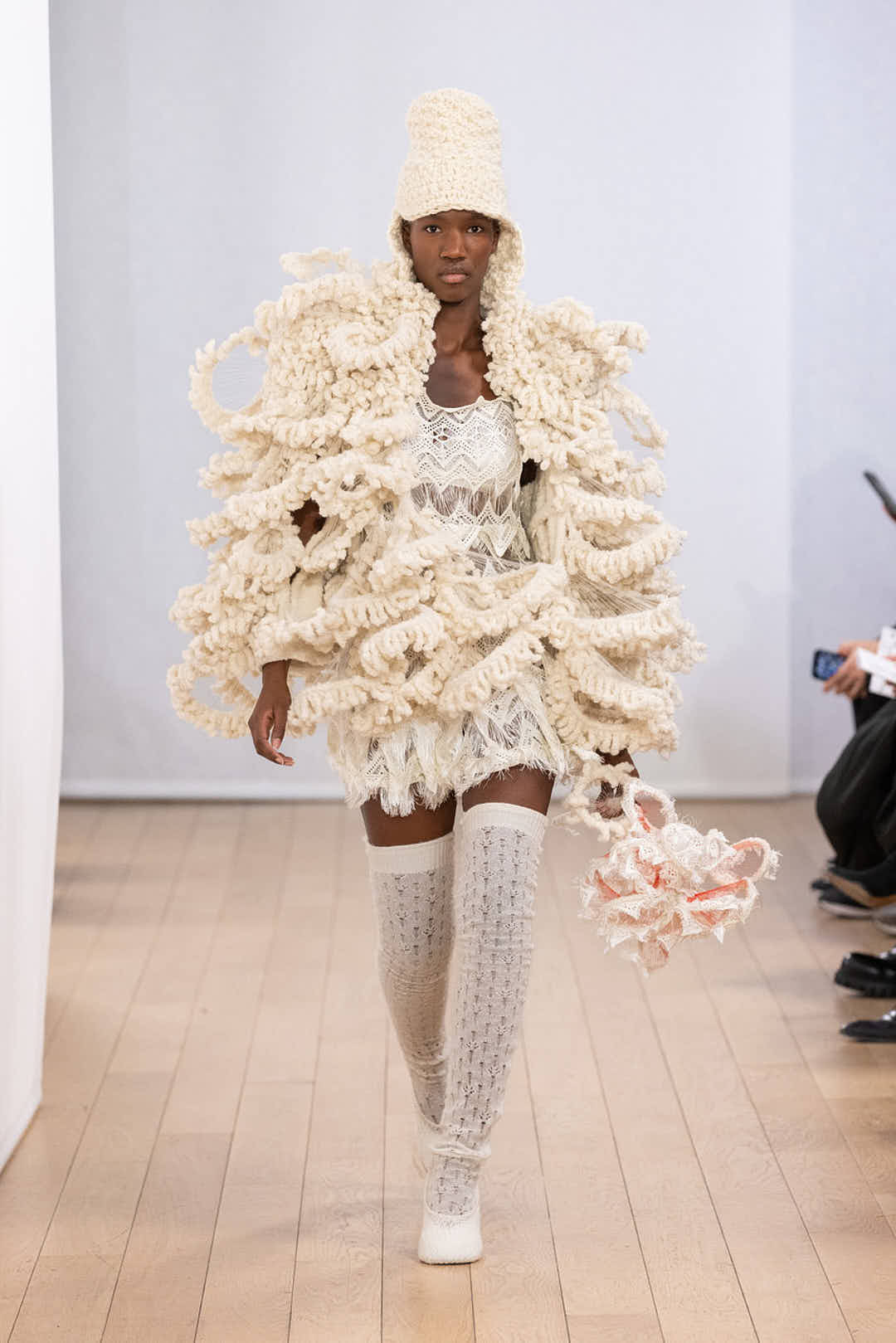
Designs by @asabrietbratta, photographs by @guillaumeroujas.
Describe your collection in a few (buzz)words.
Ása Bríet (AB): The love story between an Icelandic women and U.S. soldiers during World War II in Iceland, torn between passion and societal judgment. stitching memories back together through craft and preservation.
Tell us more!
AB: My MA collection is inspired by Icelandic women during World War II. When the American military set up a base in Iceland, it brought a wave of change. The arrival of young, uniformed soldiers—bearing luxuries like nylon stockings—intrigued many Icelandic women, offering them a glimpse beyond their small-town lives. However, these relationships were met with heavy scrutiny. Women who associated with the soldiers were shamed, accused of betrayal, and even labelled as prostitutes. It was a time of both excitement and conflict, where love and freedom clashed with societal expectations.
At the heart of my collection is a love story between an Icelandic woman and a U.S. soldier. When he departs, all she has left of him is his jacket. As time passes and memories of their love start to fade, so does the jacket—gradually deteriorating, fraying, and falling apart. Yet, driven by her love for craft and preservation, she begins to mend it, piecing it back together stitch by stitch.
This narrative is woven into the garments through a balance of deconstruction and repair. Military-inspired structures unravel and are reassembled through delicate knitwear techniques. The collection explores themes of love, loss, memory, and the act of preserving the past through craftsmanship. Each piece tells a story of something once whole, then broken, and finally restored—echoing the emotions of those left behind when love becomes a memory.
What was it like bringing this collection to life?
AB: I really enjoyed putting this collection together as it is a story that I have wanted to work around for a long time. It is a situation in Iceland that we learn about in elementary school, so it is very well known period of time. I love doing research and I really dived deep at the history library in Iceland as well as talking to a lot of people who remember those times.
What’s next for you?
AB: I’m going to the knitwear team at Hermès for the next six months.
If you could go back to the start of your MA and give yourself one bit of advice now, what would it be?
AB: Its okay to go out one weekend without having to go into the studio.
Ricard Baldomà, “A Pastar Fang”
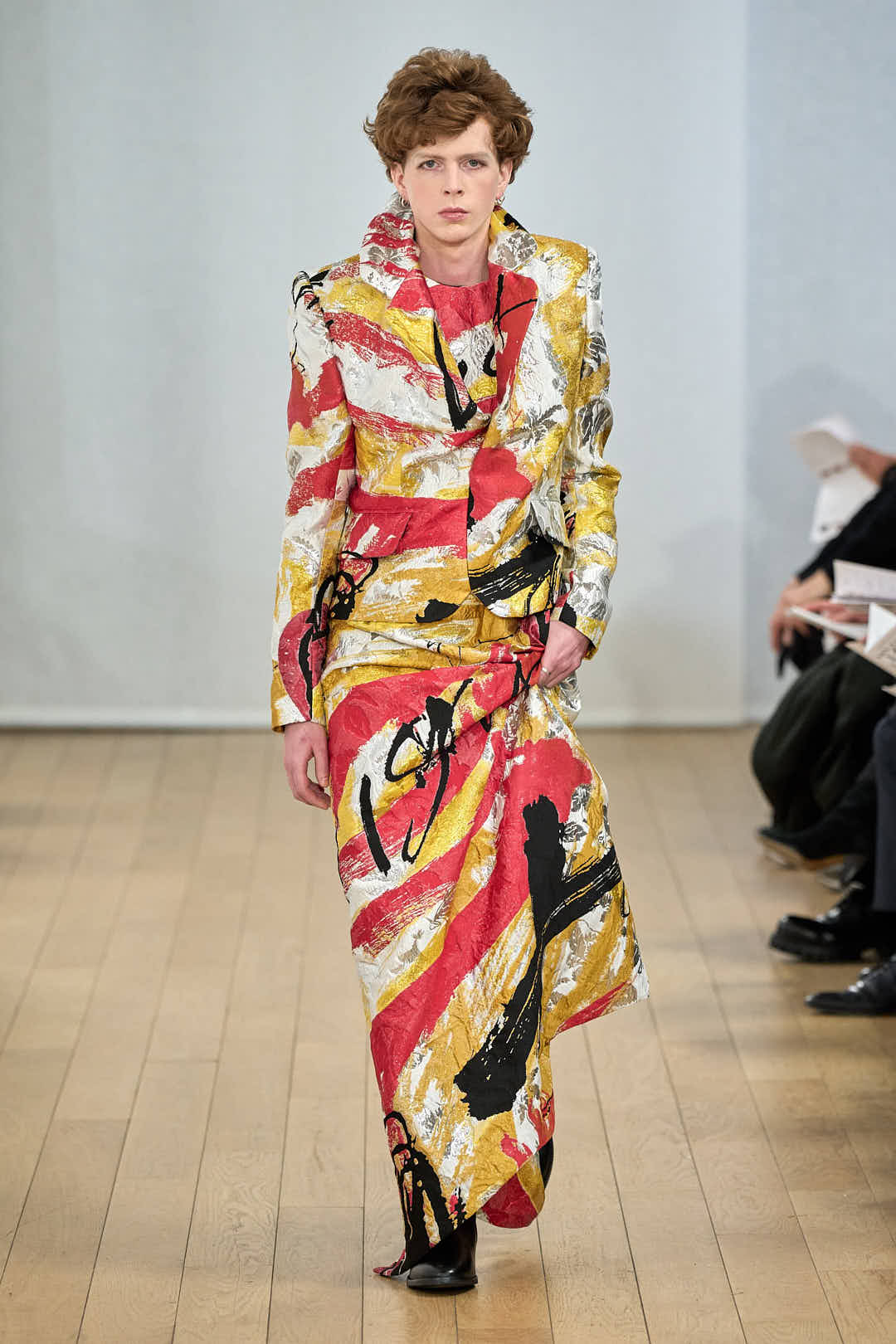
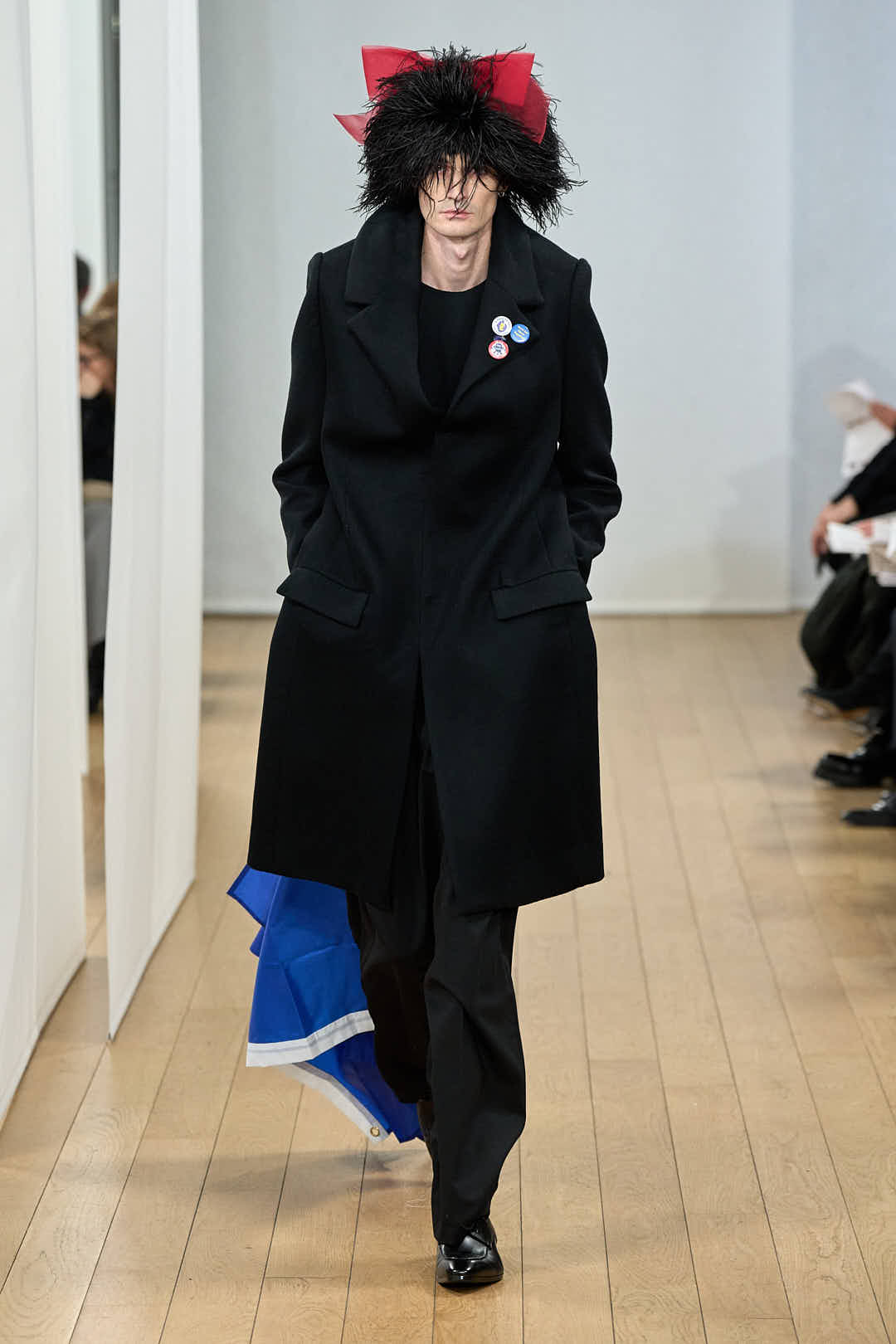
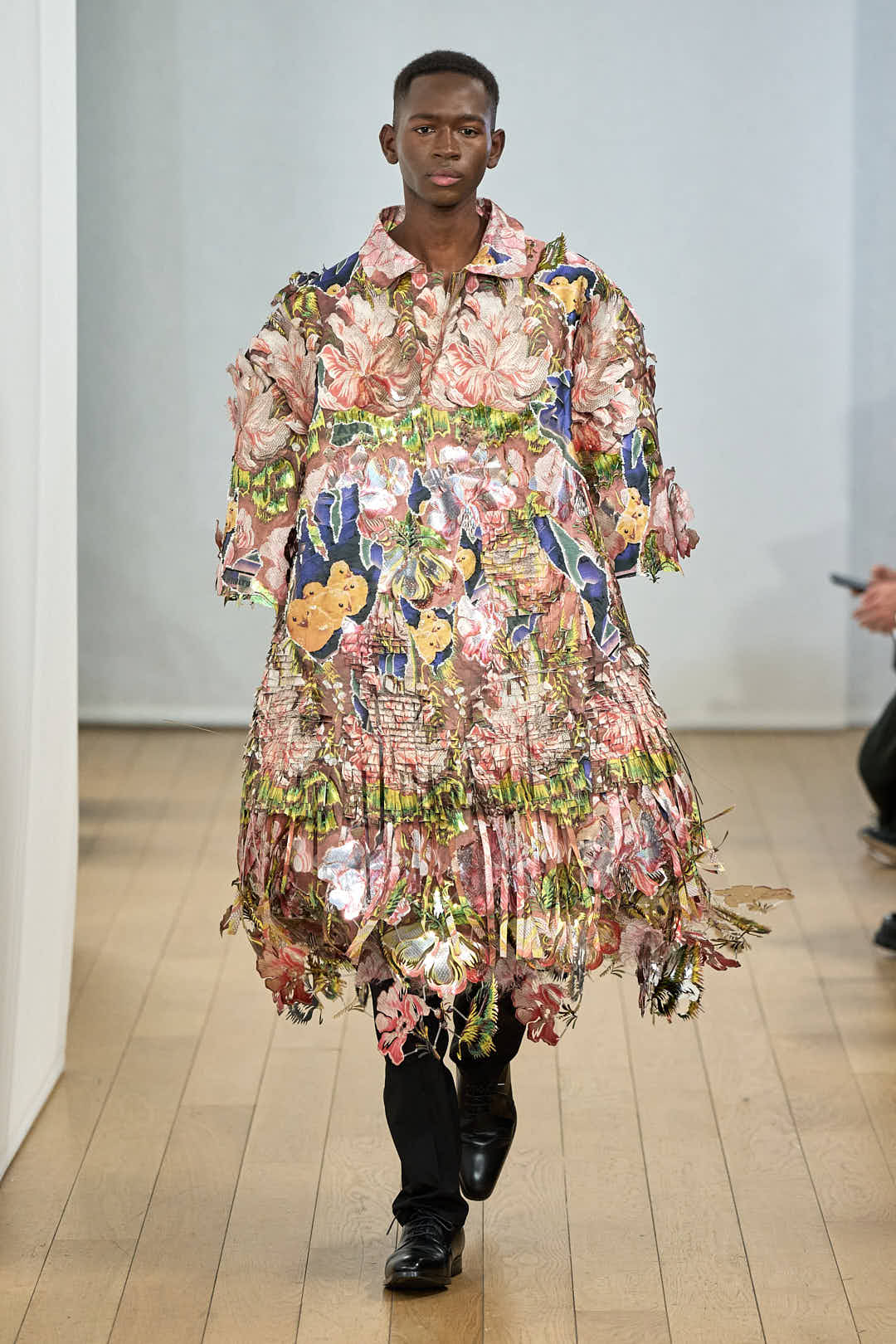
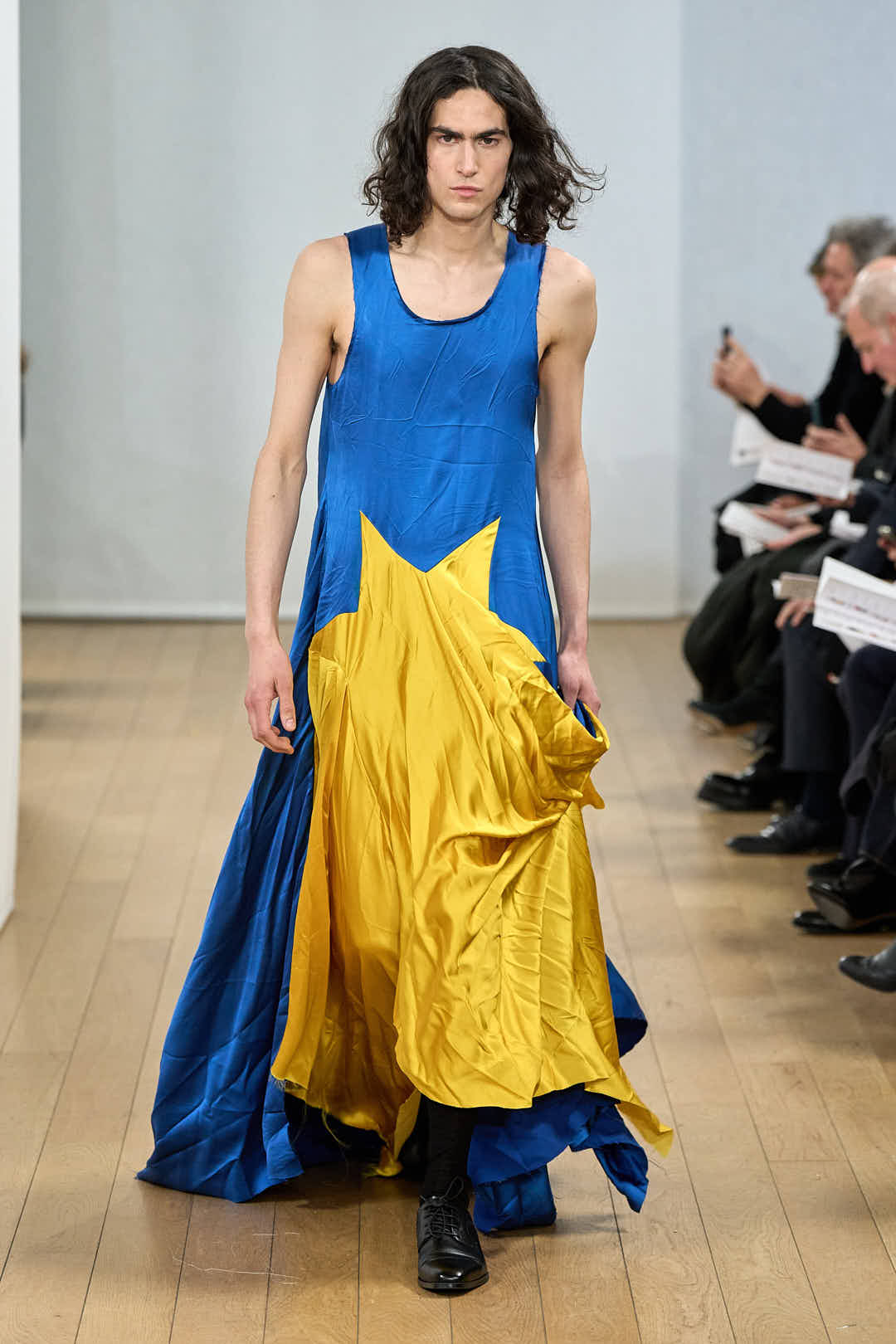
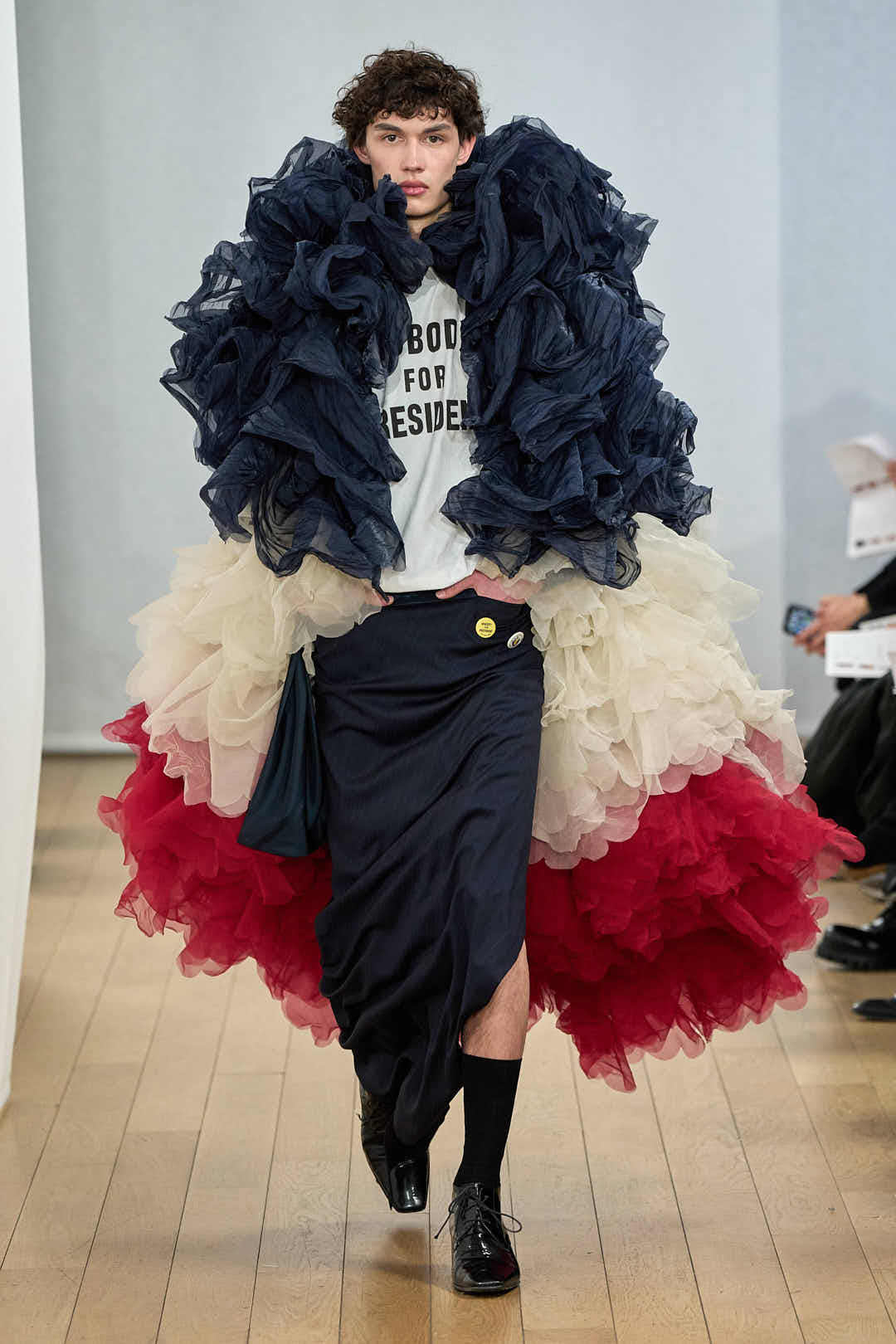
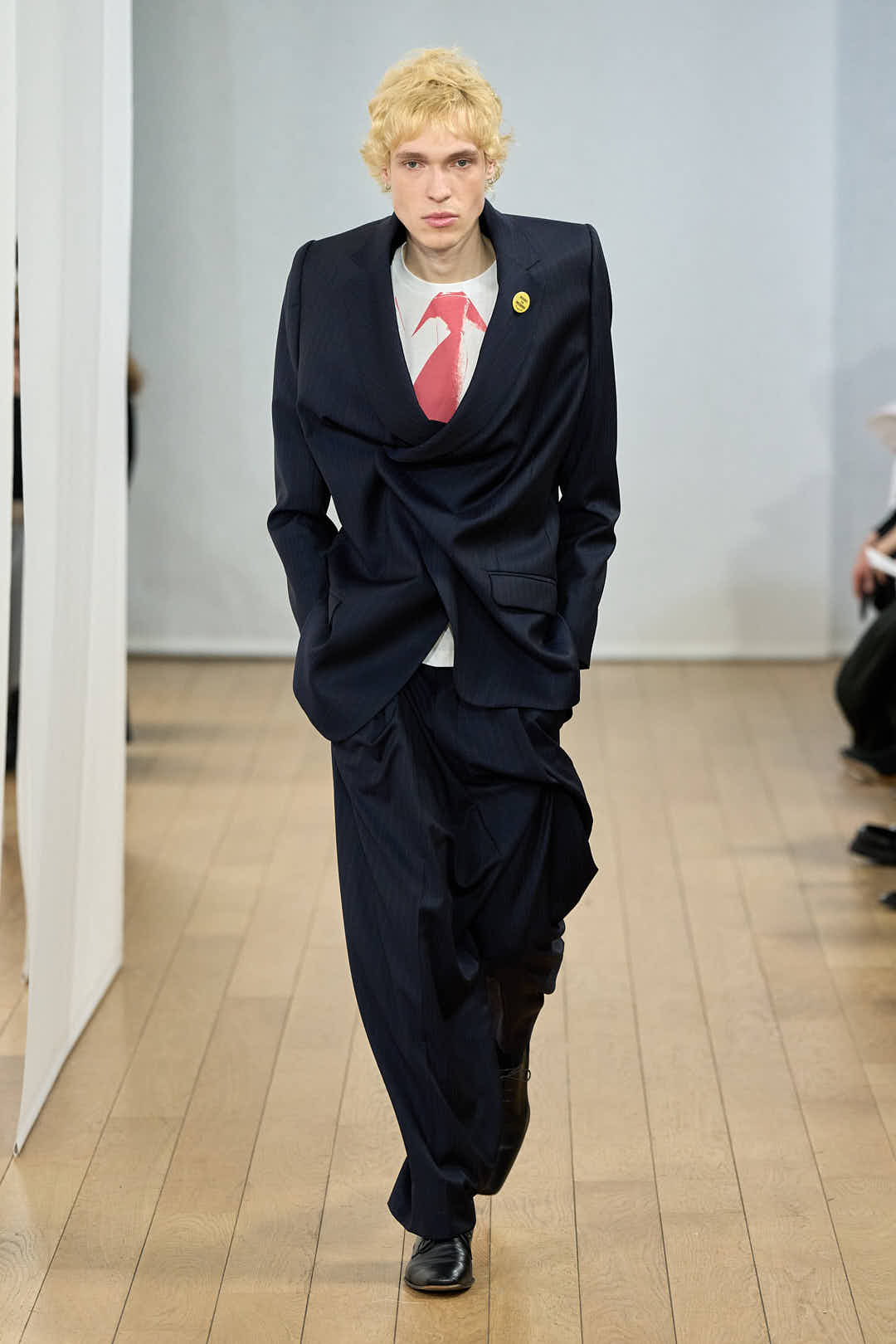
Designs by @ricardbaldomarrosa, photographs by Alessandro Lucioni.
Describe your collection in a few (buzz)words.
Ricard Baldomà (RB): “A Pastar Fang” is a collection that questions the world we were taught to trust and take for granted. It explores the coming of age into politics and the importance taking a stance for what is right amidst the current political landscape.
Tell us more!
RB: The collection explores the archetypes of political formality and revisits them through a comical view, inspired by the cartoon Mafalda and the irreverent and defiant attitude of student movements of the early 1970s around the world.
The anti-fascist abstractions of Catalan artist Antoni Tàpies inform tailored drapes and illusions of formality with trope l’oeil jackets and coats; at the same time, it defaces a recreation of a Margaret Thatcher jacquard. The cultish omnipotence of Catholicism, similar to the MAGA following, inspires a chasuble-like polo shirt, shredded and decaying but still all-powerful and uncomfortably beautiful.
The parallels of the present and the 1972 movie Cabaret are translated into a tricolour boa in shredded silk organza is perfect for the politician as an actor, distracting us as a single European star melts down the crotch of a flag-drape dress.
What was it like bringing this collection to life?
RB: Bringing this collection to live was full of challenges and new experiences.
My main focus in the collection was to create beautifully realised garments, with a strong focus on twisting tailoring and pushing materiality for menswear.
I dived for the first time into embroidery where I developed multiple styles creating my own embellishments and materials and, thanks to the expertise and sponsorship of the Italian company Rilievi, I was able to bring the piece to life. It was definitely a learning curve as there is so much detail, planning and organisation that needs to be put for an embroidered piece, there were plenty of sleepless nights and running around to prepare everything.
Also, I was extremely lucky as another Italian company, Alesilk, agreed to collaborate and help me develop a jacquard for me. I had never designed a fabric before so it was incredibly fun and inspiring to see the different techniques they were able to mix to create such a beautiful fabric.
What’s next for you?
RB: I’m open to whatever the future may bring. To start, I’ll be doing an internship to complete my Master’s, and from there, hopefully begin growing within the industry.
If you could go back to the start of your MA and give yourself one bit of advice now, what would it be?
RB: Probably that time management is key! Organisation is extremely important and, at some point, important decisions have to be made in order to finish a project.
Michael Zhang, “Dreams of the Pink Chamber”
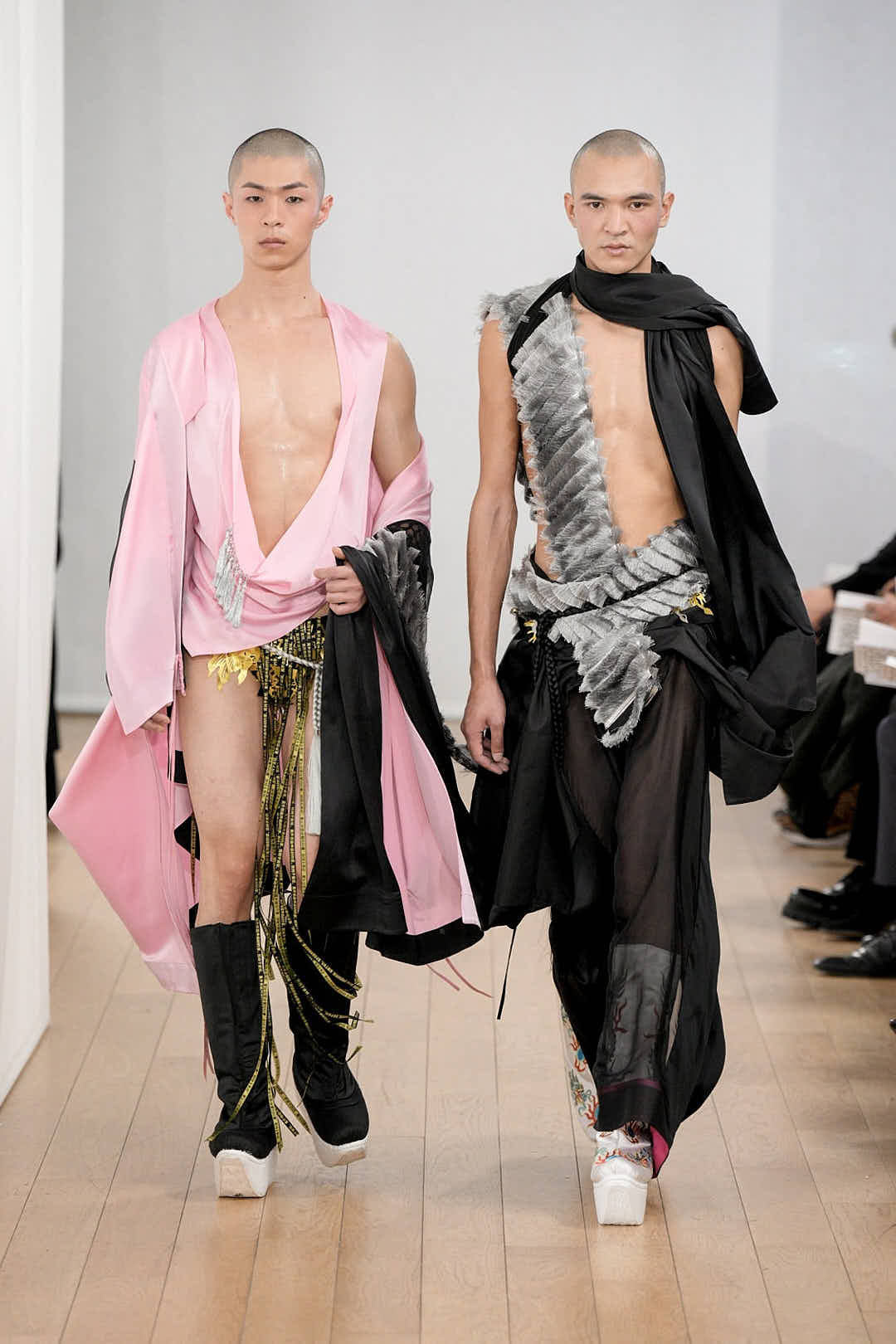
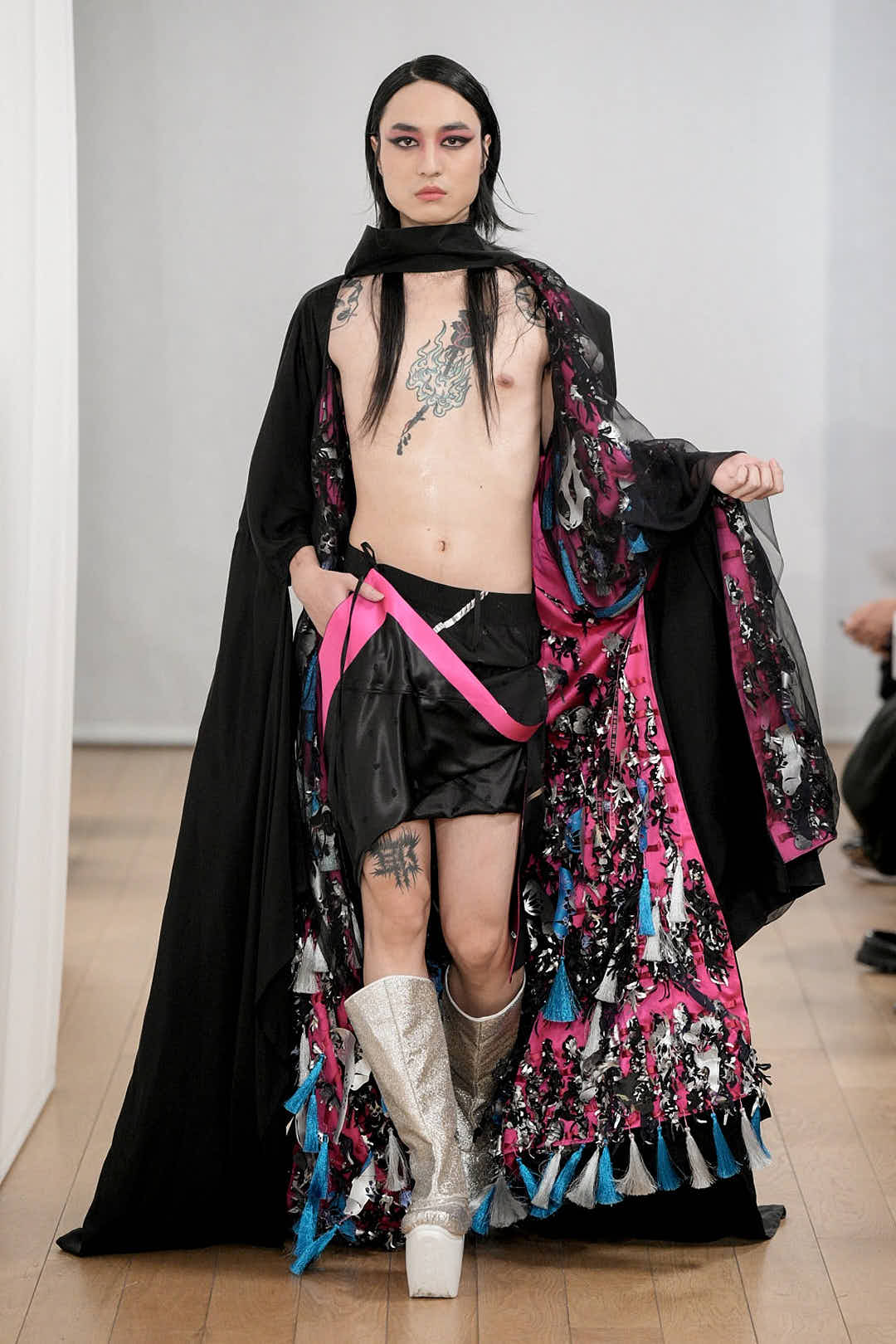
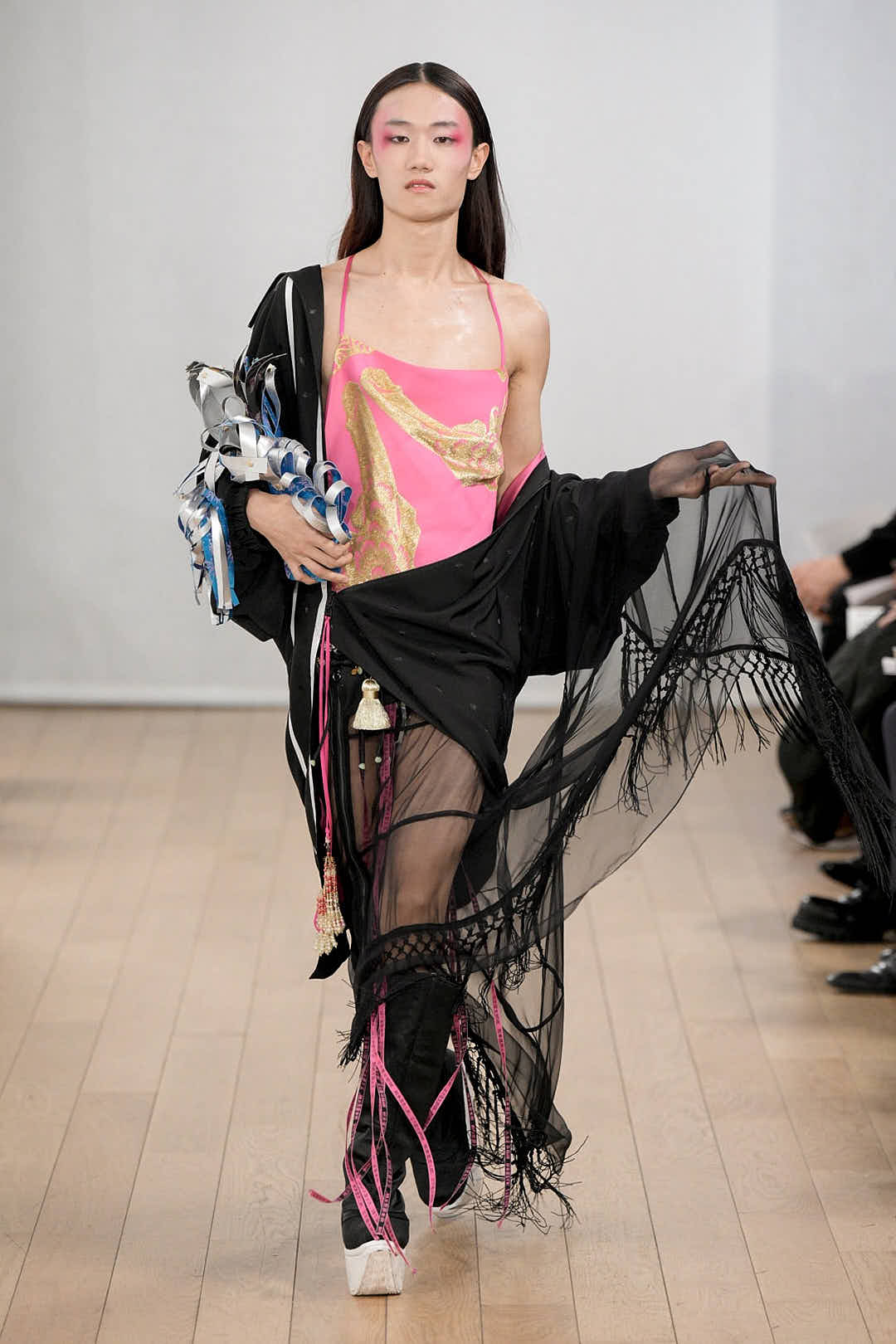
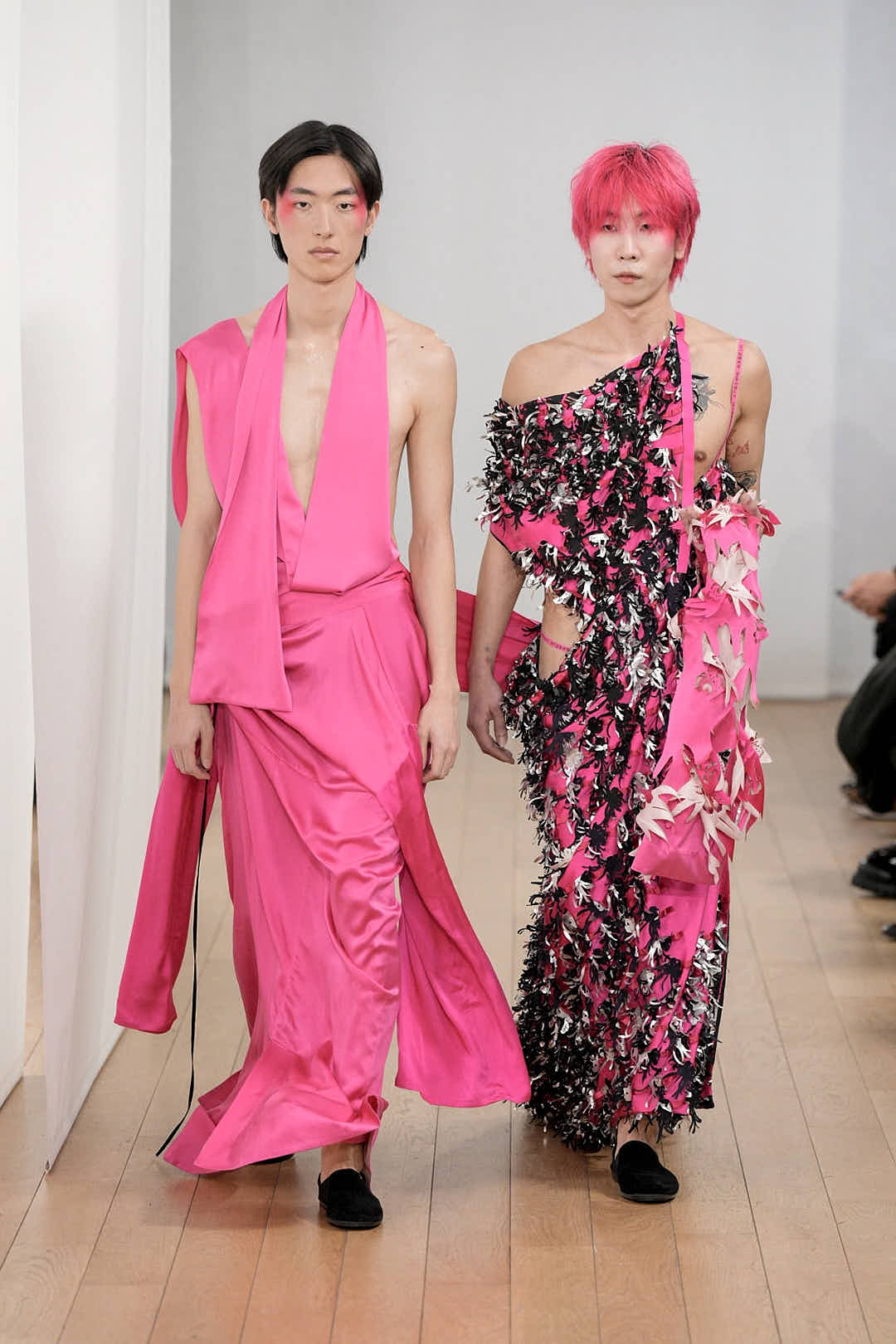
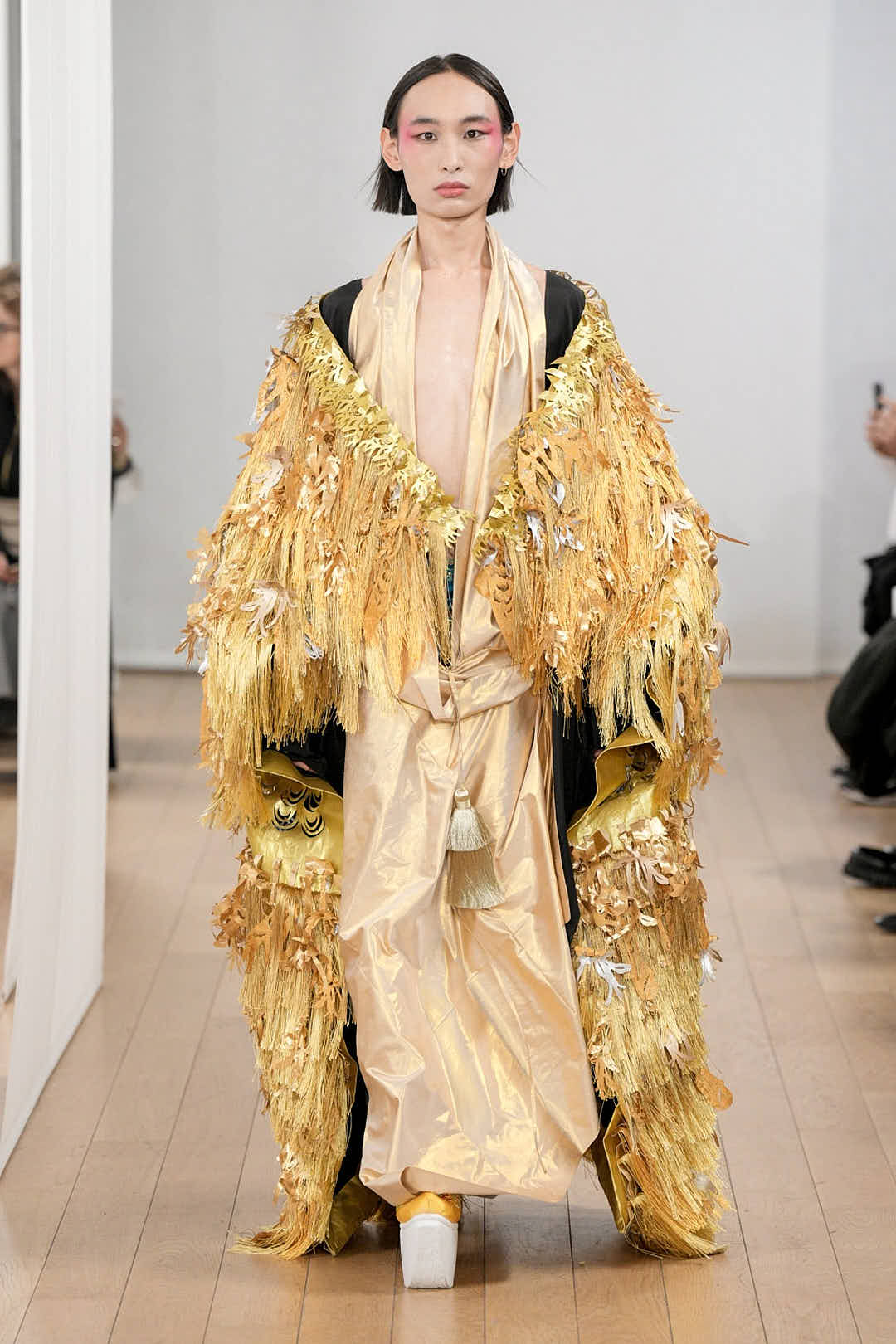
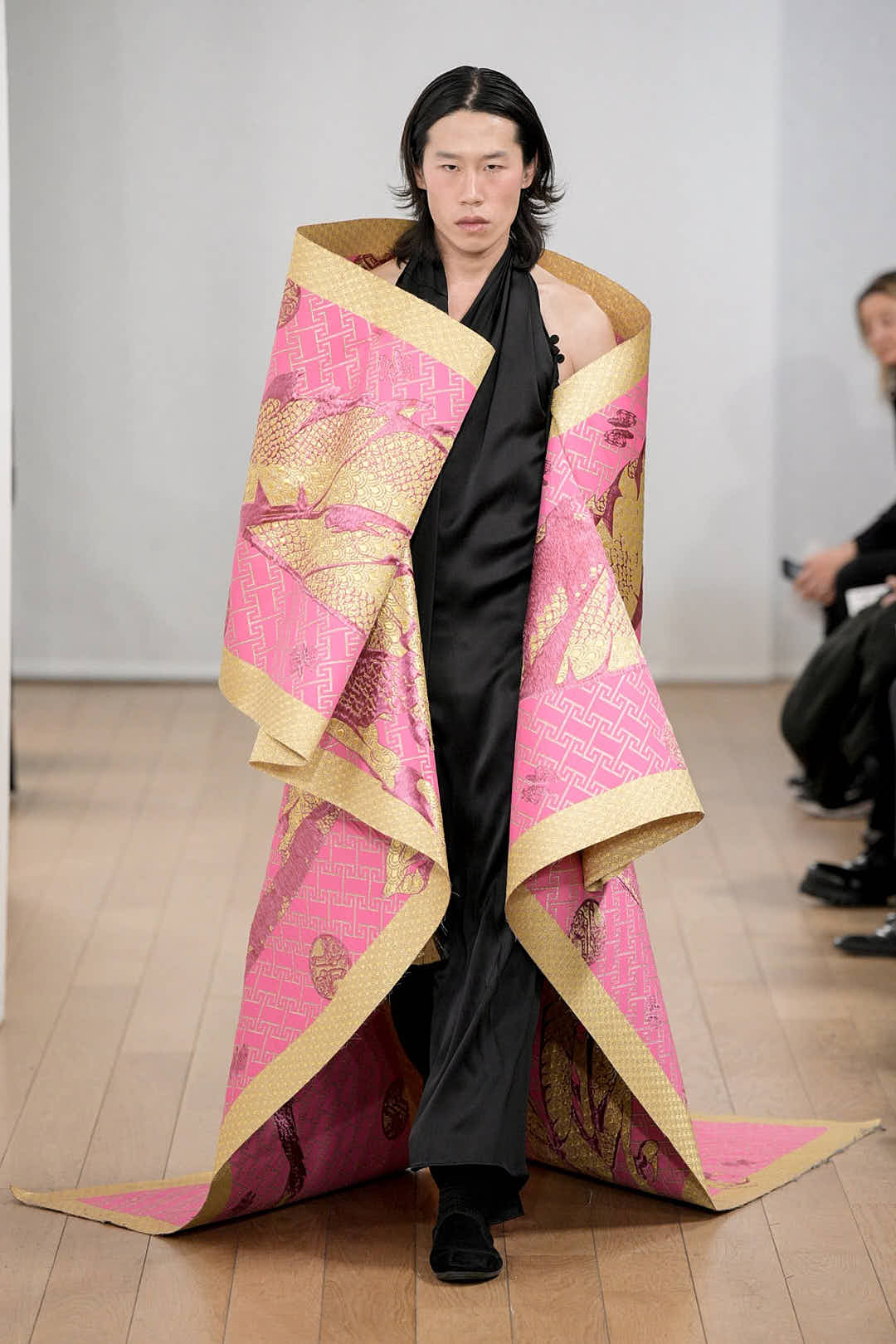
Designs by @michaelyuxiao, photographs by Alessandro Lucioni.
Describe your collection in a few (buzz)words.
Michael Zhang (MZ): A world created from sensuality where signifiers crafts community through culture.
Tell us more!
MZ: My collection questions notions of authenticity and sexuality in “Chinese-ness” and diaspora. A study of textures, drapes, and delicate crafts create a world where signifiers and double meanings mutate and challenge both Western and Eastern perceptions of identity.
Working closely with artist Ding Shilun and my grandmother, I wanted to create community and a catharsis to my own experiences; my collection is a redemption to both my past and the present, questioning who belongs and how we create belonging.
What was it like bringing this collection to life?
MZ: It was definitely challenging to focus on crafts and research which is so personal and oftentimes filled with tradition and the limitations that it brings. It was a fine line to walk between reclaiming my culture but at the same time, voicing authenticity and sexuality. On the other hand, it was powerful to be able to show work, which is not necessarily always rooted in Western traditions. I think there is a beauty in diversity and by bringing my friends who reflected my vision such as Gary Chen and Wudi Tan who modelled for me in the final show to express this, it was a beautiful homage to community built from culture.
What’s next for you?
MZ: I am beginning work as a ready-to-wear assistant designer at Balenciaga, we’ll see where the future takes me.
If you could go back to the start of your MA and give yourself one bit of advice now, what would it be?
MZ: If I could go back, I would definitely tell myself to take time and breathe (haha!). Sometimes it’s hard because it is such a whirlwind experience with so much to do in such a short time, but it was worth it in the end.

